ALMA 2018-2011
Astronomy and Telescopes
ALMA Imagery in the Period 2018-2011
• December 20, 2018: As comet 46P/Wirtanen neared Earth on December 2, astronomers using ALMA took a remarkably close look the innermost regions of the comet's coma, the gaseous envelope around its nucleus. ALMA imaged the comet when it was approximately 16.5 million kilometers from Earth. At its closet on 16 December, the comet – one of the brightest in years — was approximately 11.6 million kilometers from Earth, or about 30 times the distance from the Earth to the moon. 1)
- "This comet is causing a stir in the professional and amateur astronomy communities due to its combined brightness and proximity, which allows us to study it in unprecedented detail" said NASA's Martin Cordiner, who led the team that made the ALMA observations. "As the comet drew nearer to the Sun, its icy body heated up, releasing water vapor and various other particles stored inside, forming the characteristic puffed-up coma and elongated tail."
- The ALMA image of comet 46P/Wirtanen zooms-in to very near its nucleus – the solid "dirty snowball" of the comet itself — to image the natural millimeter-wavelength "glow" emitted by molecules of hydrogen cyanide (HCN), a simple organic molecule that forms an ethereal atmosphere around the comet. ALMA, using its remarkable ability to see fine details, was able to detect and image the fine-scale distribution of this particular molecule.
- The HCN image shows a compact region of gas and an extended, diffuse, and somewhat asymmetrical, pattern in the inner portion of the coma. Due to the extreme proximity of this comet, most of the extended coma is resolved out, so these observations are only sensitive to the innermost regions, in the immediate vicinity of the nucleus.
- The astronomers also performed observations of more complex molecules on 9 December, when the comet was 13.6 million kilometers from Earth.
- Comet 46P/Wirtanen orbits the Sun once every 5.5 years, which is remarkably brisk compared to its more famous cousin Halley's Comet, which has an orbital period of about 75 years. Other bright comets can have periods that are on the order of hundreds and even thousands of years. The comet may yet be visible to the naked eye.
- For comparison, an optical view of the comet taken by an amateur astrophotographer is shown (Figure 1 right). Though they appear to be similar, the ALMA image spans an area of the sky only about 5 arcseconds – about 1000 times smaller than the optical image – meaning ALMA is looking at the very fine-scale features in the coma.
- This and previous observations of comets with ALMA confirm that they are rich in organic molecules, and may therefore have seeded the early Earth with the chemical building blocks of life.
- The National Radio Astronomy Observatory is a facility of the National Science Foundation, operated under cooperative agreement by Associated Universities, Inc.

• December 17, 2018: Researchers from RIKEN (Institute of Physical and Chemical Research, Tokyo, Japan) have used observations from ALMA (Atacama Large Millimeter/submillimeter Array) to measure the strength of magnetic fields near two supermassive black holes at the center of an important group of active galaxies. Surprisingly, the strengths of the magnetic fields do not appear sufficient to power the coronae, clouds of superheated plasma, that are observed around the black holes at the centers of those galaxies. 2)
- It has long been known that the supermassive black holes that lie at the centers of galaxies, sometimes outshining their host galaxies, have coronae of superheated plasma around them, like the Sun. For black holes, these coronae can be heated to a phenomenal temperature of one billion degrees Celsius. It was long assumed that, like that of the Sun, the coronae were heated by magnetic field energies. However, these magnetic fields had never been measured, leaving uncertainty regarding the exact mechanism.
- In a 2014 paper, the research group predicted that electrons in the plasma surrounding the black holes would emit a special kind of light, known as synchrotron radiation, as they exist together with the magnetic forces in the coronae. Specifically, this radiation would be in the radio band, meaning light with a very long wavelength and low frequency. And the group set out to measure the fields.
- They decided to look at data from two "nearby"—in astronomical terms—active galactic nuclei—IC 4329A, which is about 200 million light years away, and NGC 985, which is approximately 580 million light years away. They began by taking measurements from the ALMA observatory in Chile, and then compared them to observations from two other radio telescopes: the VLA (Very Large Array) observatory in the United States, and the ATCA (Australia Telescope Compact Array) observatory in Australia, which measure slightly different bands; and found indeed that there was an excess of radio emission originating from synchrotron radiation, in addition to emissions from the jets case out by the black holes.
- Through the observations, the team deduced that the coronaehad a size of about 40 Schwartzchild radii (the radius of a black hole from which not even light can escape), and a strength of about 10 gauss, a figure that is a bit more than the magnetic field at the surface of the earth but quite a bit less than that given out by a typical refrigerator magnet.
- "The surprise," says Yoshiyuki Inoue, the first author of the paper, "is that although we confirmed the emission of radio synchrotron radiation from the coronaein both objects, it turns out that the field of the magnetic field we measured is much too weak to be able to drive the intense heating of the coronaearound these black holes." He also notes that the same phenomenon was observed in both galaxies, implying that it could be a general phenomenon. 3)
- Looking to the future, Inoue says that the group plans to look for signs of powerful gamma rays that should accompany the radio emissions, to further understand what is happening in the environment near supermassive black holes.

• December 12, 2018: Astronomers have cataloged nearly 4,000 exoplanets in orbit around distant stars. Though the discovery of these newfound worlds has taught us much, there is still a great deal we do not know about the birth of planets and the precise cosmic recipes that spawn the wide array of planetary bodies we have already uncovered, including so-called hot Jupiters, massive rocky worlds, icy dwarf planets, and – hopefully someday soon – distant analogs of Earth. 4)
- To help answer these and other intriguing questions, a team of astronomers has conducted ALMA‘s first large-scale, high-resolution survey of protoplanetary disks, the belts of dust and gas around young stars.
- Known as the DSHARP (Disk Substructures at High Angular Resolution Project), this "Large Program" of ALMA (Atacama Large Millimeter/submillimeter Array) has yielded stunning, high-resolution images of 20 nearby protoplanetary disks and given astronomers new insights into the variety of features they contain and the speed with which planets can emerge.
- The results of this survey will appear in a special focus issue of the Astrophysical Journal Letters.
- According to the researchers, the most compelling interpretation of these observations is that large planets, likely similar in size and composition to Neptune or Saturn, form quickly, much faster than current theory would allow. Such planets also tend to form in the outer reaches of their solar systems at tremendous distances from their host stars.
- Such precocious formation could also help explain how rocky, Earth-size worlds are able to evolve and grow, surviving their presumed self-destructive adolescence.
- "The goal of this months-long observing campaign was to search for structural commonalities and differences in protoplanetary disks. ALMA's remarkably sharp vision has revealed previously unseen structures and unexpectedly complex patterns," said Sean Andrews, an astronomer at the Harvard-Smithsonian Center for Astrophysics (CfA) and a leader of the ALMA observing campaign along with Andrea Isella of Rice University, Laura Pérez of the University of Chile, and Cornelis Dullemond of Heidelberg University. "We are seeing distinct details around a wide assortment of young stars of various masses. The most compelling interpretation of these highly diverse, small-scale features is that there are unseen planets interacting with the disk material."
- The leading models for planet formation hold that planets are born by the gradual accumulation of dust and gas inside a protoplanetary disk, beginning with grains of icy dust that coalesce to form larger and larger rocks, until asteroids, planetesimals, and planets emerge. This hierarchical process should take many millions of years to unfold, suggesting that its impact on protoplanetary disks would be most prevalent in older, more mature systems. Mounting evidence, however, indicates that is not always the case.
- ALMA's early observations of young protoplanetary disks, some only about one million years old, reveal surprisingly well-defined structures, including prominent rings and gaps, which appear to be the hallmarks of planets. Astronomers were initially cautious to ascribe these features to the actions of planets since other natural process could be at play.
- "It was surprising to see possible signatures of planet formation in the very first high-resolution images of young disks. It was important to find out whether these were anomalies or if those signatures were common in disks," said Jane Huang, a graduate student at CfA and a member of the research team.

- Since the initial sample of disks that astronomers could study was so small, however, it was impossible to draw any overarching conclusions. It could have been that astronomers were observing atypical systems. More observations on a variety of protoplanetary disks were needed to determine the most likely causes of the features they were seeing.
- The DSHARP campaign was designed to do precisely that by studying the relatively small-scale distribution of dust particles around 20 nearby protoplanetary disks. These dust particles naturally glow in millimeter-wavelength light, enabling ALMA to precisely map the density distribution of small, solid particles around young stars.
- Depending on the star's distance from Earth, ALMA was able to distinguish features as small as a few Astronomical Units. (An Astronomical Unit is the average distance of the Earth to the Sun – about 150 million kilometers, which is a useful scale for measuring distances on the scale of star systems). Using these observations, the researchers were able to image an entire population of nearby protoplanetary disks and study their AU-scale features.
- The researchers found that many substructures – concentric gaps, narrow rings – are common to nearly all the disks, while large-scale spiral patterns and arc-like features are also present in some of the cases. Also, the disks and gaps are present at a wide range of distances from their host stars, from a few AU to more than 100 AU, which is more than three times the distance of Neptune from our Sun.
- These features, which could be the imprint of large planets, may explain how rocky Earth-like planets are able to form and grow. For decades, astronomers have puzzled over a major hurdle in planet-formation theory: Once dusty bodies grow to a certain size – about one centimeter in diameter – the dynamics of a smooth protoplanetary disk would induce them to fall in on their host star, never acquiring the mass necessary to form planets like Mars, Venus, and Earth.
- The dense rings of dust we now see with ALMA would produce a safe haven for rocky worlds to fully mature. Their higher densities and the concentration of dust particles would create perturbations in the disk, forming zones where planetesimals would have more time to grow into fully fledged planets.
- "When ALMA truly revealed its capabilities with its iconic image of HL Tau, we had to wonder if that was an outlier since the disk was comparatively massive and young," noted Laura Perez with the University of Chile and a member of the research team. "These latest observations show that, though striking, HL Tau is far from unusual and may actually represent the normal evolution of planets around young stars."
- The National Radio Astronomy Observatory is a facility of the National Science Foundation, operated under cooperative agreement by Associated Universities, Inc.
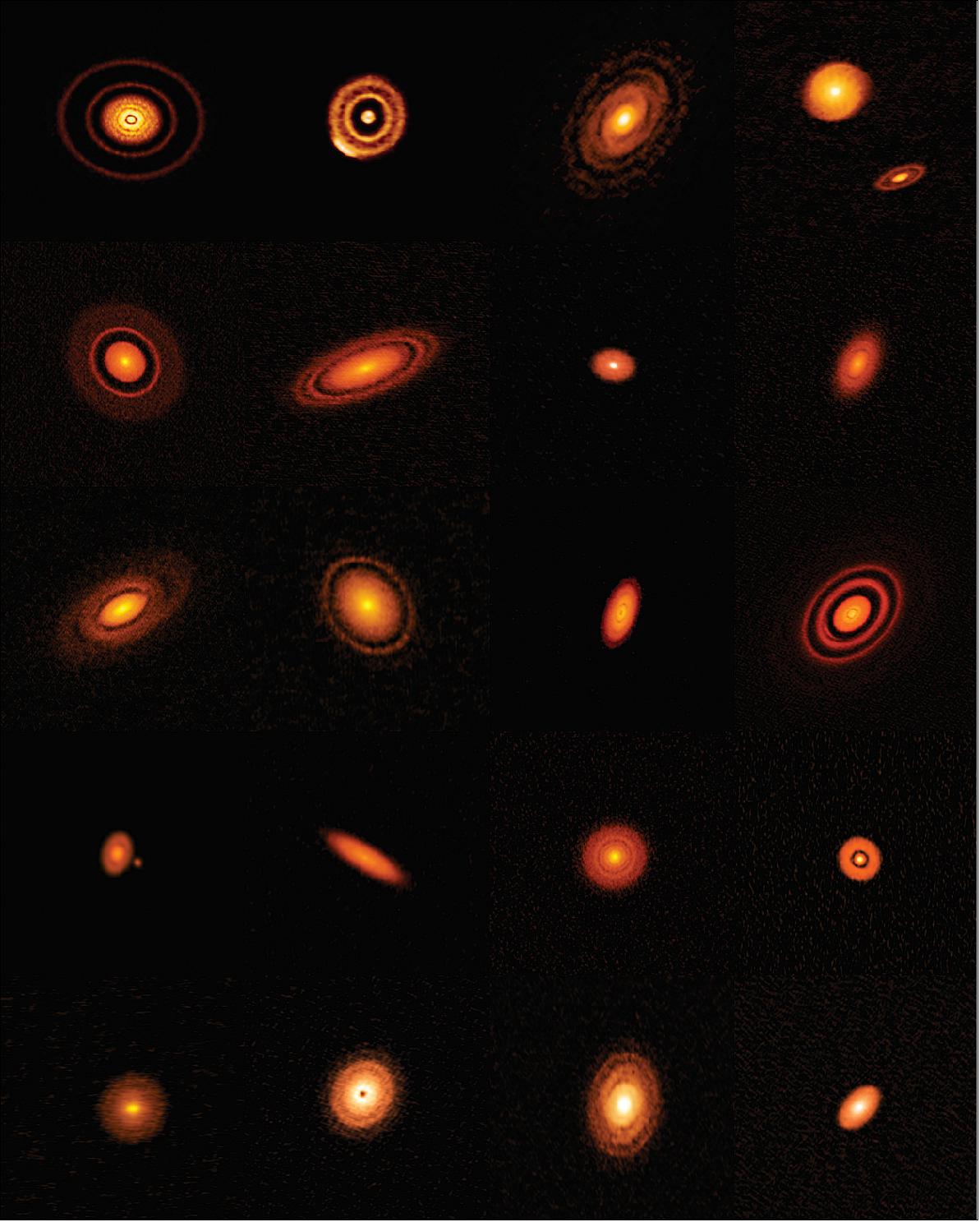
This research is presented in the following papers accepted to the Astrophysical Journal Letters.
1) Sean M. Andrews, Jane Huang, Laura M. Pérez, Andrea Isella, Cornelis P. Dullemond, Nicolás T. Kurtovic, Viviana V. Guzmán, John M. Carpenter, David J. Wilner, Shangjia Zhang, Zhaohuan Zhu, Tilman Birnstiel, Xue-Ning Bai, Myriam Benisty, A. Meredith Hughes, Karin I. Öberg, Luca Ricci, "The Disk Substructures at High Angular Resolution Project (DSHARP): I. Motivation, Sample, Calibration, and Overview," Astrophysical Journal Letters, 10 December 2018, URL: https://arxiv.org/pdf/1812.04040.pdf
2) Jane Huang, Sean M. Andrews, Cornelis P. Dullemond, Andrea Isella, Laura M. Pérez, Viviana V. Guzmán, Karin I. "Öberg, Zhaohuan Zhu, Shangjia Zhang, Xue-Ning Bai, Myriam Benisty, Tilman Birnstiel, John M. Carpenter, A. Meredith Hughes, Luca Ricci, Erik Weaver, David J. Wilner, "The Disk Substructures at High Angular Resolution Project (DSHARP): II. Characteristics of Annular Substructures," Astrophysical Journal Letters, 10 December 2018, URL: https://arxiv.org/pdf/1812.04041.pdf
3) Jane Huang, Sean M. Andrews, Laura M. Pérez, Zhaohuan Zhu, Cornelis P. Dullemond, Andrea Isella, Myriam Benisty, Xue-Ning Bai, Tilman Birnstiel, John M. Carpenter, Viviana V. Guzmán, A. Meredith Hughes, Karin I. Öberg, Luca Ricci, David J. Wilner, Shangjia Zhang, "The Disk Substructures at High Angular Resolution Project (DSHARP): III. Spiral Structures in the Millimeter Continuum of the Elias 27, IM Lup, and WaOph 6 Disks," Astrophysical Journal Letters, 11 December 2018, URL: https://arxiv.org/pdf/1812.04193.pdf
4) Nicolás Kurtovic, Laura Pérez, Myriam Benisty, Zhaohuan Zhu, Shangjia Zhang, Jane Huang, Sean M. Andrews, Cornellis P. Dullemond, Andrea Isella, Xue-Ning Bai, John M. Carpenter, Viviana V. Guzmán, Luca Ricci, David J. Wilner, "The Disk Substructures at High Angular Resolution Project (DSHARP): IV. Characterizing substructures and interactions in disks around multiple star systems," 11 December, 2018, URL: https://arxiv.org/pdf/1812.04536.pdf
5) Tilman Birnstiel, Cornelis P. Dullemond, Zhaohuan Zhu, Sean M. Andrews, Xue-Ning Bai, David J. Wilner, John M. Carpenter, Jane Huang, Andrea Isella, Myriam Benisty, Laura M. Pérez, Shangjia Zhang, "The Disk Substructures at High Angular Resolution Project (DSHARP): V. Interpreting ALMA maps of protoplanetary disks in terms of a dust model," Astrophysical Journal Letters, 10 December 2018, URL: https://arxiv.org/pdf/1812.04043.pdf
6) Cornelis P. Dullemond, Tilman Birnstiel, Jane Huang, Nicolás T. Kurtovic, Sean M. Andrews, Viviana V. Guzmán, Laura M. Pérez, Andrea Isella, Zhaohuan Zhu, Myriam Benisty, David J. Wilner, Xue-Ning Bai, John M. Carpenter, Shangjia Zhang, Luca Ricci, "The Disk Substructures at High Angular Resolution Project (DSHARP): VI. Dust Trapping in Thin-Ringed Protoplanetary Disks," Astrophysical Journal Letters, 10 December 2018, URL: https://arxiv.org/pdf/1812.04044.pdf
7) Shangjia Zhang, Zhaohuan Zhu, Jane Huang, Viviana V. Guzmán, Sean M. Andrews, Tilman Birnstiel, Cornelis P. Dullemond, John M. Carpenter, Andrea Isella, Laura M. Pérez, Myriam Benisty, David J. Wilner, Clément Baruteau, Xue-Ning Bai, Luca Ricci, "The Disk Substructures at High Angular Resolution Project (DSHARP): VII. The Planet-Disk Interactions Interpretation," Astrophysical Journal Letters, 10 December 2018, URL: https://arxiv.org/pdf/1812.04045.pdf
8) Viviana V. Guzmán, Jane Huang, Sean M. Andrews, Andrea Isella, Laura M. Pérez, John M. Carpenter, Cornelis P. Dullemond, Luca Ricci, Tilman Birnstiel, Shangjia Zhang, Zhaohuan Zhu, Xue-Ning Bai, Myriam Benisty, Karin I. Öberg, David J. Wilner"The Disk Substructures at High Angular Resolution Project (DSHARP): VIII. The Rich Ringed Substructures in the AS 209 Disk," Astrophysical Journal Letters, 10 December 2018, URL: https://arxiv.org/pdf/1812.04046.pdf
9) Andrea Isella, Jane Huang, Sean M. Andrews, Cornelis P. Dullemond, Tilman Birnstiel, Shangjia Zhang, Zhaohuan Zhu, Viviana V. Guzmán, Laura M. Pérez, Xue-Ning Bai, Myriam Benisty, John M. Carpenter, Luca Ricci, David J. Wilner, "The Disk Substructures at High Angular Resolution Project (DSHARP): IX. A High Definition Study of the HD 163296 Planet Forming Disk," Astrophysical Journal Letters, 10 December 2018, URL: https://arxiv.org/pdf/1812.04047.pdf
10) Laura M. Pérez, Myriam Benisty, Sean M. Andrews, Andrea Isella, Cornelis P. Dullemond, Jane Huang, Nicolás T. Kurtovic, Viviana V. Guzmán, Zhaohuan Zhu, Tilman Birnstiel, Shangjia Zhang, John M. Carpenter, David J. Wilner, Luca Ricci, Xue-Ning Bai, Erik Weaver, Karin I. Öberg, "The Disk Substructures at High Angular Resolution Project (DSHARP): X. Multiple Rings, a Misaligned Inner Disk, and a Bright Arc in the Disk around the T Tauri Star HD 143006," Astrophysical Journal Letters, 10 December 2018, URL: https://arxiv.org/pdf/1812.04049.pdf
• November 30, 2018: Based on computer simulations and new observations from the Atacama Large Millimeter/submillimeter Array (ALMA), researchers have found that the rings of gas surrounding active supermassive black holes are not simple donut shapes. Instead, gas expelled from the center interacts with infalling gas to create a dynamic circulation pattern, similar to a water fountain in a city park. 5) 6)
- Most galaxies host a supermassive black hole, millions or billions of times as heavy as the Sun, in their centers. Some of these black holes swallow material quite actively. But astronomers have believed that rather than falling directly into the black hole, matter instead builds up around the active black hole forming a donut structure.
- Takuma Izumi, a researcher at the National Astronomical Observatory of Japan (NAOJ), led a team of astronomers that used ALMA to observe the supermassive black hole in the Circinus Galaxy located 14 million light-years away from the Earth in the direction of the constellation Circinus. The team then compared their observations to a computer simulation of gas falling towards a black hole made with the Cray XC30 ATERUI supercomputer operated by NAOJ. This comparison revealed that the presumptive "donut" is not actually a rigid structure, but instead a complex collection of highly dynamic gaseous components. First, cold molecular gas falling towards the black hole forms a disk near the plane of rotation. As it approaches the black hole, this gas is heated until the molecules break down into the component atoms and ions. Some of these atoms are then expelled above and below the disk, rather than being absorbed by the black hole. This hot atomic gas falls back onto the disk creating a turbulent three dimensional structure. These three components circulate continuously, similar to a water fountain in a city park.
- "Previous theoretical models set a priori assumptions of rigid donuts," explains Keiichi Wada, a theoretician at Kagoshima University in Japan, who lead the simulation study and is a member of the research team. "Rather than starting from assumptions, our simulation started from the physical equations and showed for the first time that the gas circulation naturally forms a donut. Our simulation can also explain various observational features of the system."
- "By investigating the motion and distribution of both the cold molecular gas and warm atomic gas with ALMA, we demonstrated the origin of the so-called ‘donut' structure around active black holes," said Izumi. "Based on this discovery, we need to rewrite the astronomy textbooks."
![Figure 5: ALMA image of the gas around the supermassive black hole in the center of the Circinus Galaxy. The distributions of CO molecular gas and C atomic gas are shown in orange and cyan, respectively [image credit: ALMA (ESO/NAOJ/NROA), Izumi et al.]](/api/cms/documents/163813/5433030/Alma2018_Auto3A.jpeg)
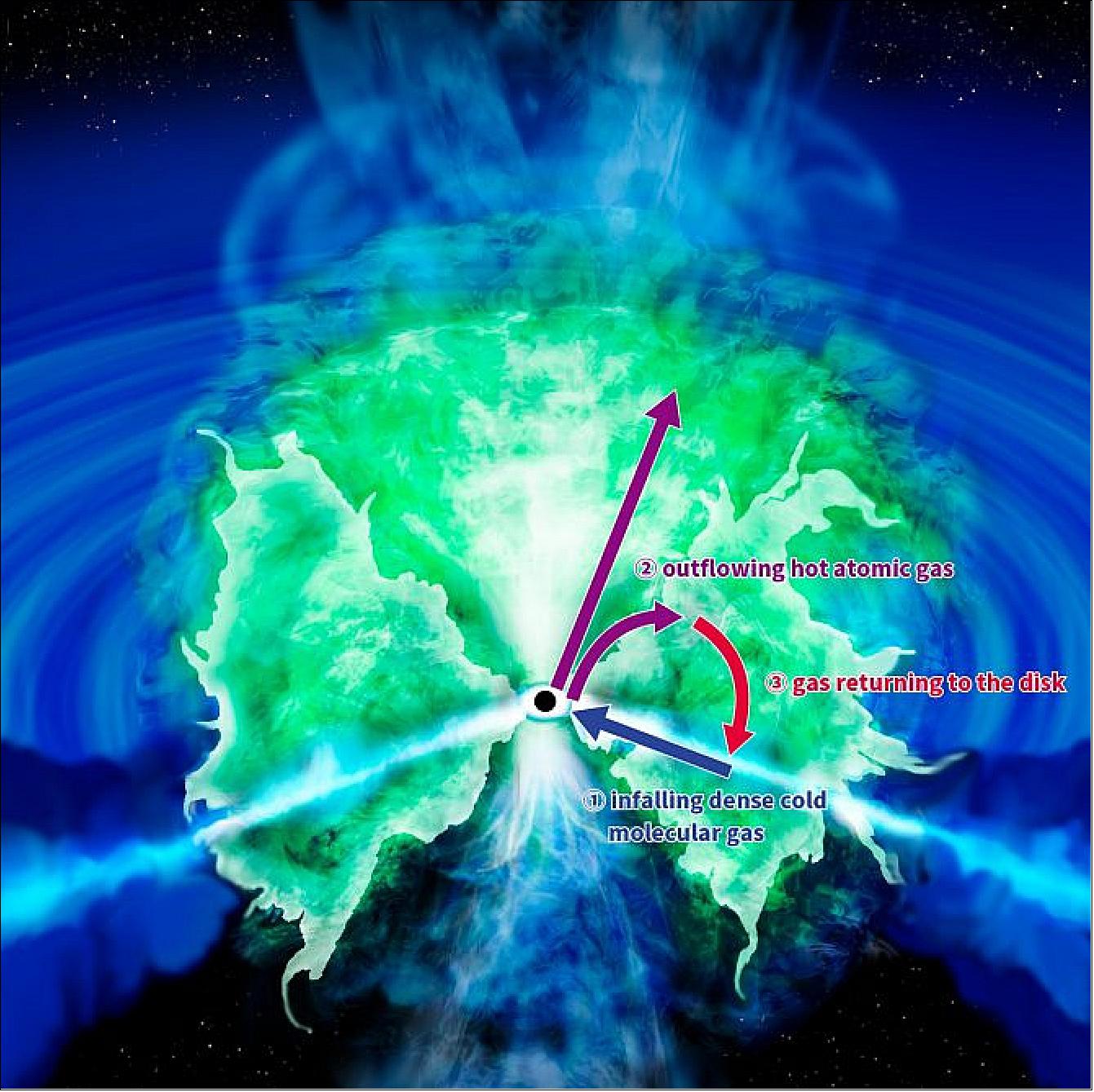
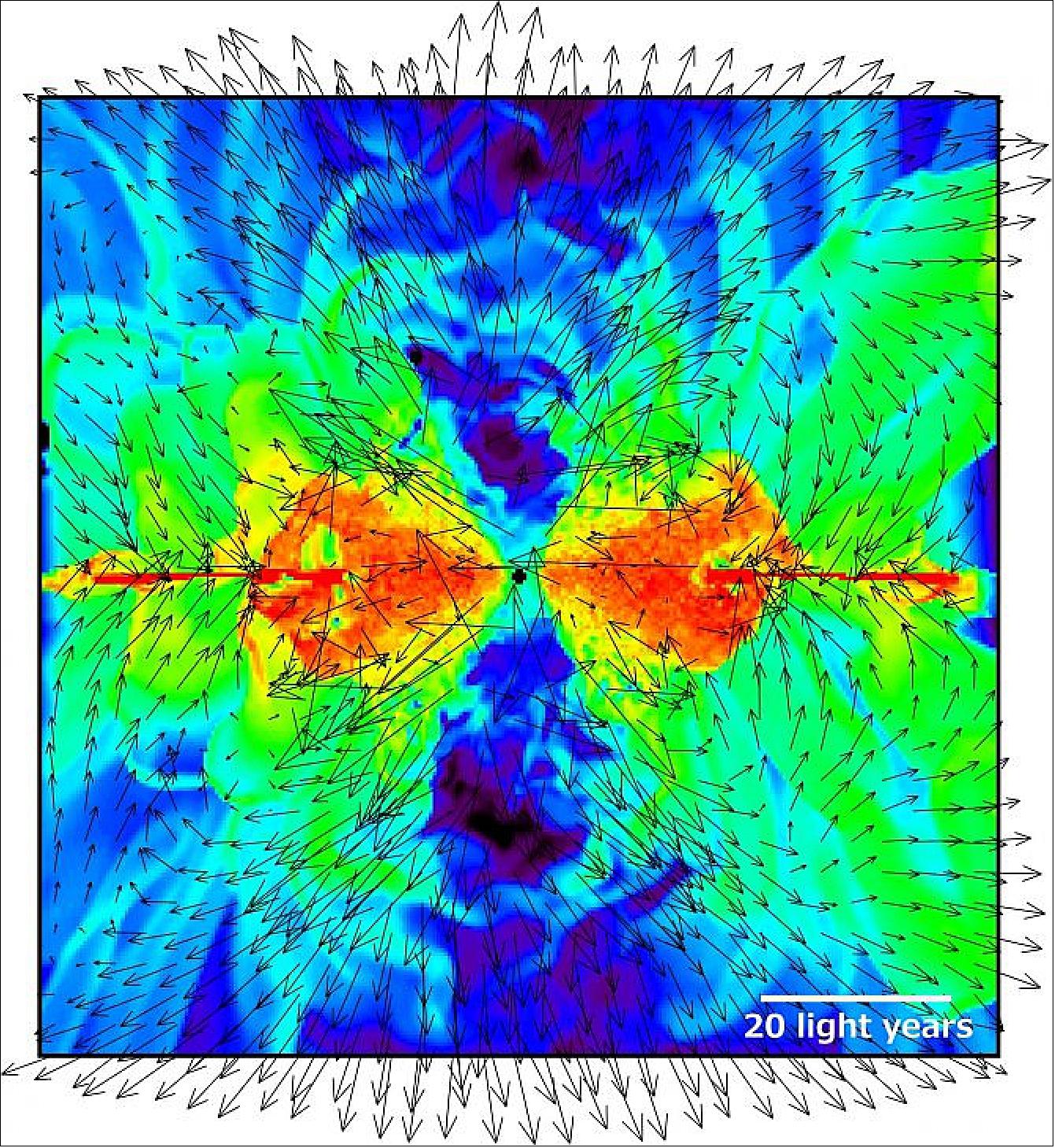
• November 22, 2018: The Atacama Large Millimeter/submillimeter Array (ALMA) has opened another new window to the Universe. Using its highest frequency receivers yet, researchers obtained 695 radio signals from various molecules, including simple sugar, in the direction of a massive star forming region, and revealed a pair of water vapor fountains erupting from the region. These first scientific results from the ALMA Band 10 receivers developed in Japan ensure a promising future for high frequency observations. 7)
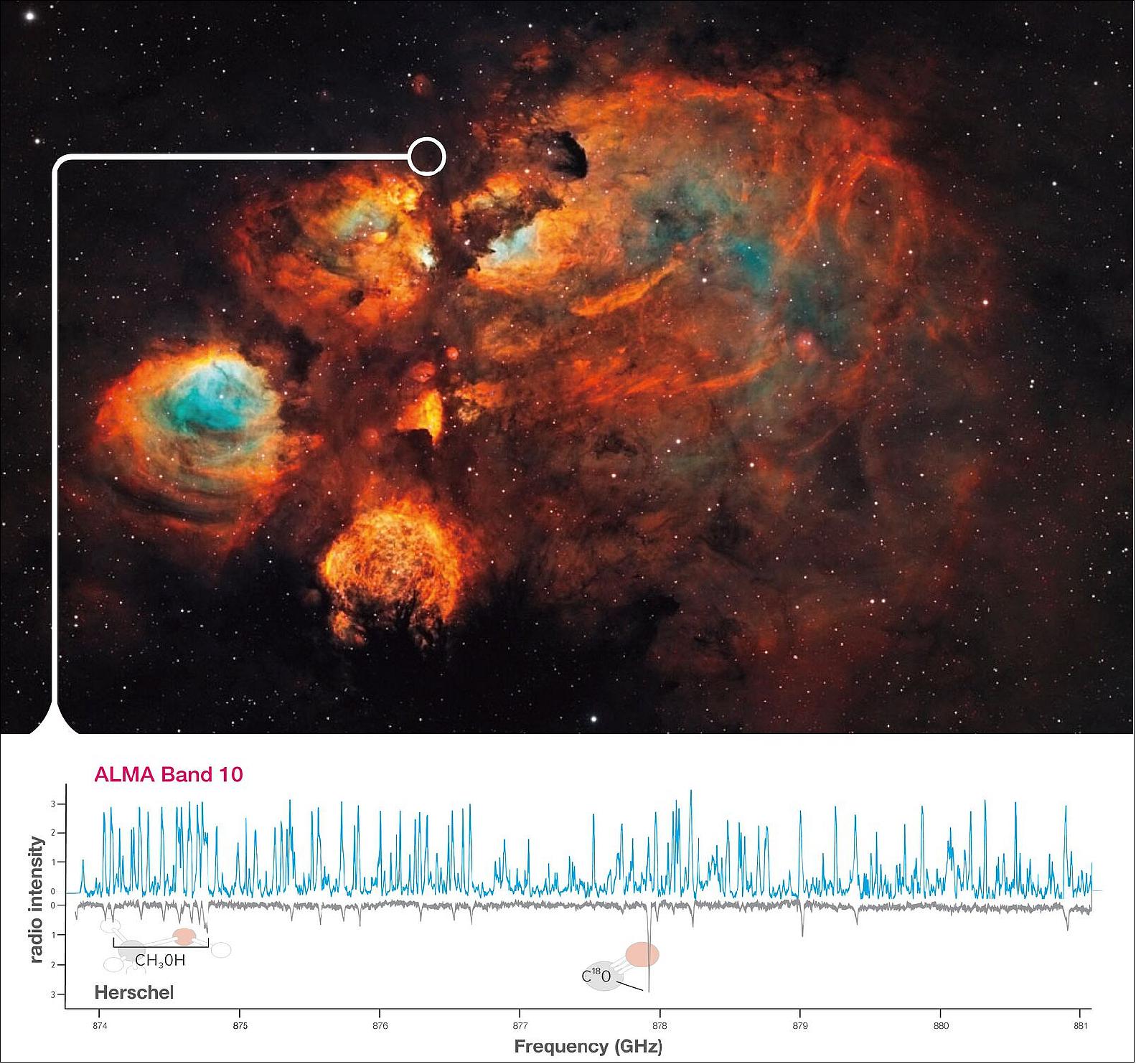
- The institutes participating in ALMA have shared responsibility for developing dedicated radio receivers for each of ALMA's 10 frequency bands. The National Astronomical Observatory of Japan (NAOJ) developed receivers for three bands; Band 4 (125-163 GHz), Band 8 (385-500 GHz), and Band 10 (787 to 950 GHz). The Band 10 receiver covers the highest frequency range in ALMA, which has not yet been extensively observed with other ground-based telescopes.
![Figure 9: ALMA Band 10 receiver [image credit:ALMA (ESO/NAOJ/NRAO)]](/api/cms/documents/163813/5433030/Alma2018_Auto36.jpeg)
- "High-frequency radio observations like in Band 10 are normally not possible from the ground," said Brett McGuire, a chemist at the National Radio Astronomy Observatory in Charlottesville, Virginia, and lead author on a paper in the Astrophysical Journal Letters. "They require the extreme precision and sensitivity of ALMA, along with some of the driest and most stable atmospheric conditions that can be found on Earth." 8)
- ALMA is a supremely sensitive cosmic chemical sensor. As molecules tumble and vibrate in space, they naturally emit electromagnetic radiation at specific frequencies, which appear as spikes on a spectrum. Each of ALMA's receiver bands can detect a different selection of these unique spectral fingerprints. The highest frequencies offer unique insight into lighter, important chemicals, like heavy water (HDO), as well as complex, warm molecules.
- McGuire and his team observed NGC 6634I, a nursery cloud of massive stars, with ALMA in 880 GHz. NGC 6334I is part of the Cat's Paw Nebula located 4,300 light-years away from Earth. "We detected a wealth of complex organic molecules surrounding this massive star-forming region," said McGuire. "These results have been received with excitement by the astronomical community and show once again how ALMA will reshape our understanding of the universe."
- The European Space Agency's Herschel Space Observatory has observed NGC 6334I in the same frequency range and detected 65 molecular emission lines. On the other hand, ALMA detected 695, 10 times as many spectral lines as Herschel. ALMA's prominent sensitivity and resolution offers a new level of astrochemistry research.
- The molecules detected in the direction of NGC 6334I include methanol, ethanol, methylamine, and glycolaldehyde, the simplest sugar-related molecule. Glycolaldehyde has already been detected around small baby stars in the IRAS 16293-2422 system with ALMA at a lower frequency. The difference in frequency reflects a difference in the environment. With Band 10 receivers, astronomers obtained a new tool to investigate warmer, denser regions.
- The other Band 10 result was also one of the most challenging, the direct observation of jets of water vapor streaming away from one of the massive protostars in NGC 6334I. ALMA was able to detect the high frequency radio waves naturally emitted by heavy water (water molecules made up of oxygen, hydrogen, and deuterium atoms, which are hydrogen atoms with a proton and a neutron in their nuclei).
- As a star begins to form out of massive clouds of dust and gas, the material surrounding the star falls onto the mass at the center. A portion of this material, however, is propelled away from the growing protostar as a pair of jets, which carry away gas and molecules, including water.
- The heavy water the researchers observed is flowing away from either a single protostar or a small cluster of protostars. These jets are oriented differently from what appear to be much larger and potentially more-mature jets emanating from the same region. The astronomers speculate that the heavy-water jets seen by ALMA are relatively recent features just beginning to move out into the surrounding nebula.
- "It is with much pleasure that we see the first scientific result from the ALMA Band 10 receiver," said Yoshinori Uzawa, the Director of the NAOJ Advanced Technology Center. He is an engineering researcher specializing in superconducting devices and led the Band 10 receiver development. "I have devoted myself to the research of superconducting devices for more than two decades, and the Band 10 receiver is one of the fruits of my work and the efforts of many staffs, including the Band 10 development team and the commissioning team in Chile. I'd like to express my appreciation to all, and I am looking forward to seeing yet more new insights into the Universe."
- Development of the ALMA receivers was not easy, especially for Band 10. Due to its extreme high frequency, researchers could not use the conventional superconducting devices made of Niobium. The development team made a high quality film from the compound superconductive material NbTiN (niobium-titanium nitrides) in cooperation with the National Institute of Information and Communication Technology to achieve the world's highest performance in the frequency of Band 10 in 2009. The team finished manufacturing and shipping the 73 receiver cartridges in 2014. After extensive commissioning and test observation on site, the Band 10 receivers have been used in ALMA's normal science operation since October 2015.
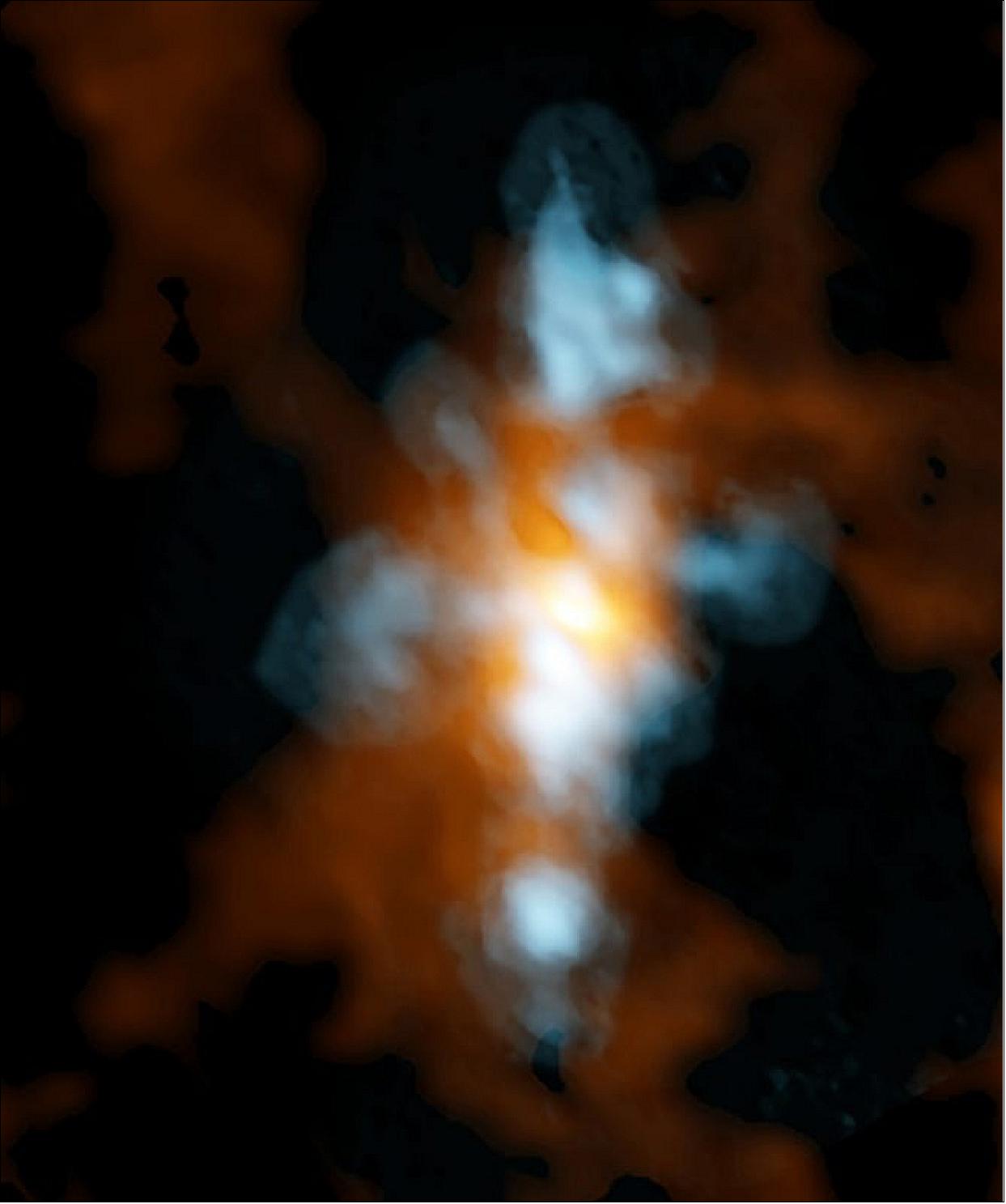
• November 15, 2018: The most luminous galaxy in the universe has been caught in the act of stripping away nearly half the mass from at least three of its smaller neighbors, according to a new study published in the journal Science. The light from this galaxy, known as W2246-0526, took 12.4 billion years to reach us, so we are seeing it as it was when our universe was only about a tenth of its present age. 9) 10)
- New observations with the ALMA reveal distinct streamers of material being pulled from three smaller galaxies and flowing into the more massive galaxy, which was discovered in 2015 by NASA's spaceborne WISE (Wide-field Infrared Survey Explorer). It is by no means the largest or most massive galaxy we know of, but it is unrivaled in its brightness, emitting as much infrared light as 350 trillion Suns.
- The connecting tendrils between the galaxies contain about as much material as the galaxies themselves. ALMA's amazing resolution and sensitivity allowed the researchers to detect these remarkably faint and distant trans-galactic streamers.
- "We knew from previous data that there were three companion galaxies, but there was no evidence of interactions between these neighbors and the central source," said Tanio Díaz-Santos of the Universidad Diego Portales in Santiago, Chile, lead author of the study. "We weren't looking for cannibalistic behavior and weren't expecting it, but this deep dive with the ALMA observatory makes it very clear." 11)
- Galactic cannibalism is not uncommon, though this is the most distant galaxy in which such behavior has been observed and the study authors are not aware of any other direct images of a galaxy simultaneously feeding on material from multiple sources at those early cosmic times.
- The researchers emphasize that the amount of gas being devoured by W2246-0526 is enough to keep it forming stars and feeding its central black hole for hundreds of millions of years.
- This galaxy's startling luminosity is not due to its individual stars. Rather, its brightness is powered by a tiny, yet fantastically energetic disk of gas that is being superheated as it spirals in on the supermassive black hole. The light from this blazingly bright accretion disk is then absorbed by the surrounding dust, which re-emits the energy as infrared light.
- This extreme infrared radiation makes this galaxy one of a rare class of quasars known as Hot, Dust-Obscured Galaxies or Hot DOGs. Only about one out of every 3,000 quasars observed by WISE belongs to this class.
- Much of the dust and gas being siphoned away from the three smaller galaxies is likely being converted into new stars and feeding the larger galaxy's central black hole. This galaxy's gluttony, however, may lead to its self-destruction. Previous research suggests that the energy of the AGN will ultimately jettison much, if not all of the galaxy's star-forming fuel.
- An earlier work led by co-author Chao-Wei Tsai of UCLA estimates that the black hole at the center of W2246-0526 is about 4 billion times the mass of the Sun. The mass of the black hole directly influences how bright the AGN can become, but — according to this earlier research — W2246-0526 is about 3 times more luminous than what should be possible. Solving this apparent contradiction will require additional observations.
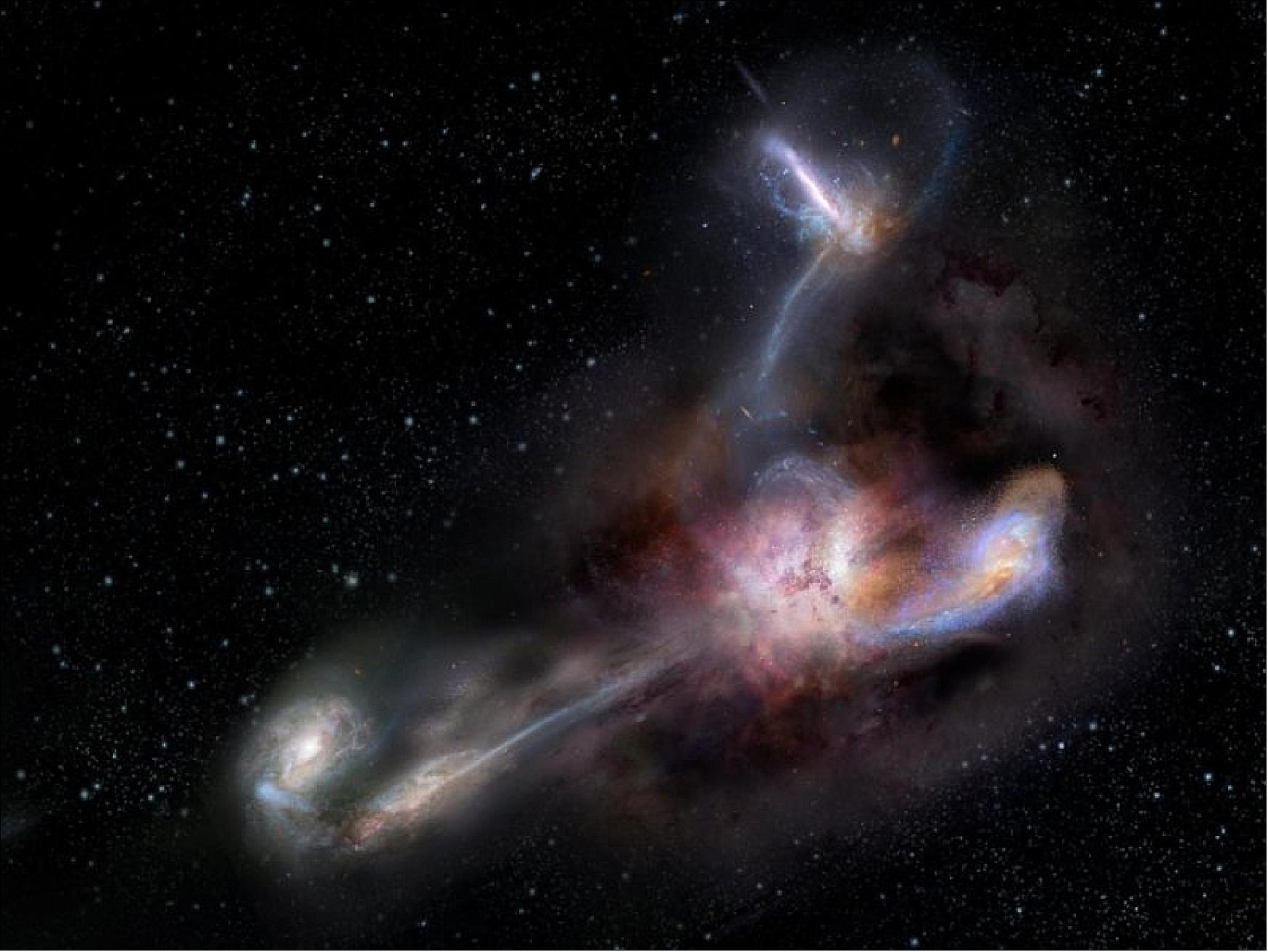
• October 23, 2018: Jupiter's icy moon Europa has a chaotic surface terrain that is fractured and cracked, suggesting a long-standing history of geologic activity. A new series of four images of Europa taken with ALMA (Atacama Large Millimeter/submillimeter Array) has helped astronomers create the first global thermal map of this cold satellite of Jupiter. The new images have a resolution of roughly 200 km, sufficient to study the relationship between surface thermal variations and the moon's major geologic features. 12)
- The researchers compared the new ALMA observations of Europa to a thermal model based on observations from the Galileo spacecraft. This comparison allowed them to analyze the temperature changes in the data and construct the first-ever global map of Europa's thermal characteristics. The new data also revealed an enigmatic cold spot on Europa's northern hemisphere.
- "These ALMA images are really interesting because they provide the first global map of Europa's thermal emission," said Samantha Trumbo, a planetary scientist at the California Institute of Technology and lead author on a paper published in the Astronomical Journal. "Since Europa is an ocean world with potential geologic activity, its surface temperatures are of great interest because they may constrain the locations and extents of any such activity." 13)
- Evidence strongly suggests that beneath its thin veneer of ice, Europa has an ocean of briny water in contact with a rocky core. Europa also has a comparatively young surface, only about 20 to 180 million years old, indicating that there are as-yet-unidentified thermal or geologic processes at work.
- Unlike optical telescopes, which can only detect sunlight reflected by planetary bodies, radio and millimeter-wave telescopes like ALMA can detect the thermal "glow" naturally emitted by even relatively cold object in our Solar System, including comets, asteroids, and moons. At its warmest, Europa's surface temperature never rises above minus 160 degrees Celsius (minus 260 degrees Fahrenheit).
- "Studying Europa's thermal properties provides a unique means of understanding its surface," said Bryan Butler, an astronomer at the NRAO (National Radio Astronomy Observatory) in Socorro, New Mexico, and coauthor on the paper. NRAO is a facility of the National Science Foundation (NSF), operated under cooperative agreement by Associated Universities, Inc.
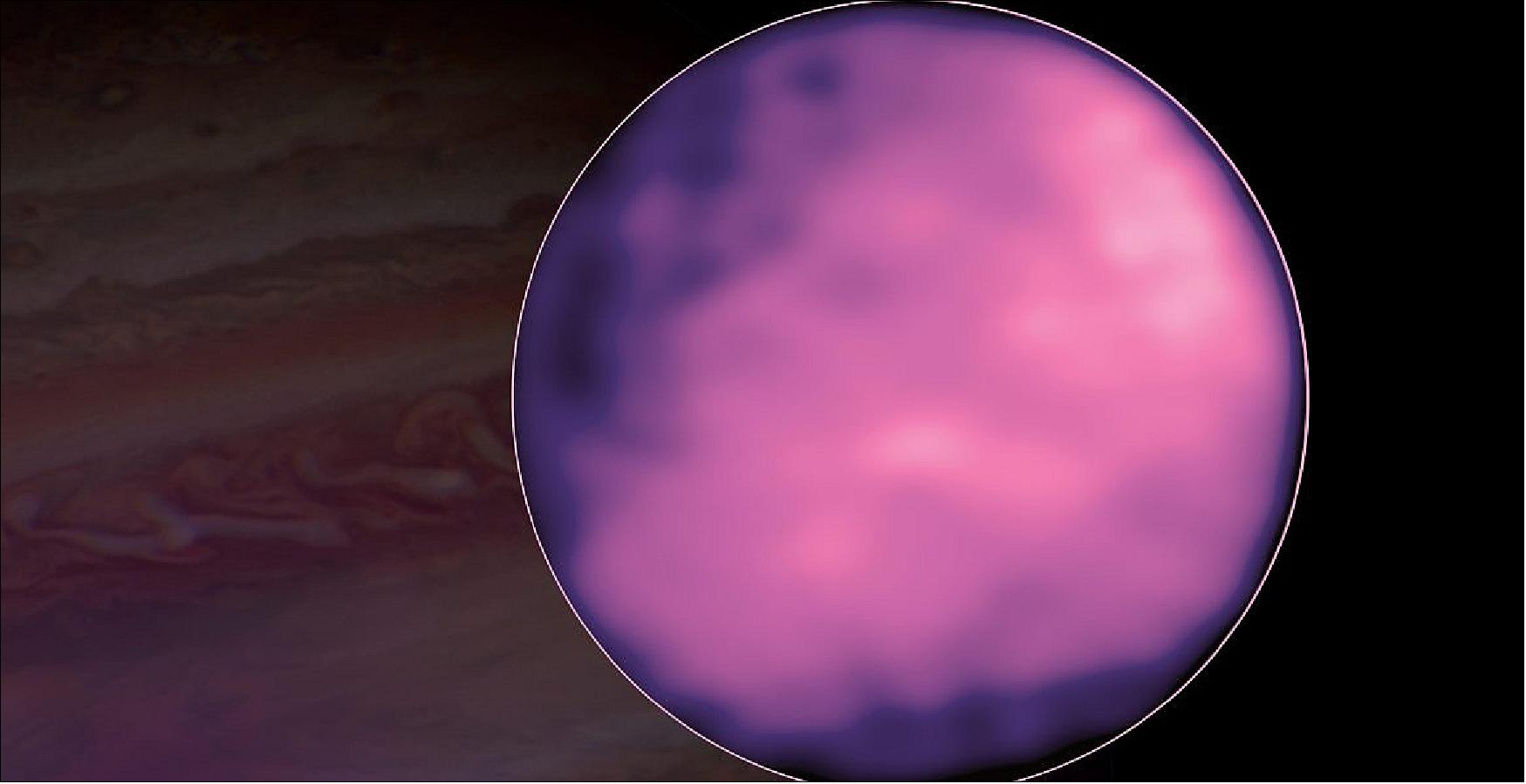

• October 8, 2018: Using ALMA, an international team of astronomers found evidence that a white dwarf (the elderly remains of a Sun-like star) and a brown dwarf (a failed star without the mass to sustain nuclear fusion) collided in a short-lived blaze of glory that was witnessed on Earth in 1670 as Nova sub Capite Cygni (a New Star below the Head of the Swan), which is now known as CK Vulpeculae. 14)
- In July of 1670, observers on Earth witnessed a "new star," or nova, in the constellation Cygnus. Where previously there was dark sky, a bright pinprick of light appeared, faded, reappeared, and then disappeared entirely from view. Modern astronomers studying the remains of this cosmic event initially thought it heralded the merging of two main sequence stars – stars on the same evolutionary path as our Sun.
- New observations with ALMA point to a more intriguing explanation. By studying the debris from this explosion, which takes the form of dual rings of dust and gas resembling an hourglass with a compact central object, the researchers concluded that a brown dwarf (a so-called failed star without the mass to sustain nuclear fusion) merged with a white dwarf (the elderly, cooling remains of a Sun-like star).

- "It now seems what was observed centuries ago was not what we would today describe as a classic ‘nova.' Instead, it was the merger of two stellar objects, a white dwarf and a brown dwarf. When these two objects collided, they spilled out a cocktail of molecules and unusual isotopes, which gave us new insights into the nature of this object," said Sumner Starrfield, an astronomer at Arizona State University and co-author on a paper appearing in the Monthly Notices of the Royal Astronomical Society.
- According to the researchers, the white dwarf would have been about ten times more massive than the brown dwarf, though much smaller in size. As the brown dwarf spiraled inward, intense tidal forces exerted by the white dwarf would have ripped it apart. "This is the first time such an event has been conclusively identified," remarked Starrfield.
- Since most star systems in the Milky Way are binary, stellar collisions are not that rare, the astronomers note. The new ALMA observations reveal new details about the 1670 event. By studying the light from two, more-distant stars as it shines through the dusty remains of the merger, the researchers were able to detect the telltale signature of the element lithium, which is easily destroyed in the interior of a main sequence star, but not inside a brown dwarf.
- "The presence of lithium, together with unusual isotopic ratios of the elements carbon, nitrogen, and oxygen point to material from a brown dwarf star being dumped on the surface of a white dwarf. The thermonuclear ‘burning' and an eruption of this material resulted in the hourglass we see today," said Stewart Eyres, Deputy Dean of the Faculty of Computing, Engineering and Science at the University of South Wales and lead author on the paper. 15)
- Intriguingly, the hourglass is also rich in organic molecules such as formaldehyde (H2CO) and formamide (NH2CHO), which is derived from formic acid. These molecules would not survive in an environment undergoing nuclear fusion and must have been produced in the debris from the explosion. This lends further support to the conclusion that a brown dwarf met its demise in a star-on-star collision with a white dwarf.
• August 30, 2018: Using ALMA (Atacama Large Millimeter/submillimeter Array), a team of astronomers revealed that molecular clouds in a galaxy called AzTEC/COSMOS-1, an extreme starburst (star-forming) galaxy located 12.4 billion light-years away, are highly unstable, which leads to runaway star formation. Extreme starburst galaxies, also known as ‘monster' galaxies, are thought to be the ancestors of very massive elliptical galaxies in today's Universe, therefore the findings pave the way to understand the formation and evolution of such galaxies. 16)
- ‘Monster' galaxies form stars at a startling pace — 1,000 times higher than the star formation in our Milky Way Galaxy. But why are they so active?
- To tackle this problem, astronomers need to know the environment around the stellar nurseries. Drawing detailed maps of molecular clouds is an important step to scout a cosmic monster.
- "A real surprise is that AzTEC/COSMOS-1 seen 12.4 billion years ago has a massive, ordered gas disk that is in regular rotation instead of what we had expected, which would have been some kind of a disordered train wreck that most theoretical studies had predicted," said University of Massachusetts Amherst's Professor Min Yun, co-author of the current study and a member of the team that discovered this galaxy in 2007.
- "AzTEC/COSMOS-1's gas disk is dynamically unstable now, which means the entire gas disk that makes up this galaxy is fragmenting and undergoing a gigantic episode of starburst, which helps to explain its enormous star formation rate, more than 1,000 times that of the Milky Way."
- Professor Yun and colleagues found that AzTEC/COSMOS-1 is rich in the ingredients of stars, but it was still difficult to figure out the nature of the cosmic gas in the galaxy.
- They used ALMA's high resolution and high sensitivity to observe the galaxy and obtain a detailed map of the distribution and the motion of the gas to make the highest resolution molecular gas map of a distant monster galaxy ever made.
- "We found that there are two distinct large clouds several thousand light-years away from the center," said study lead author Dr. Ken-ichi Tadaki, a postdoctoral researcher at the Japan Society for the Promotion of Science and the National Astronomical Observatory of Japan. "In most distant starburst galaxies, stars are actively formed in the center. So it is surprising to find off-center clouds."
- "How these galaxies have been able to amass such a large quantity of gas in the first place and then essentially turn the entire gas reserve into stars in the blink of an eye, cosmologically speaking, was a completely unknown question about which we could only speculate. We have the first answers now," Professor Yun said. "Until this result came in from ALMA, nobody knew how Nature created massive, young galaxies formed only 1 billion years after the Big Bang."
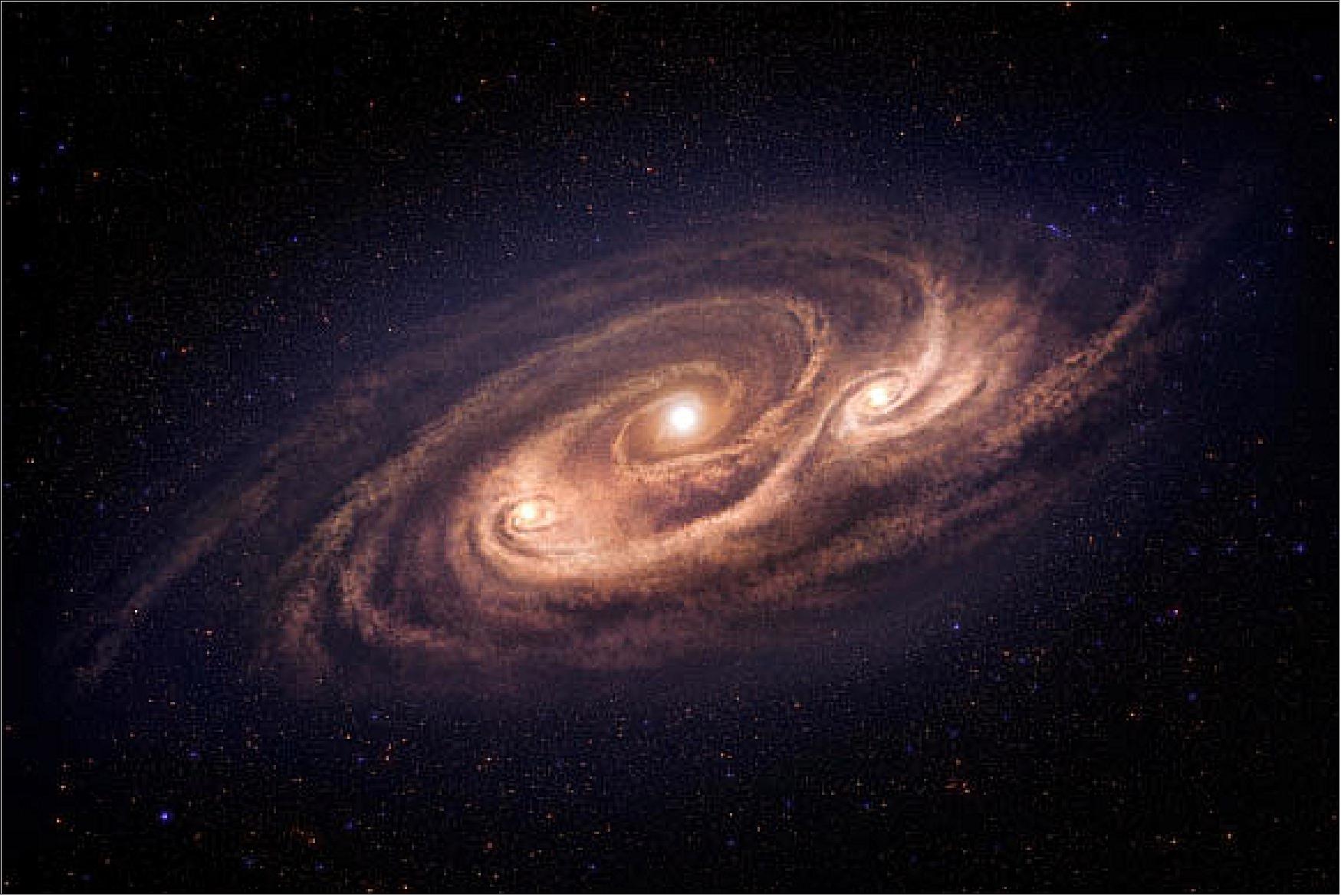
- With the new observations, the researchers now believe that the monster galaxy is powered by ‘an extremely gas-heavy disk that is somehow kept stable until enough gas is amassed.'
- "We still don't know yet how so much gas is collected so quickly and what kept this enormous gas reserve from igniting and turning into stars, as gas is known to do in the local Universe," Professor Yun said.
- The astronomers found that the gas clouds in AzTEC/COSMOS-1 are very unstable, which is unusual. "In a normal situation, the inward gravity and outward pressure are balanced," they said. "Once gravity overcomes pressure, the gas cloud collapses and forms stars at a rapid pace. Then, stars and supernova explosions at the end of the stellar life cycle blast out gases, which increase the outward pressure."

- "As a result, the gravity and pressure reach a balanced state and star formation continues at a moderate pace. In this way star formation in galaxies is self-regulating."
- "But in AzTEC/COSMOS-1, the pressure is far weaker than gravity and hard to balance. Therefore this galaxy shows runaway star formation and has morphed into an unstoppable monster galaxy."
- The study authors estimate that the gas in AzTEC/COSMOS-1 will be completely consumed in 100 million years, which is 10 times faster than in other star forming galaxies. 17)
- Why the gas in this galaxy is so unstable is not clear yet, but a phenomenon called ‘galaxy merger' is a possible cause.
- Galaxy collision may have efficiently transported the gas into a small area and ignited intense star formation.
- "At this moment, we have no evidence of merger in this galaxy. But by observing other similar galaxies with ALMA, we want to unveil the relation between galaxy mergers and monster galaxies," Dr. Tadaki said.
• July 30, 2018: Astronomers using ALMA and NOEMA have made the first definitive detection of a radioactive molecule in interstellar space. The radioactive part of the molecule is an isotope of aluminium. The observations reveal that the isotope was dispersed into space after the collision of two stars, that left behind a remnant known as CK Vulpeculae. This is the first time that a direct observation has been made of this element from a known source. Previous identifications of this isotope have come from the detection of gamma rays, but their precise origin had been unknown. 18)
- The team, led by Tomasz Kamiński (Harvard-Smithsonian Center for Astrophysics, Cambridge, USA), used the ALMA (Atacama Large Millimeter/submillimeter Array) and the NOEMA (NOrthern Extended Millimeter Array) to detect a source of the radioactive isotope aluminium-26 (26Al). The source, known as CK Vulpeculae, was first seen in 1670 and at the time it appeared to observers as a bright, red "new star". Though initially visible with the naked eye, it quickly faded and now requires powerful telescopes to see the remains of this merger, a dim central star surrounded by a halo of glowing material flowing away from it. 19)
- 348 years after the initial event was observed, the remains of this explosive stellar merger have led to the clear and convincing signature of a radioactive version of aluminum, known as aluminium-26. This is the first unstable radioactive molecule definitively detected outside of the Solar System. Unstable isotopes have an excess of nuclear energy and eventually decay into a stable form.
- "This first observation of this isotope in a star-like object is also important in the broader context of galactic chemical evolution," notes Kamiński. "This is the first time an active producer of the radioactive nuclide aluminum-26 has been directly identified."
- Kamiński and his team detected the unique spectral signature of molecules made up of aluminum-26 and fluorine (26AlF) in the debris surrounding CK Vulpeculae, which is about 2000 light-years from Earth. As these molecules spin and tumble through space, they emit a distinctive fingerprint of millimeter-wavelength light, a process known as rotational transition. Astronomers consider this the "gold standard" for detections of molecules.
Note: The characteristic molecular fingerprints are usually taken from laboratory experiments. In the case of 26AlF, this method is not applicable because 26-aluminium is not present on Earth. Laboratory astrophysicists from the University of Kassel/Germany therefore used the fingerprint data of stable and abundant 27AlF (27 aluminum monofluoride) molecules to derive accurate data for the rare 26AlF molecule.
- The observation of this particular isotope provides fresh insights into the merger process that created CK Vulpeculae. It also demonstrates that the deep, dense, inner layers of a star, where heavy elements and radioactive isotopes are forged, can be churned up and cast into space by stellar collisions.
- "We are observing the guts of a star torn apart three centuries ago by a collision," remarked Kamiński.
- The astronomers also determined that the two stars that merged were of relatively low mass, one being a red giant star with a mass somewhere between 0.8 and 2.5 times that of our Sun.
- Being radioactive, aluminium-26 will decay to become more stable and in this process one of the protons in the nucleus decays into a neutron. During this process, the excited nucleus emits a photon with very high energy, which we observe as a gamma ray.
Note: Aluminium-26 contains 13 protons and 13 neutrons in its nucleus (one neutron fewer than the stable isotope, aluminium-27). When it decays aluminium-26 becomes magnesium-26, a completely different element.
- Previously, detections of gamma ray emission have shown that around two solar masses of aluminium-26 are present across the Milky Way, but the process that created the radioactive atoms was unknown. Furthermore, owing to the way that gamma rays are detected, their precise origin was also largely unknown. With these new measurements, astronomers have definitively detected for the first time an unstable radioisotope in a molecule outside of our Solar System.
- At the same time, however, the team have concluded that the production of aluminium-26 by objects similar to CK Vulpeculae is unlikely to be the major source of aluminium-26 in the Milky Way. The mass of aluminium-26 in CK Vulpeculae is roughly a quarter of the mass of Pluto, and given that these events are so rare, it is highly unlikely that they are the sole producers of the isotope in the Milky Way galaxy. This leaves the door open for further studies into these radioactive molecules.
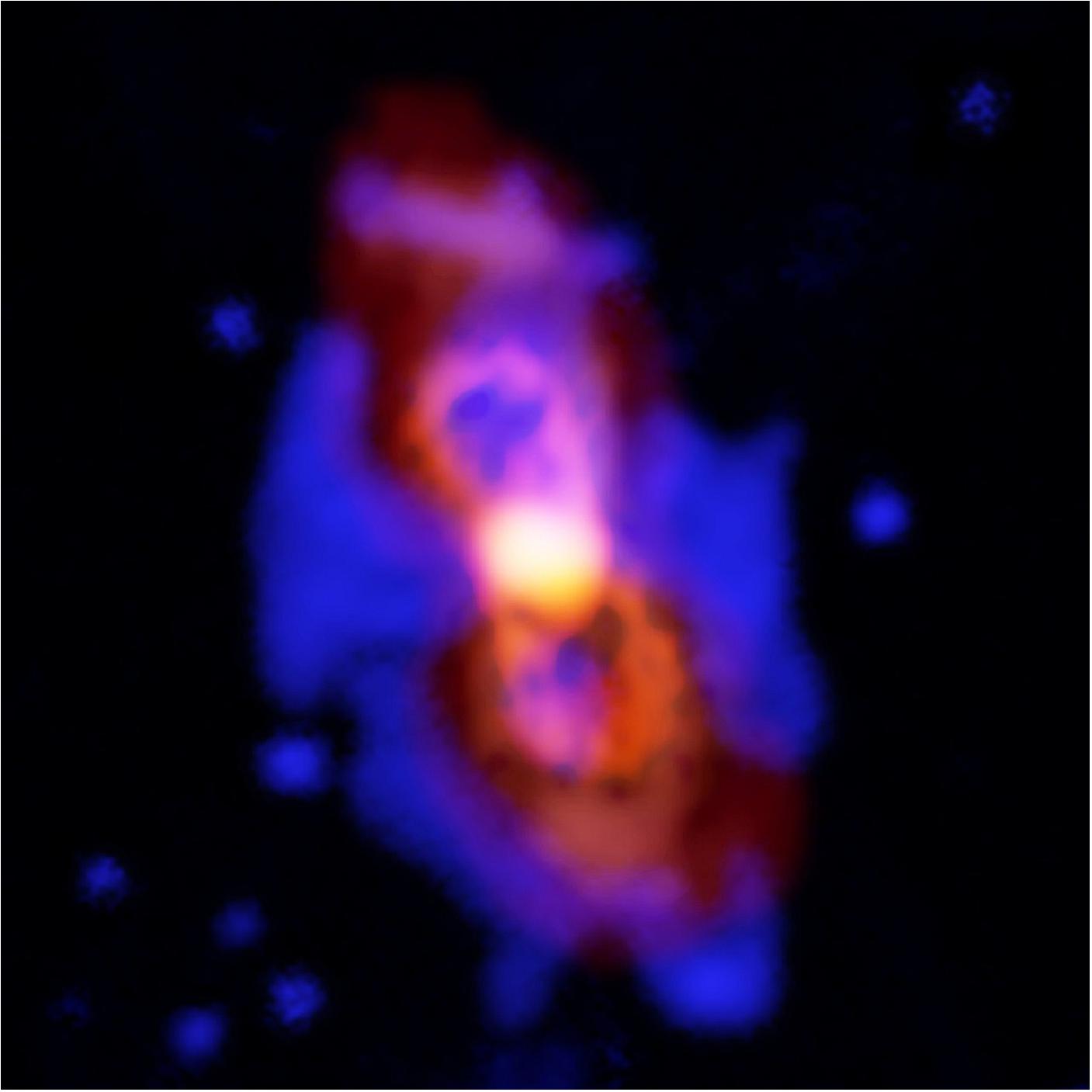
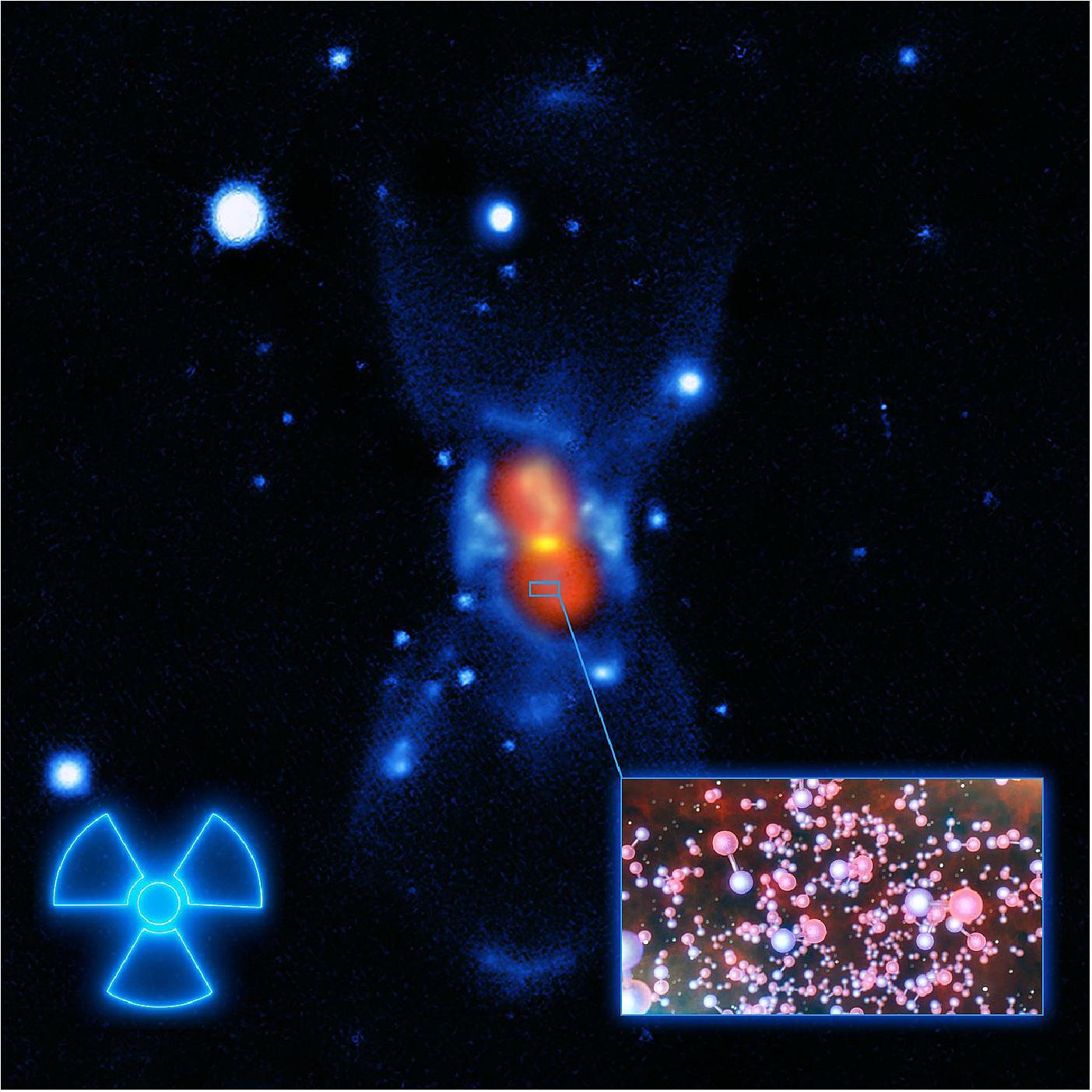
• June 13, 2018: ALMA has transformed our understanding of protoplanetary discs — the gas- and dust-filled planet factories that encircle young stars. The rings and gaps in these discs provide intriguing circumstantial evidence for the presence of protoplanets . Other phenomena, however, could also account for these tantalizing features. 20)
Note: Although thousands of exoplanets have been discovered in the last two decades, detecting protoplanets remains at the cutting edge of science and there have been no unambiguous detections before now. The techniques currently used for finding exoplanets in fully formed planetary systems — such as measuring the wobble of a star or the dimming of starlight due to a transiting planet — do not lend themselves to detecting protoplanets.
- But now, using a novel planet-hunting technique that identifies unusual patterns in the flow of gas within a planet-forming disc around a young star, two teams of astronomers have each confirmed distinct, telltale hallmarks of newly formed planets orbiting an infant star.
Note: The motion of gas around a star in the absence of planets has a very simple, predictable pattern (Keplerian rotation) that is nearly impossible to alter both coherently and locally, so that only the presence of a relatively massive object can create such disturbances.
- "Measuring the flow of gas within a protoplanetary disc gives us much more certainty that planets are present around a young star," said Christophe Pinte of Monash University in Australia and Institut de Planétologie et d'Astrophysique de Grenoble (Université de Grenoble-Alpes/CNRS) in France, and lead author on one of the two papers. "This technique offers a promising new direction to understand how planetary systems form."
- To make their respective discoveries, each team analyzed ALMA observations of HD 163296, a young star about 330 light-years from Earth in the constellation of Sagittarius (The Archer). This star is about twice the mass of the Sun but is just four million years old — just a thousandth of the age of the Sun.
Note: ALMA's stunning images of HD 163296 and other similar systems have revealed intriguing patterns of concentric rings and gaps within protoplanetary discs. These gaps may be evidence that protoplanets are ploughing the dust and gas away from their orbits, incorporating some of it into their own atmospheres. A previous study of this particular star's disc shows that the gaps in the dust and gas overlap, suggesting that at least two planets have formed there. — These initial observations, however, merely provided circumstantial evidence and could not be used to accurately estimate the masses of the planets.
- "We looked at the localized, small-scale motion of gas in the star's protoplanetary disc. This entirely new approach could uncover some of the youngest planets in our galaxy, all thanks to the high-resolution images from ALMA," said Richard Teague, an astronomer at the University of Michigan and principal author on the other paper.
- Rather than focusing on the dust within the disc, which was clearly imaged in earlier ALMA observations, the astronomers instead studied carbon monoxide (CO) gas spread throughout the disc. Molecules of CO emit a very distinctive millimeter-wavelength light that ALMA can observe in great detail. Subtle changes in the wavelength of this light due to the Doppler effect reveal the motions of the gas in the disc.
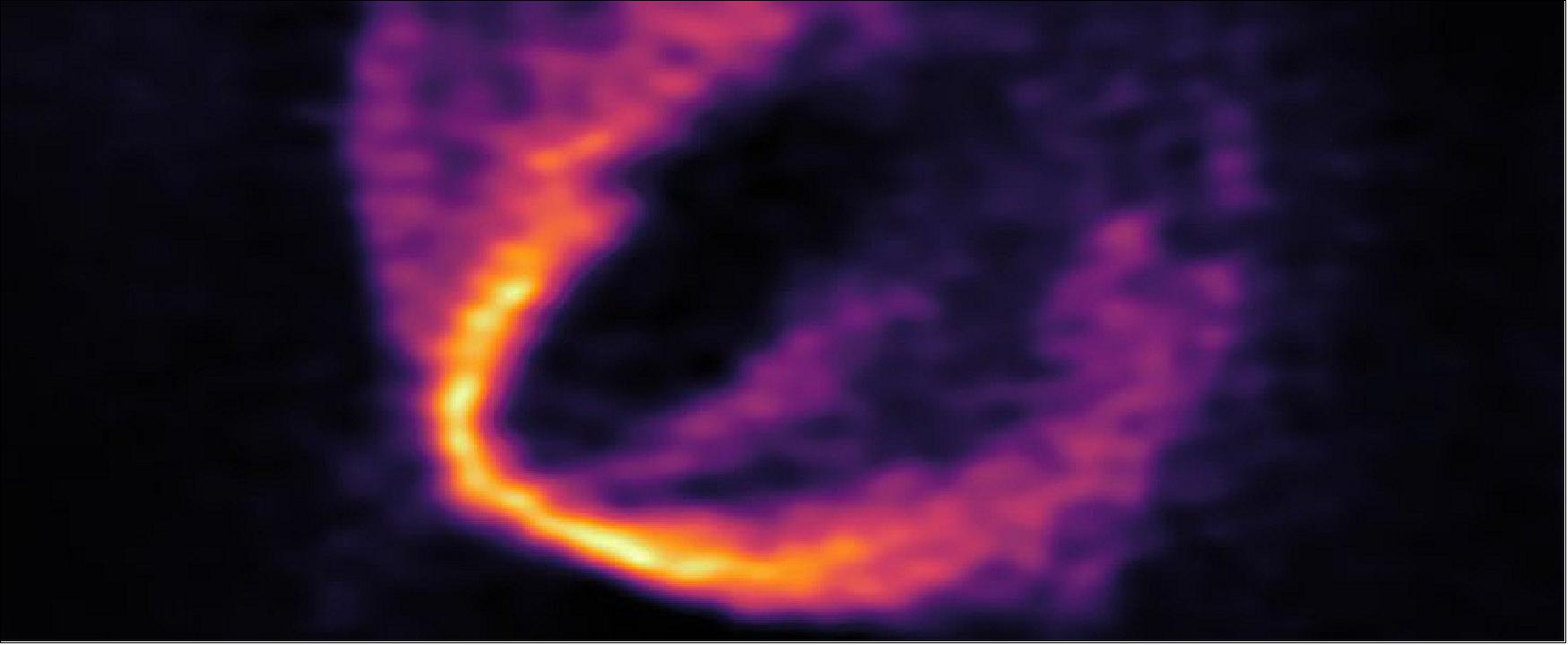
- The team led by Teague identified two planets located approximately 12 billion and 21 billion kilometers from the star. The other team, led by Pinte, identified a planet at about 39 billion kilometers from the star.
Note: These correspond to 80, 140 and 260 times the distance from the Earth to the Sun.
- The two teams used variations on the same technique, which looks for anomalies in the flow of gas — as evidenced by the shifting wavelengths of the CO emission — that indicate the gas is interacting with a massive object.
Note: This technique is similar to the one that led to the discovery of the planet Neptune in the nineteenth century. In that case anomalies in the motion of the planet Uranus were traced to the gravitational effect of an unknown body, which was subsequently discovered visually in 1846 and found to be the eighth planet in the Solar System.
- The technique used by Teague, which derived averaged variations in the flow of the gas as small as a few percent, revealed the impact of multiple planets on the gas motions nearer to the star. The technique used by Pinte, which more directly measured the flow of the gas, is better suited to studying the outer portion of the disc. It allowed the authors to more accurately locate the third planet, but is restricted to larger deviations of the flow, greater than about 10%.
- In both cases, the researchers identified areas where the flow of the gas did not match its surroundings — a bit like eddies around a rock in a river. By carefully analyzing this motion, they could clearly see the influence of planetary bodies similar in mass to Jupiter.
- This new technique allows astronomers to more precisely estimate protoplanetary masses and is less likely to produce false positives. "We are now bringing ALMA front and center into the realm of planet detection," said coauthor Ted Bergin of the University of Michigan.
- Both teams will continue refining this method and will apply it to other discs, where they hope to better understand how atmospheres are formed and which elements and molecules are delivered to a planet at its birth.
• May 16, 2018: An international team of astronomers used ALMA to observe a distant galaxy called MACS1149-JD1. They detected a very faint glow emitted by ionized oxygen in the galaxy. As this infrared light travelled across space, the expansion of the Universe stretched it to wavelengths more than ten times longer by the time it reached Earth and was detected by ALMA. The team inferred that the signal was emitted 13.3 billion years ago (or 500 million years after the Big Bang), making it the most distant oxygen ever detected by any telescope. The presence of oxygen is a clear sign that there must have been even earlier generations of stars in this galaxy. 21)
Note: ALMA has set the record for detecting the most distant oxygen several times. In 2016, Akio Inoue at Osaka Sangyo University and his colleagues used ALMA to find a signal of oxygen emitted 13.1 billion years ago. Several months later, Nicolas Laporte of University College London used ALMA to detect oxygen 13.2 billion years ago. Now, the two teams combined their efforts and achieved this new record, which corresponds to a redshift of 9.1.
- "I was thrilled to see the signal of the distant oxygen in the ALMA data," says Takuya Hashimoto, the lead author of the new paper and a researcher at both Osaka Sangyo University and the National Astronomical Observatory of Japan. "This detection pushes back the frontiers of the observable Universe." 22)
- In addition to the glow from oxygen picked up by ALMA, a weaker signal of hydrogen emission was also detected by ESO's VLT (Very Large Telescope). The distance to the galaxy determined from this observation is consistent with the distance from the oxygen observation. This makes MACS1149-JD1 the most distant galaxy with a precise distance measurement and the most distant galaxy ever observed with ALMA or the VLT.
- "This galaxy is seen at a time when the Universe was only 500 million years old and yet it already has a population of mature stars," explains Nicolas Laporte, a researcher at UCL (University College London) in the UK and second author of the new paper. "We are therefore able to use this galaxy to probe into an earlier, completely uncharted period of cosmic history."
- For a period after the Big Bang there was no oxygen in the Universe; it was created by the fusion processes of the first stars and then released when these stars died. The detection of oxygen in MACS1149-JD1 indicates that these earlier generations of stars had been already formed and expelled oxygen by just 500 million years after the beginning of the Universe.
- But when did this earlier star formation occur? To find out, the team reconstructed the earlier history of MACS1149-JD1 using infrared data taken with the NASA/ESA Hubble Space Telescope and the NASA Spitzer Space Telescope. They found that the observed brightness of the galaxy is well-explained by a model where the onset of star formation corresponds to only 250 million years after the Universe began. This corresponds to a redshift of about 15.
- The maturity of the stars seen in MACS1149-JD1 raises the question of when the very first galaxies emerged from total darkness, an epoch astronomers romantically term "cosmic dawn". By establishing the age of MACS1149-JD1, the team has effectively demonstrated that galaxies existed earlier than those we can currently directly detect.
- Richard Ellis, senior astronomer at UCL and co-author of the paper, concludes: "Determining when cosmic dawn occurred is akin to the Holy Grail of cosmology and galaxy formation. With these new observations of MACS1149-JD1 we are getting closer to directly witnessing the birth of starlight! Since we are all made of processed stellar material, this is really finding our own origins."

• April 25, 2018: Using ALMA (Atacama Large Millimeter/submillimeter Array) and APEX (Atacama Pathfinder Experiment), two international teams of scientists led by Tim Miller from Dalhousie University in Canada and Yale University in the US and Iván Oteo from the University of Edinburgh, United Kingdom, have uncovered startlingly dense concentrations of galaxies that are poised to merge, forming the cores of what will eventually become colossal galaxy clusters. 23)
- Peering 90% of the way across the observable Universe, the Miller team observed a galaxy protocluster named SPT2349-56. The light from this object began travelling to us when the Universe was about a tenth of its current age.
- The individual galaxies in this dense cosmic pileup are starburst galaxies and the concentration of vigorous star formation in such a compact region makes this by far the most active region ever observed in the young Universe. Thousands of stars are born there every year, compared to just one in our own Milky Way.
- The Oteo team discovered a similar megamerger formed by ten dusty star-forming galaxies, nicknamed a "dusty red core" because of its very red color, by combining observations from ALMA and the APEX.
- Iván Oteo explains why these objects are unexpected: "The lifetime of dusty starbursts is thought to be relatively short, because they consume their gas at an extraordinary rate. At any time, in any corner of the Universe, these galaxies are usually in the minority. So, finding numerous dusty starbursts shining at the same time like this is very puzzling, and something that we still need to understand."
- These forming galaxy clusters were first spotted as faint smudges of light, using the South Pole Telescope and the Herschel Space Observatory. Subsequent ALMA and APEX observations showed that they had unusual structure and confirmed that their light originated much earlier than expected — only 1.5 billion years after the Big Bang.
- The new high-resolution ALMA observations finally revealed that the two faint glows are not single objects, but are actually composed of fourteen and ten individual massive galaxies respectively, each within a radius comparable to the distance between the Milky Way and the neighboring Magellanic Clouds.
- "These discoveries by ALMA are only the tip of the iceberg. Additional observations with the APEX telescope show that the real number of star-forming galaxies is likely even three times higher. Ongoing observations with the MUSE instrument on ESO's VLT are also identifying additional galaxies," comments Carlos De Breuck, ESO astronomer.
- "How this assembly of galaxies got so big so fast is a mystery. It wasn't built up gradually over billions of years, as astronomers might expect. This discovery provides a great opportunity to study how massive galaxies came together to build enormous galaxy clusters," says Tim Miller, a PhD candidate at Yale University and lead author of one of the papers.
- This research was presented in two papers, "The Formation of a Massive Galaxy Cluster Core at z = 4.3", by T. Miller et al., to appear in the journal Nature, and "An Extreme Proto-cluster of Luminous Dusty Starbursts in the Early Universe", by I. Oteo et al., which appeared in the Astrophysical Journal.
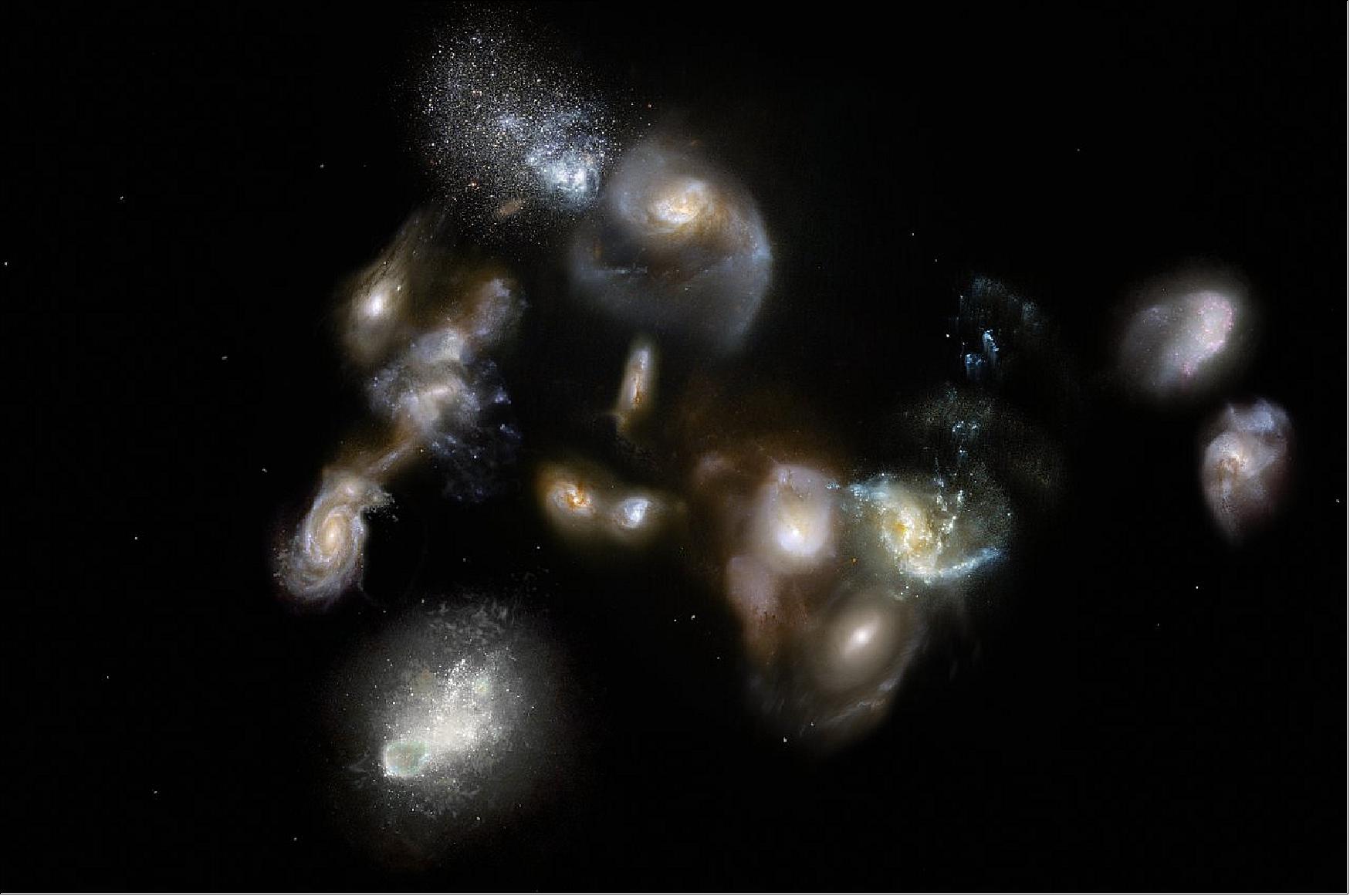
• March 7, 2018: This spectacular and unusual image of Figure 22 shows part of the famous Orion Nebula, a star formation region lying about 1350 light-years from Earth. It combines a mosaic of millimeter-wavelength images from the ALMA (Atacama Large Millimeter/submillimeter Array) and the IRAM (Institut de Radioastronomie Millimétrique) 30 m telescope, shown in red, with a more familiar infrared view from the HAWK-I (High Acuity Wide-field K-band Imager) instrument on ESO's VLT (Very Large Telescope), shown in blue. The group of bright blue-white stars at the upper-left is the Trapezium Cluster — made up of hot young stars that are only a few million years old. 24)
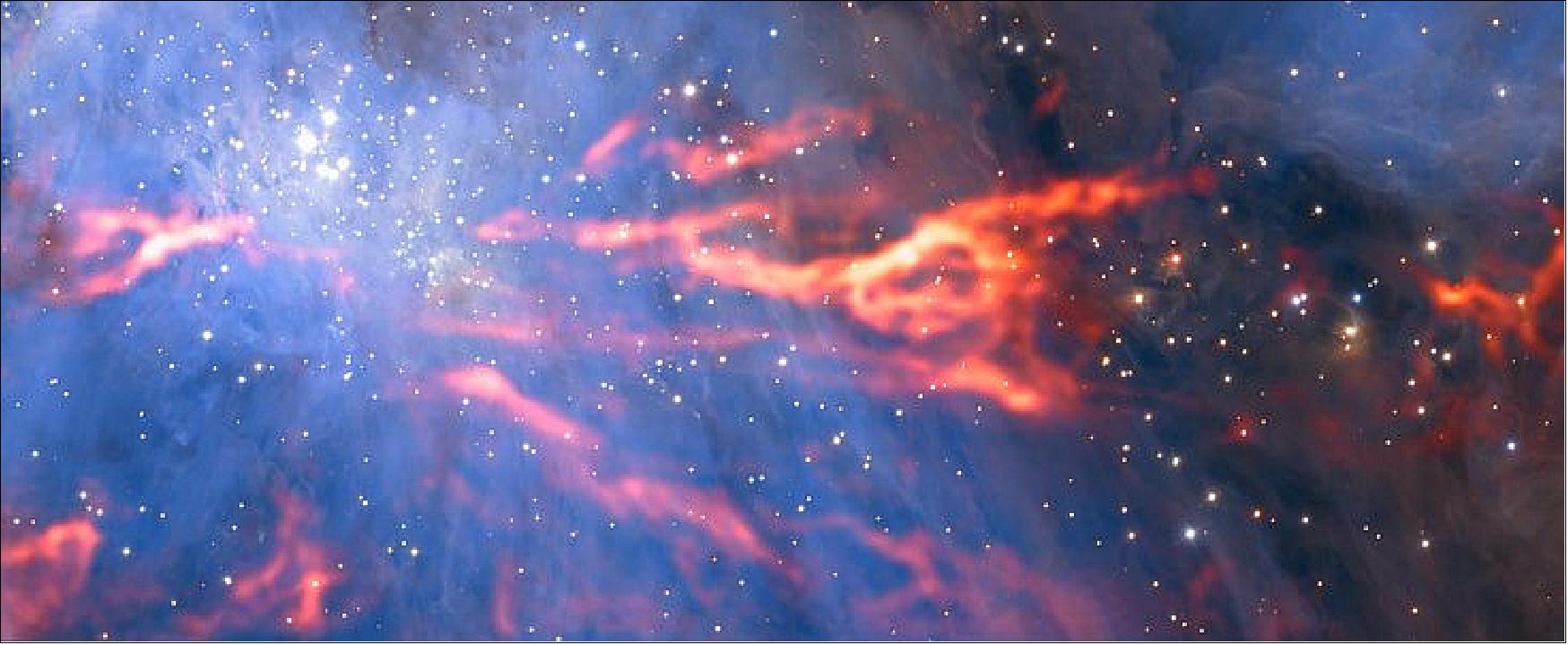
- The wispy, fiber-like structures seen in this large image are long filaments of cold gas, only visible to telescopes working in the millimeter wavelength range. They are invisible at both optical and infrared wavelengths, making ALMA one of the only instruments available for astronomers to study them. This gas gives rise to newborn stars — it gradually collapses under the force of its own gravity until it is sufficiently compressed to form a protostar — the precursor to a star.
- The scientists, who gathered the data from which this image was created, were studying these filaments to learn more about their structure and make-up. They used ALMA to look for signatures of diazenylium gas, which makes up part of these structures. Through doing this study, the team managed to identify a network of 55 filaments.
- The Orion Nebula is the nearest region of massive star formation to Earth, and is therefore studied in great detail by astronomers seeking to better understand how stars form and evolve in their first few million years. ESO's telescopes have observed this interesting region multiple times, and you can learn more about previous discoveries here, here, and here.
- This image combines a total of 296 separate individual datasets from the ALMA and IRAM telescopes, making it one of the largest high-resolution mosaics of a star formation region produced so far at millimeter wavelengths.
• February 26, 2018: Space weather emitted by Proxima Centauri, the star closest to our sun, may make that system rather inhospitable to life after all. Using data from ALMA (Atacama Large Millimeter/submillimeter Array), a team of astronomers discovered that a powerful stellar flare erupted from Proxima Centauri in March 2017 (Figure 23). This finding, published in the Astrophysical Journal Letters, raises questions about the habitability of our solar system's nearest exoplanetary neighbor, Proxima b, which orbits Proxima Centauri. 25) 26)
- At its peak, the newly recognized flare was 10 times brighter than our sun's largest flares, when observed at similar wavelengths. Stellar flares have not been well studied at the millimeter and submillimeter wavelengths detected by ALMA, especially around stars of Proxima Centauri's type, called M dwarfs, which are the most common in our galaxy.
- "March 24, 2017, was no ordinary day for Proxima Cen," said Meredith MacGregor, an astronomer at the Carnegie Institution for Science, Department of Terrestrial Magnetism in Washington, D.C., who led the research with fellow Carnegie astronomer Alycia Weinberger. Along with colleagues from the Harvard-Smithsonian Center for Astrophysics, David Wilner and Adam Kowalski, and Steven Cranmer of the University of Colorado Boulder — they discovered the enormous flare when they reanalyzed ALMA observations taken last year.
- The flare increased Proxima Centauri's brightness by 1,000 times over 10 seconds. This was preceded by a smaller flare; taken together, the whole event lasted fewer than two minutes of the 10 hours that ALMA observed the star between January and March of last year (Figure 24).
- Stellar flares happen when a shift in the star's magnetic field accelerates electrons to speeds approaching that of light. The accelerated electrons interact with the highly charged plasma that makes up most of the star, causing an eruption that produces emission across the entire electromagnetic spectrum.
- "It's likely that Proxima b was blasted by high energy radiation during this flare," MacGregor explained, adding that it was already known that Proxima Centauri experienced regular, although smaller, X-ray flares. "Over the billions of years since Proxima b formed, flares like this one could have evaporated any atmosphere or ocean and sterilized the surface, suggesting that habitability may involve more than just being the right distance from the host star to have liquid water."
- An earlier paper that also used the same ALMA data interpreted its average brightness, which included the light output of both the star and the flare together, as being caused by multiple disks of dust encircling Proxima Centauri, not unlike our own solar system's asteroid and Kuiper belts.
- But when MacGregor, Weinberger, and their team looked at the ALMA data as a function of observing time, instead of averaging it all together, they were able to see the transient explosion of radiation emitted from Proxima Centauri for what it truly was.
- "There is now no reason to think that there is a substantial amount of dust around Proxima Cen," Weinberger said. "Nor is there any information yet that indicates the star has a rich planetary system like ours."
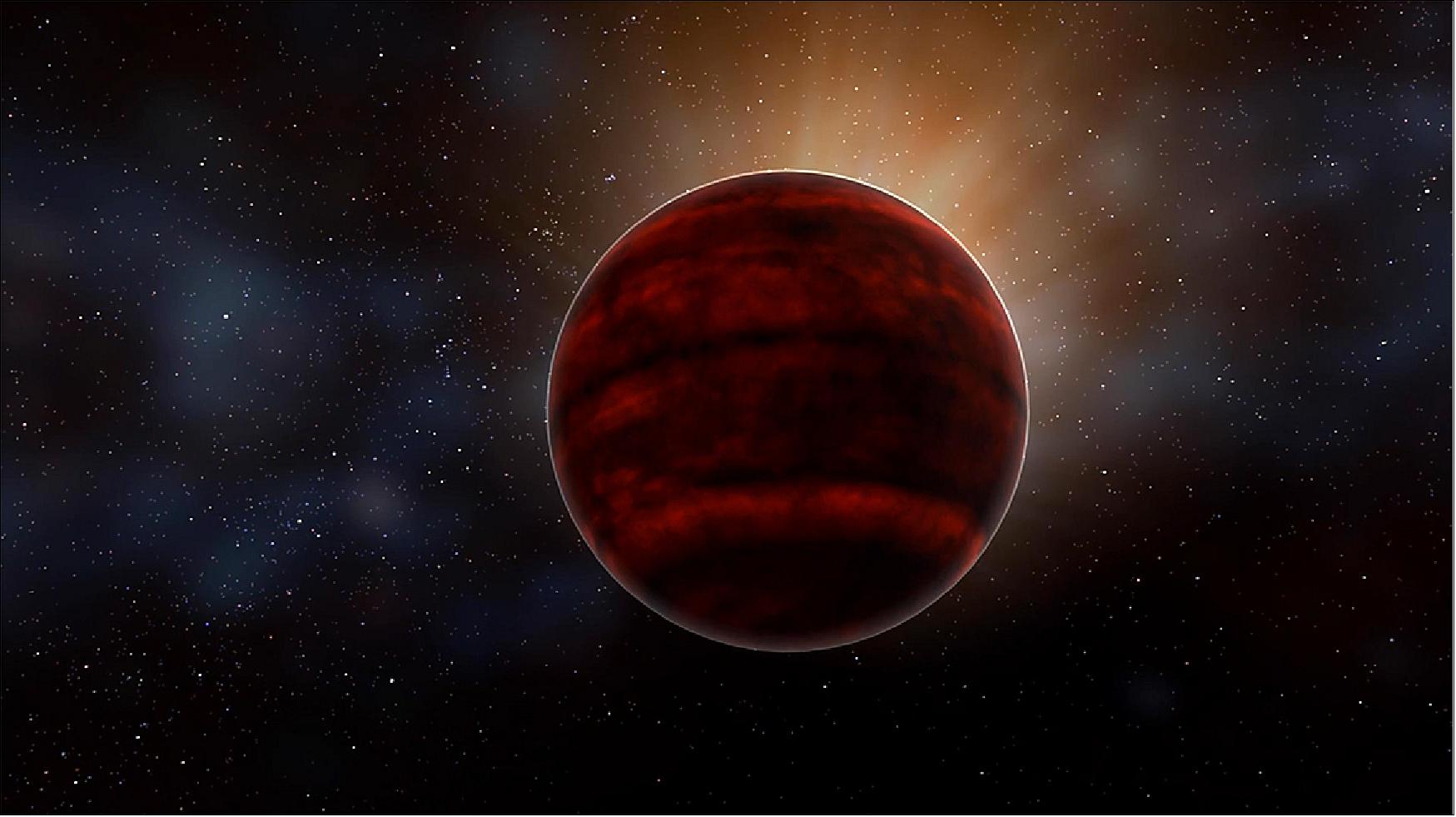
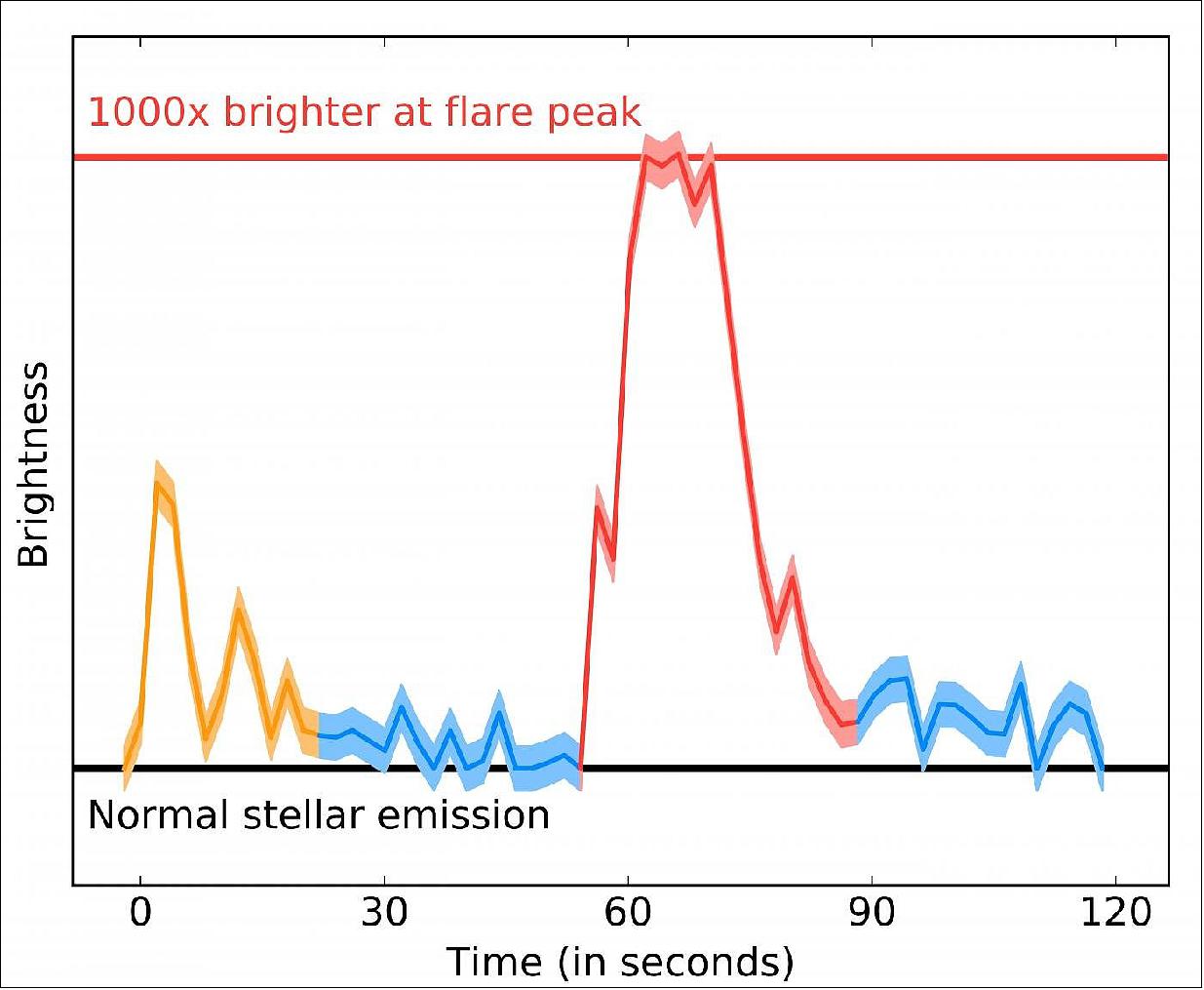
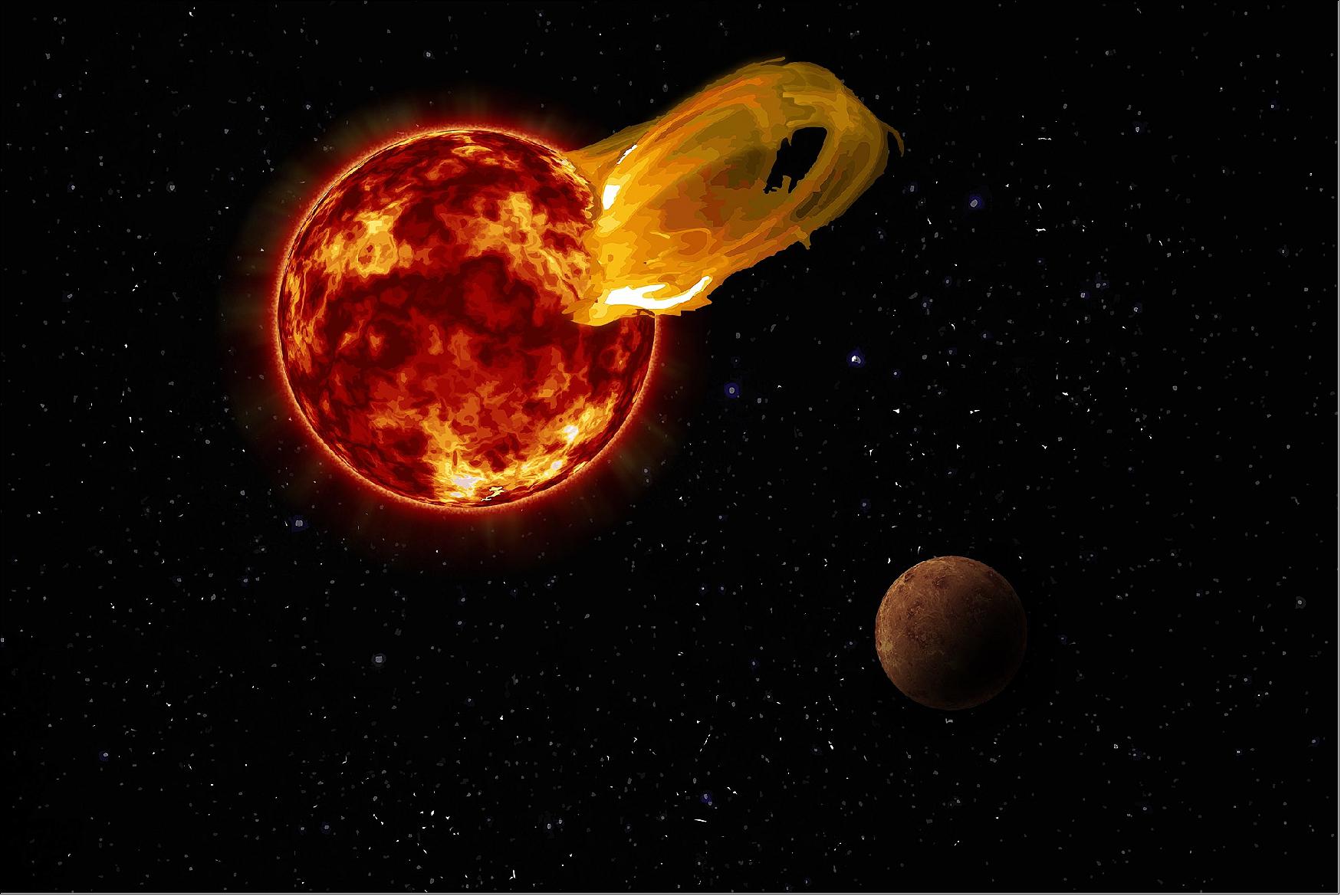
• February 14, 2018: High resolution observations with ALMA imaged a rotating dusty gas torus around an active supermassive black hole. The existence of such rotating donuts-shape structures was first suggested decades ago, but this is the first time one has been confirmed so clearly. This is an important step in understanding the co-evolution of supermassive black holes and their host galaxies. 27) 28)
- Almost all galaxies hold concealed monstrous black holes in their centers. Researchers have known for a long time that the more massive the galaxy is, the more massive the central black hole is. This sounds reasonable at first, but host galaxies are 10 billion times bigger than the central black holes; it should be difficult for two objects of such vastly different scales to directly affect each other. So how could such a relation develop?
- Aiming to solve this shadowy problem, a team of astronomers utilized the high resolution of ALMA to observe the center of spiral galaxy M77. The central region of M77 is an "active galactic nucleus," or AGN, which means that matter is vigorously falling toward the central supermassive black hole and emitting intense light. AGNs can strongly affect the surrounding environment, therefore they are important objects for solving the mystery of the co-evolution of galaxies and black holes.
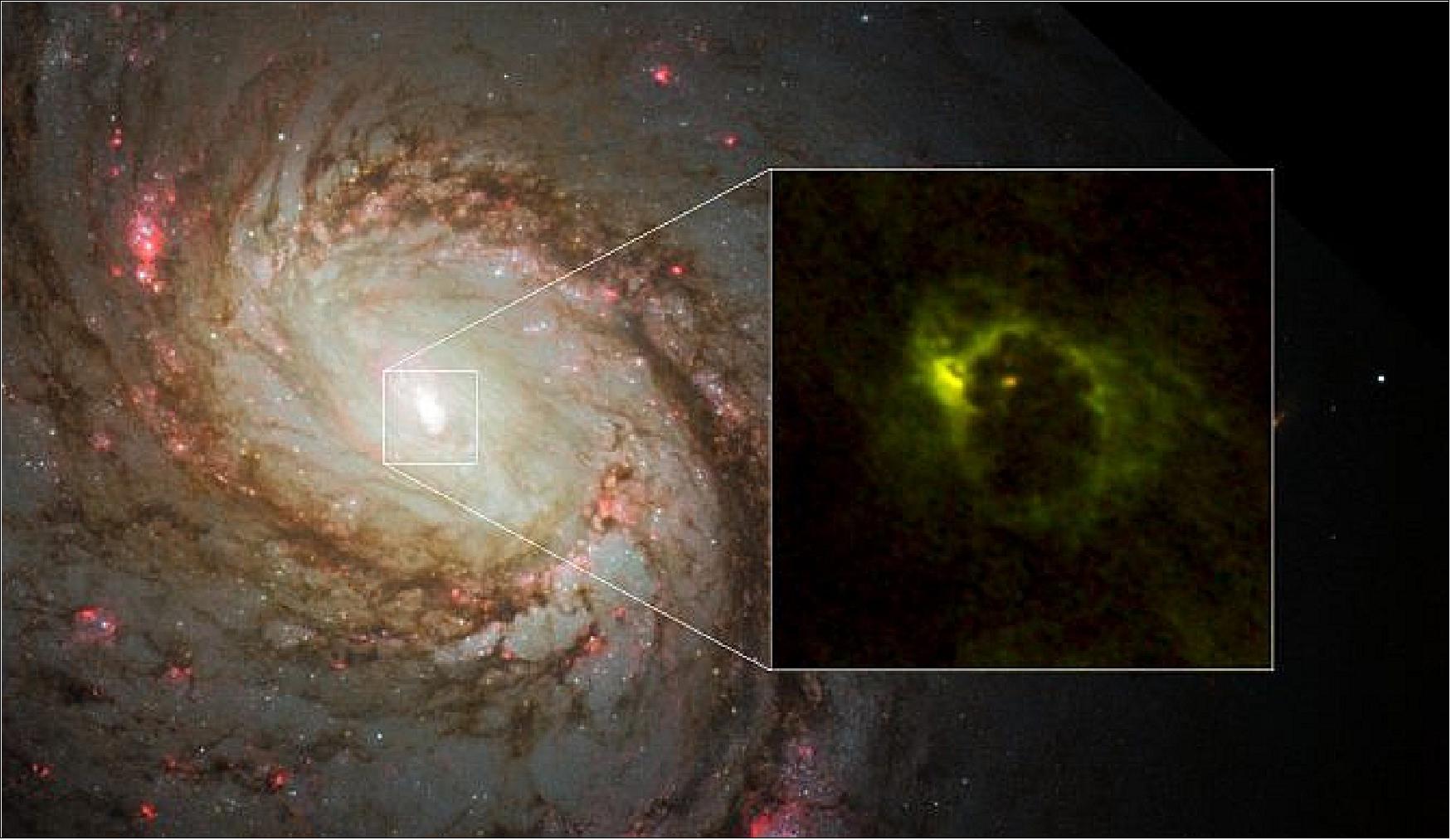
- The team imaged the area around the supermassive black hole in M77 and resolved a compact gaseous structure with a radius of 20 light-years. And, the astronomers found that the compact structure is rotating around the black hole, as expected.
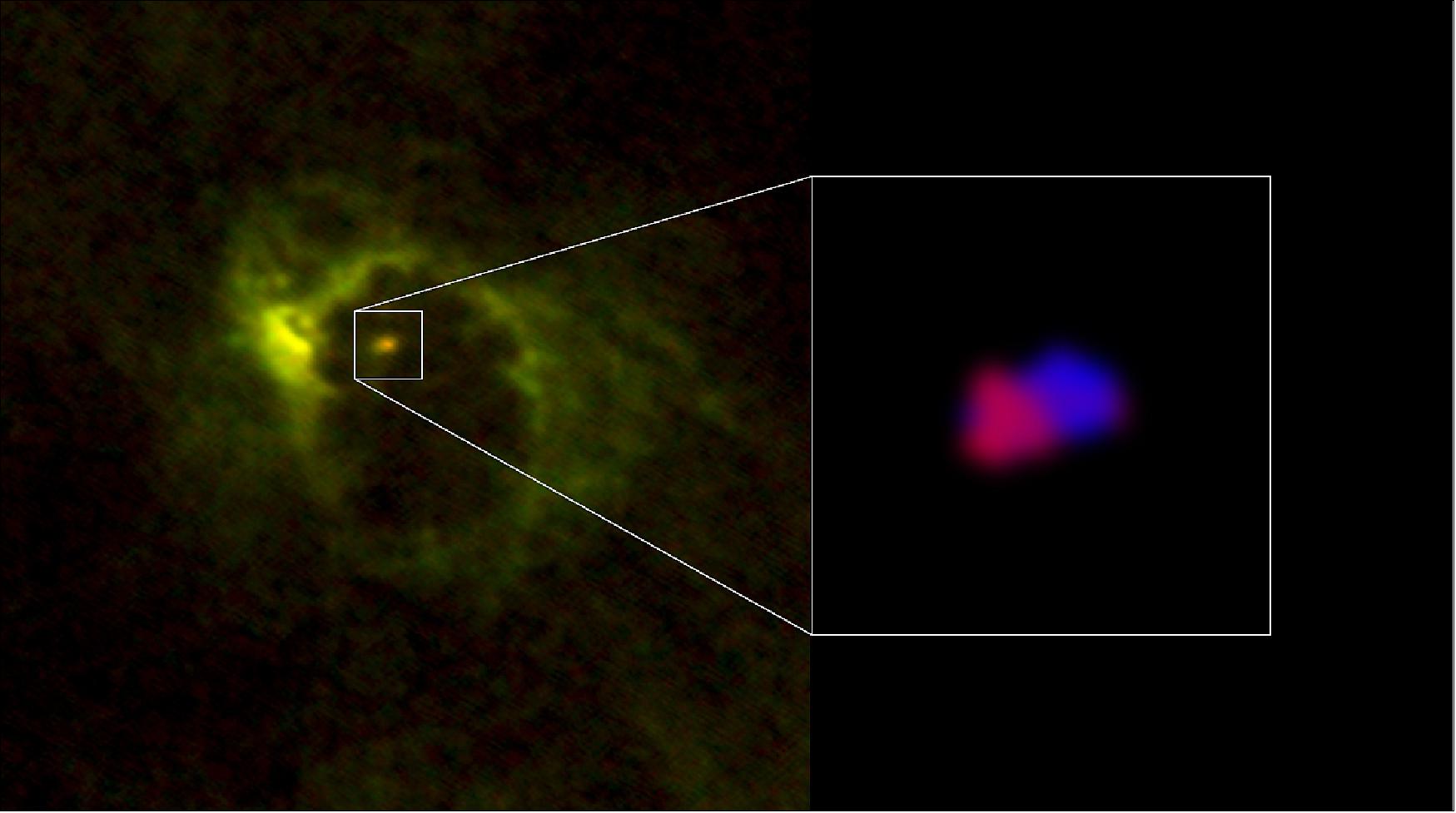
- "To interpret various observational features of AGNs, astronomers have assumed rotating donut-like structures of dusty gas around active supermassive black holes. This is called the ‘unified model' of AGN," explained Masatoshi Imanishi of NAOJ (National Astronomical Observatory of Japan), the lead author on a paper published in the Astrophysical Journal Letters. "However, the dusty gaseous donut is very tiny in appearance. With the high resolution of ALMA, now we can directly see the structure."
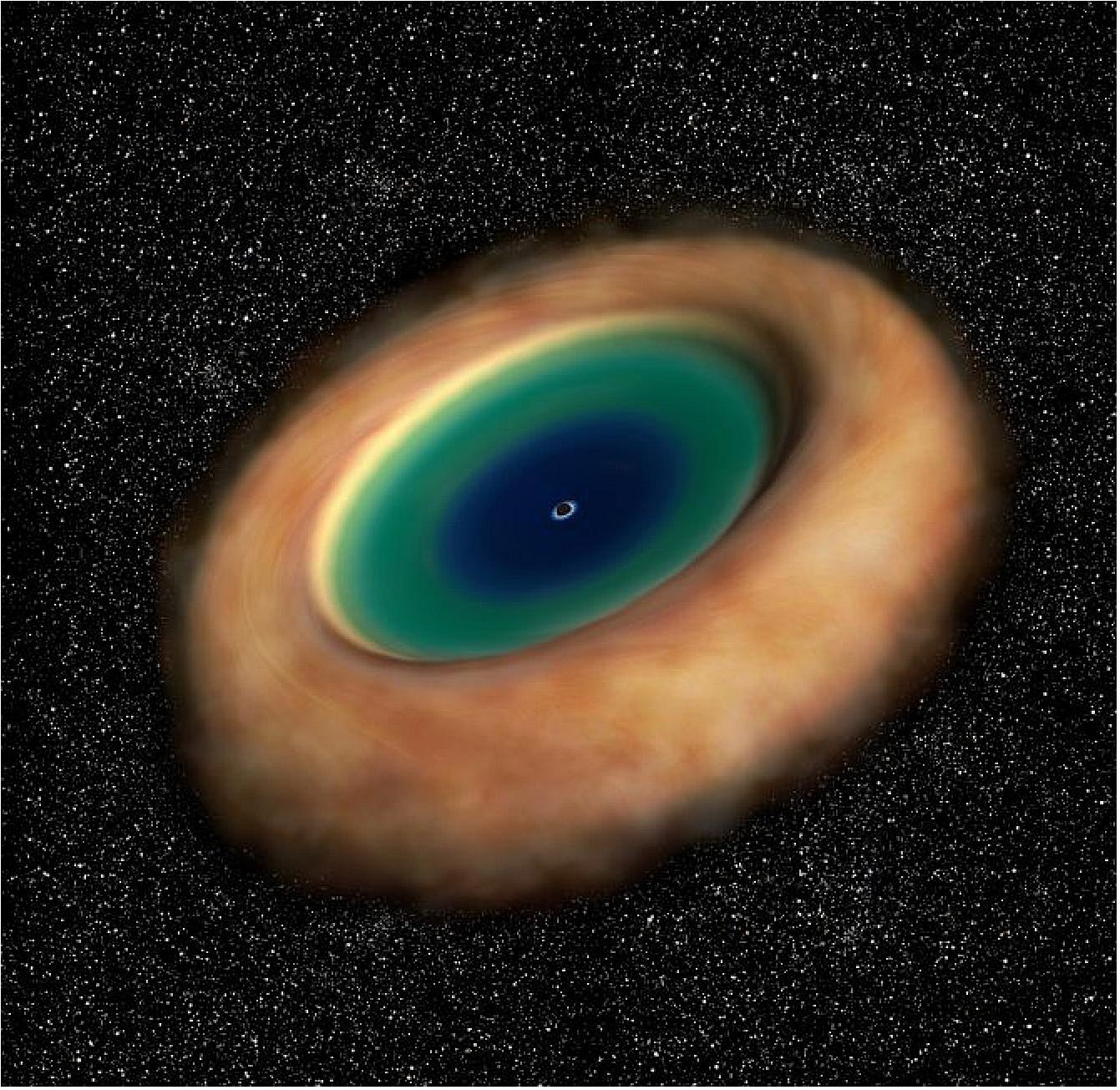
- Many astronomers have observed the center of M77 before, but never has the rotation of the gas donut around the black hole been seen so clearly. Besides the superior resolution of ALMA, the selection of molecular emission lines to observe was key to revealing the structure. The team observed specific microwave emission from hydrogen cyanide molecules (HCN) and formyl ions (HCO+). These molecules emit microwaves only in dense gas, whereas the more frequently observed carbon monoxide (CO) emits microwaves under a variety of conditions . The torus around the AGN is assumed to be very dense, and the team's strategy was right on the mark.
- "Previous observations have revealed the east-west elongation of the dusty gaseous torus. The dynamics revealed from our ALMA data agrees exactly with the expected rotational orientation of the torus," said Imanishi.
- Interestingly, the distribution of gas around the supermassive black hole is much more complicated than what a simple unified model suggests. The torus seems to have an asymmetry and the rotation is not just following the gravity of the black hole but also contains highly random motion. These facts could indicate the AGN had a violent history, possibly including a merger with a small galaxy . Nevertheless, the identification of the rotating torus is an important step.
- The Milky Way Galaxy, where we live, also has a supermassive black hole at its center. This black hole is, however, in a very quiet state. Only a tiny amount of gas is accreting onto it. Therefore, to investigate an AGN in detail, astronomers need to observe the centers of distant galaxies. M77 is one of the nearest AGN and a suitable object for peering into the very center in detail.
• November 3, 2017: The ALMA Observatory in Chile has detected dust around the closest star to the Solar System, Proxima Centauri. These new observations reveal the glow coming from cold dust in a region between one to four times as far from Proxima Centauri as the Earth is from the Sun. The data also hint at the presence of an even cooler outer dust belt and may indicate the presence of an elaborate planetary system. These structures are similar to the much larger belts in the Solar System and are also expected to be made from particles of rock and ice that failed to form planets. 29)
- Proxima Centauri is the closest star to the Sun. It is a faint red dwarf lying just four light-years away in the southern constellation of Centaurus (The Centaur). It is orbited by the Earth-sized temperate world Proxima b, discovered in 2016 and the closest planet to the Solar System. But there is more to this system than just a single planet. The new ALMA observations reveal emission from clouds of cold cosmic dust surrounding the star.
- The lead author of the new study, Guillem Anglada, from the Instituto de Astrofísica de Andalucía (CSIC), Granada, Spain, explains the significance of this find: "The dust around Proxima is important because, following the discovery of the terrestrial planet Proxima b, it's the first indication of the presence of an elaborate planetary system, and not just a single planet, around the star closest to our Sun." 30)
- Dust belts are the remains of material that did not form into larger bodies such as planets. The particles of rock and ice in these belts vary in size from the tiniest dust grain, smaller than a millimeter across, up to asteroid-like bodies many kilometers in diameter.
- Dust appears to lie in a belt that extends a few hundred million kilometers from Proxima Centauri and has a total mass of about one hundredth of the Earth's mass. This belt is estimated to have a temperature of about –230 degrees Celsius, as cold as that of the Kuiper Belt in the outer Solar System.
- There are also hints in the ALMA data of another belt of even colder dust about ten times further out. If confirmed, the nature of an outer belt is intriguing, given its very cold environment far from a star that is cooler and fainter than the Sun. Both belts are much further from Proxima Centauri than the planet Proxima b, which orbits at just four million kilometers from its parent star.
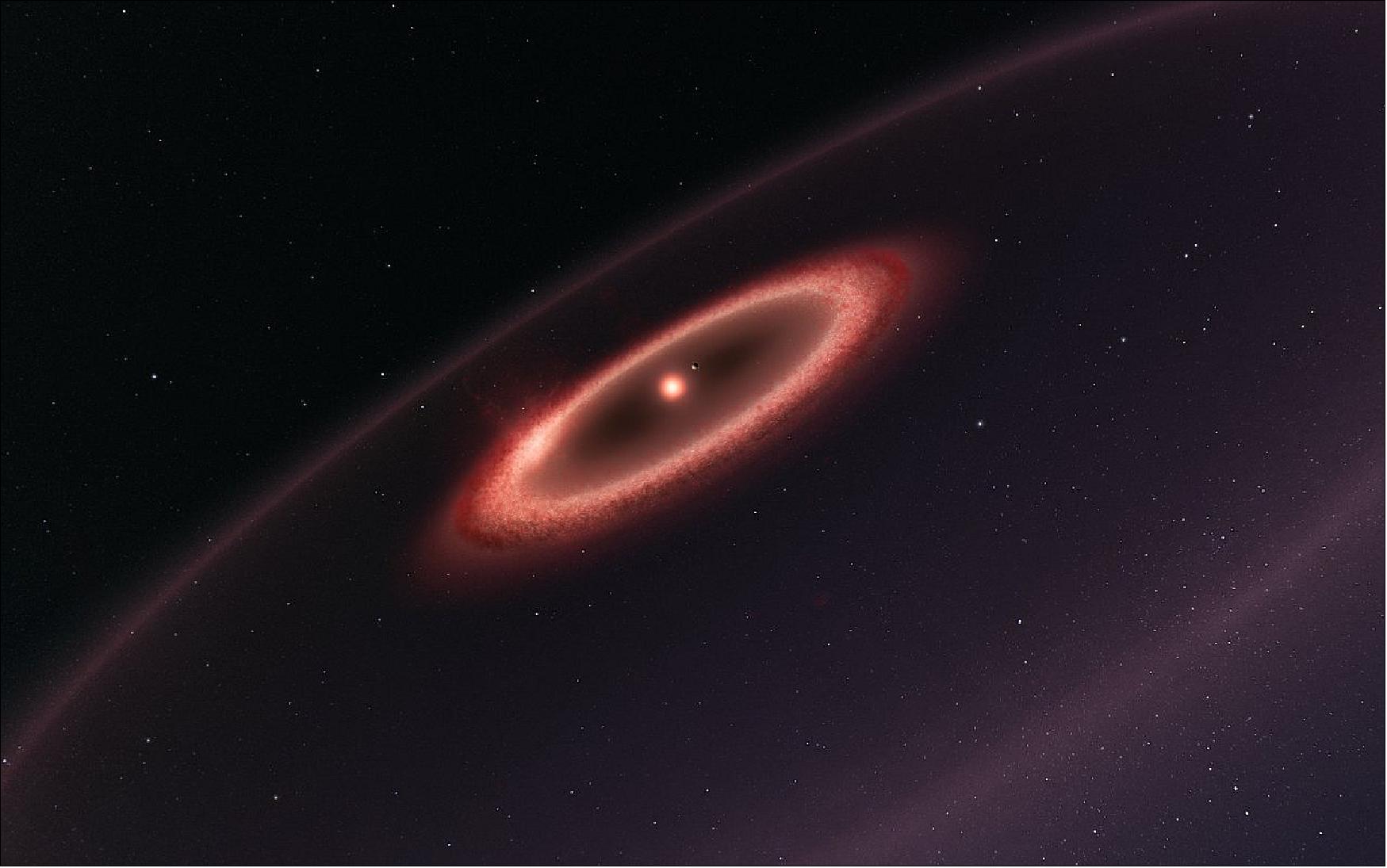
• October 2, 2017: Using data captured by ALMA in Chile and from the ROSINA instrument on ESA's Rosetta mission, a team of astronomers has found faint traces of the chemical compound Freon-40 (CH3Cl), also known as methyl chloride and chloromethane, around both the infant star system IRAS 16293-2422 32), about 400 light-years away, and the famous comet 67P/Churyumov-Gerasimenko (67P/C-G) in our own Solar System. The new ALMA observation is the first detection ever of a stable organohalogen in interstellar space. 33) 34)
- Organohalogens consist of halogens, such as chlorine and fluorine, bonded with carbon and sometimes other elements. On Earth, these compounds are created by some biological processes — in organisms ranging from humans to fungi — as well as by industrial processes such as the production of dyes and medical drugs.
- This new discovery of one of these compounds, Freon-40, in places that must predate the origin of life, can be seen as a disappointment, as earlier research had suggested that these molecules could indicate the presence of life.
- "Finding the organohalogen Freon-40 near these young, Sun-like stars was surprising," said Edith Fayolle, a researcher with the Harvard-Smithsonian Center for Astrophysics in Cambridge, Massachusetts in the USA, and lead author of the new paper. "We simply didn't predict its formation and were surprised to find it in such significant concentrations. It's clear now that these molecules form readily in stellar nurseries, providing insights into the chemical evolution of planetary systems, including our own." 35)
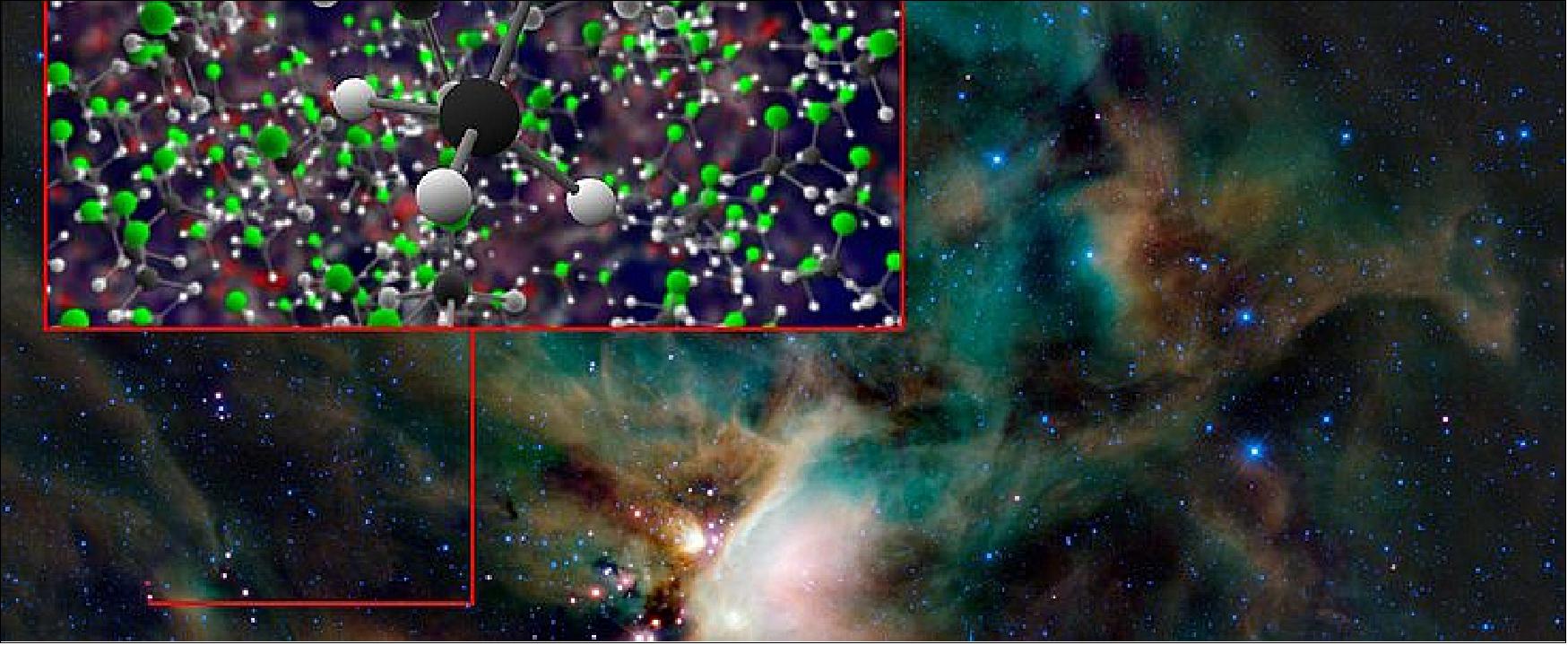
• June 26, 2017: Betelgeuse is one of the largest stars currently known — with a radius around 1400 times larger than the Sun's in the millimeter continuum. About 600 light-years away in the constellation of Orion (The Hunter) in the Milky Way, the red supergiant burns brightly, causing it to have only a short life expectancy. The star is just about eight million years old, but is already on the verge of becoming a supernova. When that happens, the resulting explosion will be visible from Earth, even in broad daylight. 36) 37)
The star has been observed in many other wavelengths, particularly in the visible, infrared, and ultraviolet. Using ESO's Very Large Telescope, astronomers discovered a vast plume of gas almost as large as our Solar System. Astronomers have also found a gigantic bubble that boils away on Betelgeuse's surface. These features help to explain how the star is shedding gas and dust at tremendous rates (eso0927, eso1121). In this picture, ALMA observes the hot gas of the lower chromosphere of Betelgeuse at sub-millimeter wavelengths — where localized increased temperatures explain why it is not symmetric. Scientifically, ALMA can help us to understand the extended atmospheres of these hot, blazing stars.
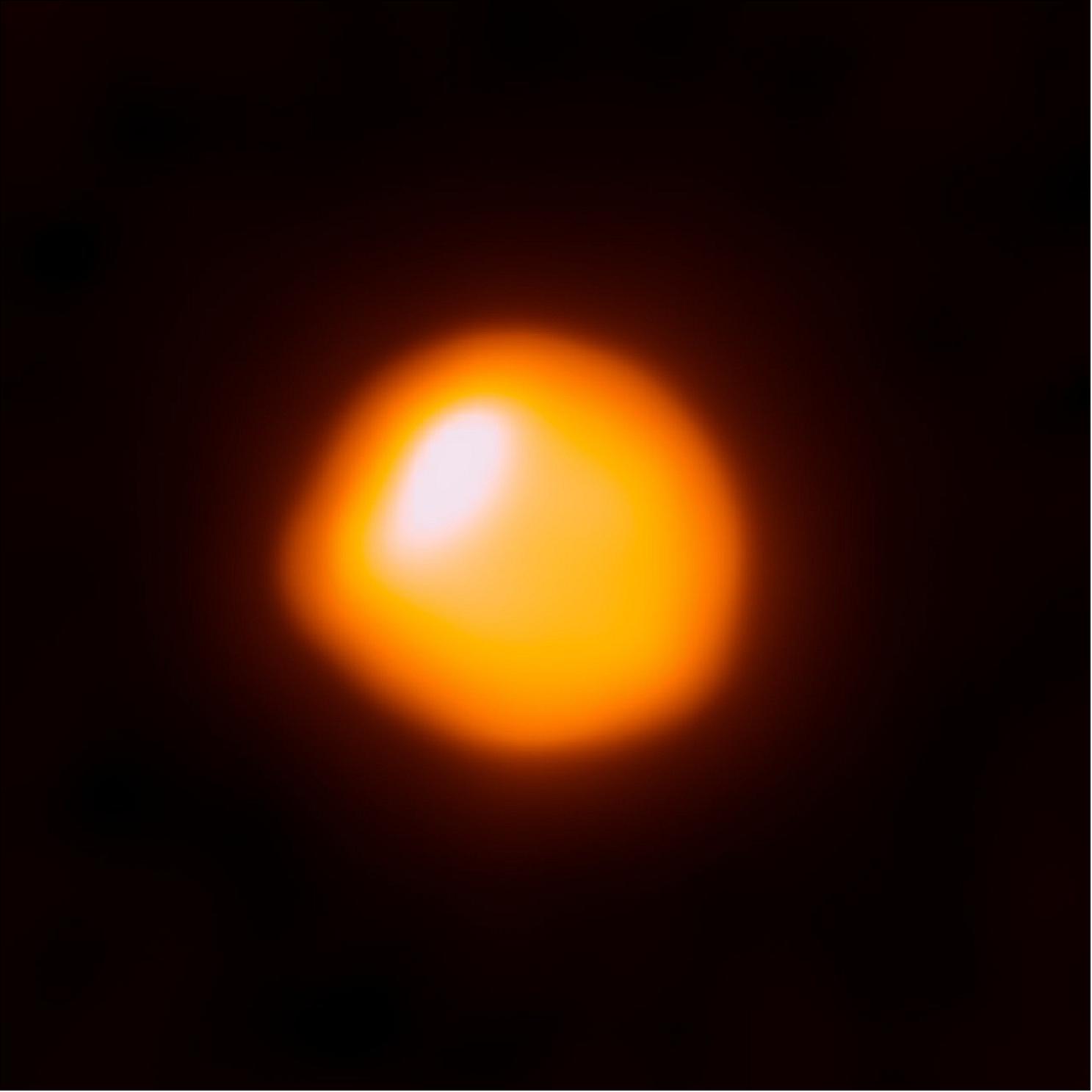

• May 18, 2017: An international team of astronomers using the ALMA (Atacama Large Millimeter/submillimeter Array) has made the first complete millimeter-wavelength image of the ring of dusty debris surrounding the young star Fomalhaut. This remarkably well-defined band of rubble and gas is likely the result of exocomets smashing together near the outer edges of a planetary system 25 light-years from Earth. Observations Suggest Chemical Kinship to Comets in Our Own Solar System. 39) 40)
- Earlier ALMA observations of Fomalhaut — taken in 2012 when the telescope was still under construction – revealed only about one half of the debris disk. Though this first image was merely a test of ALMA's initial capabilities, it nonetheless provided tantalizing hints about the nature and possible origin of the disk.
- The new ALMA observations offer a stunningly complete view of this glowing band of debris and suggest that there are chemical similarities between its icy contents and comets in our own solar system.
- "ALMA has given us this staggeringly clear image of a fully formed debris disk," said Meredith MacGregor, an astronomer at the Harvard-Smithsonian Center for Astrophysics in Cambridge, Massachusetts, USA, and lead author on one of two papers accepted for publication in the Astrophysical Journal describing these observations. "We can finally see the well-defined shape of the disk, which may tell us a great deal about the underlying planetary system responsible for its highly distinctive appearance."
- Fomalhaut is a relatively nearby star system and one of only about 20 in which planets have been imaged directly. The entire system is approximately 440 million years old, or about one-tenth the age of our solar system.
- As revealed in the new ALMA image (Figure 33), a brilliant band of icy dust about 2 billion kilometers wide has formed approximately 20 billion kilometers from the star.
- Debris disks are common features around young stars and represent a very dynamic and chaotic period in the history of a solar system. Astronomers believe they are formed by the ongoing collisions of comets and other planetesimals in the outer reaches of a recently formed planetary system. The leftover debris from these collisions absorbs light from its central star and reradiates that energy as a faint millimeter-wavelength glow that can be studied with ALMA.
- Using the new ALMA data and detailed computer modeling, the researchers could calculate the precise location, width, and geometry of the disk. These parameters confirm that such a narrow ring is likely produced through the gravitational influence of planets in the system, noted MacGregor.
![Figure 33: Composite image of the Fomalhaut star system. The ALMA data, shown in orange, reveal the distant and eccentric debris disk in never-before-seen detail. The central dot is the unresolved emission from the star, which is about twice the mass of the Sun. Optical data from the Hubble Space Telescope is in blue; the dark region is a coronagraphic mask, which filtered out the otherwise overwhelming light of the central star [image credit: ALMA (ESO/NAOJ/NRAO), M. MacGregor; NASA/ESA Hubble, P. Kalas; B. Saxton (NRAO/AUI/NSF)]](/api/cms/documents/163813/5433030/Alma2018_Auto1E.jpeg)
- The new ALMA observations are also the first to definitively show "apocenter glow," a phenomenon predicted in a 2016 paper by lead author Margaret Pan, a scientist at MIT (Massachusetts Institute of Technology) in Cambridge and co-author on the new ALMA papers. Like all objects with elongated orbits, the dusty material in the Fomalhaut disk travels more slowly when it is farthest from the star. As the dust slows down, it piles up, forming denser concentrations in the more distant portions of the disk. These dense regions can be seen by ALMA as brighter millimeter-wavelength emission.
- Using the same ALMA dataset, but focusing on distinct millimeter-wavelength signals naturally emitted by molecules in space, the researchers also detected vast stores of carbon monoxide gas in precisely the same location as the debris disk.
- "These data allowed us to determine that the relative abundance of carbon monoxide plus carbon dioxide around Fomalhaut is about the same as found in comets in our own solar system," said Luca Matrà with the University of Cambridge, UK, and lead author on the team's second paper. "This chemical kinship may indicate a similarity in comet formation conditions between the outer reaches of this planetary system and our own." Matrà and his colleagues believe this gas is either released from continuous comet collisions or the result of a single, large impact between supercomets hundreds of times more massive than Hale-Bopp. 41)
- The presence of this well-defined debris disk around Fomalhaut, along with its curiously familiar chemistry, may indicate that this system is undergoing its own version of the Late Heavy Bombardment, a period approximately 4 billion years ago when the Earth and other planets were routinely struck by swarms of asteroids and comets left over from the formation of the Solar System.
- "Twenty years ago, the best millimeter-wavelength telescopes gave the first fuzzy maps of sand grains orbiting Fomalhaut. Now with ALMA's full capabilities the entire ring of material has been imaged," concluded Paul Kalas, an astronomer at the University of California at Berkeley and principal investigator on these observations. "One day we hope to detect the planets that influence the orbits of these grains."

• April 12, 2017: Using ALMA, astronomers have revealed extraordinary details about a recently discovered far-flung member of our solar system, the planetary body 2014 UZ224, more informally known as DeeDee. 42) 43)
- At about three times the current distance of Pluto from the Sun, DeeDee is the second most distant known trans-Neptunian object (TNO) with a confirmed orbit, surpassed only by the dwarf planet Eris. Astronomers estimate that there are tens-of-thousands of these icy bodies in the outer solar system beyond the orbit of Neptune.
- The new ALMA data reveal, for the first time, that DeeDee is roughly 635 km across, or about two-thirds the diameter of the dwarf planet Ceres, the largest member of our asteroid belt. At this size, DeeDee should have enough mass to be spherical, the criterion necessary for astronomers to consider it a dwarf planet, though it has yet to receive that official designation.
- "Far beyond Pluto is a region surprisingly rich with planetary bodies. Some are quite small but others have sizes to rival Pluto, and could possibly be much larger," said David Gerdes, a scientist with the University of Michigan and lead author on a paper appearing in the Astrophysical Journal Letters. "Because these objects are so distant and dim, it's incredibly difficult to even detect them, let alone study them in any detail. ALMA, however, has unique capabilities that enabled us to learn exciting details about these distant worlds." 44)
- Currently, DeeDee is about 92 astronomical units (AU) from the Sun. An astronomical unit is the average distance from the Earth to the Sun, or about 150 million kilometers. At this tremendous distance, it takes DeeDee more than 1,100 Earth years to complete one orbit. Light from DeeDee takes nearly 13 hours to reach Earth.
- Gerdes and his team announced the discovery of DeeDee in the fall of 2016. They found it using the 4 m Blanco telescope at the Cerro Tololo Inter-American Observatory in Chile as part of ongoing observations for the Dark Energy Survey, an optical survey of about 12 percent of the sky that seeks to understand the as-yet mysterious force that is accelerating the expansion of the universe.
- The Dark Energy Survey produces vast troves of astronomical images, which give astronomers the opportunity to also search for distant solar system objects. The initial search, which includes nearly 15,000 images, identified more than 1.1 billion candidate objects. The vast majority of these turned out to be background stars and even more distant galaxies. A small fraction, however, were observed to move slowly across the sky over successive observations, the telltale sign of a TNO.
- One such object was identified on 12 separate images. The astronomers informally dubbed it DeeDee, which is short for Distant Dwarf.
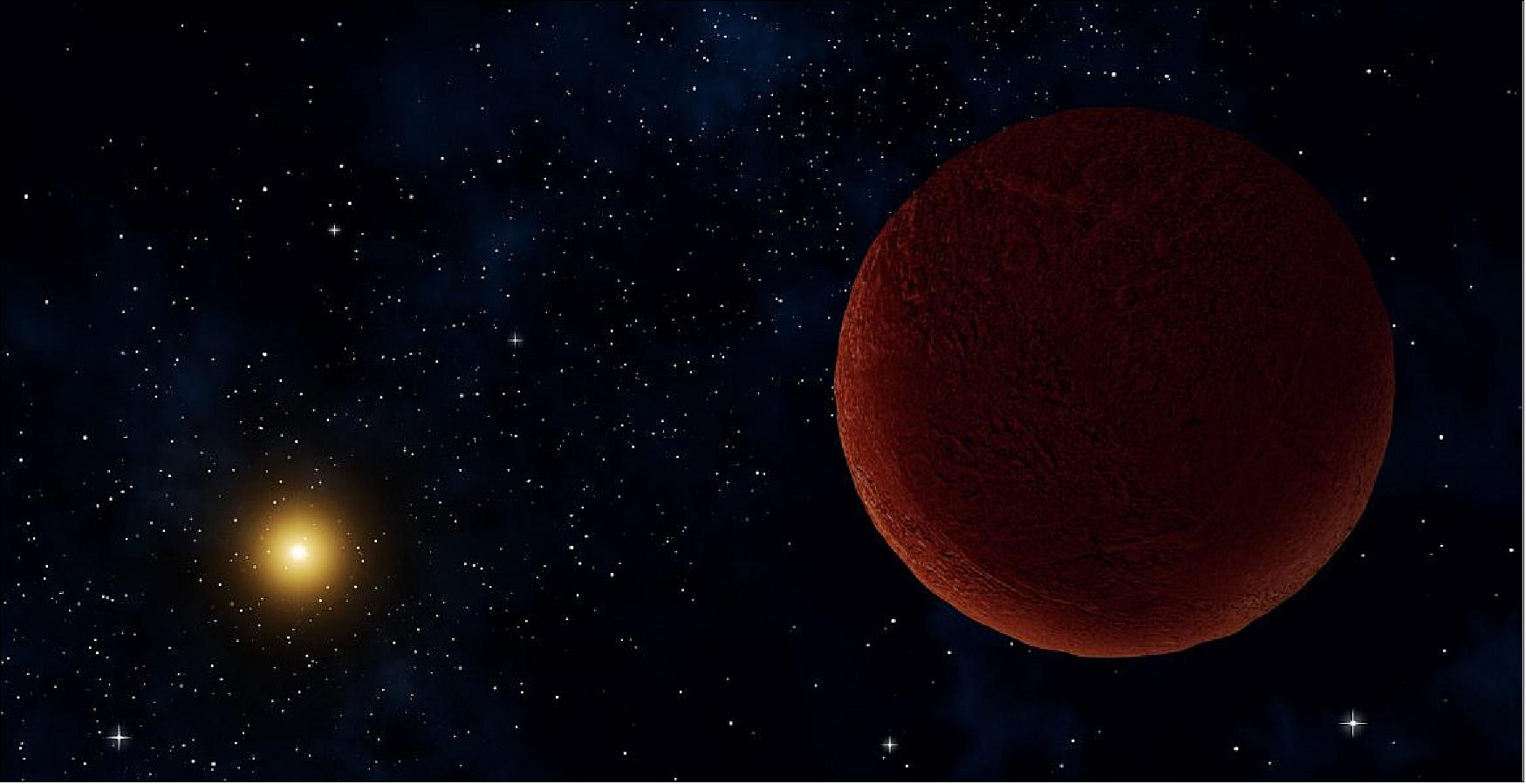
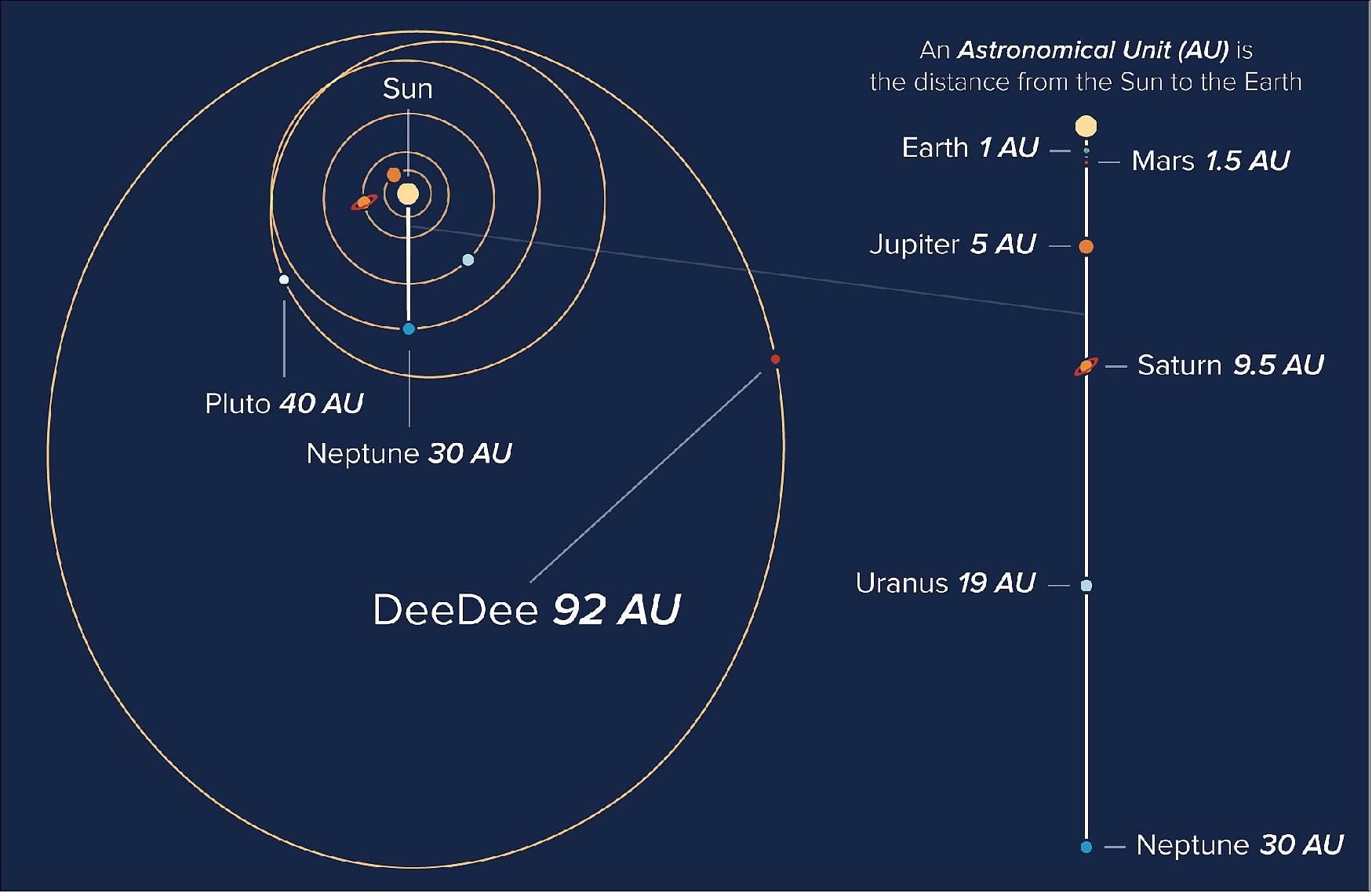
• March 8, 2017: An international team of astronomers, led by Nicolas Laporte of University College London, have used ALMA to observe A2744_YD4, the youngest and most remote galaxy ever seen by ALMA. They were surprised to find that this youthful galaxy contained an abundance of interstellar dust — dust formed by the deaths of an earlier generation of stars. 45) 46)
- Follow-up observations using the X-shooter instrument on ESO's Very Large Telescope confirmed the enormous distance to A2744_YD4. The galaxy appears to us as it was when the Universe was only 600 million years old, during the period when the first stars and galaxies were forming. This time corresponds to a redshift of z=8.38, during the epoch of reionization. "Not only is A2744_YD4 the most distant galaxy yet observed by ALMA," comments Nicolas Laporte, "but the detection of so much dust indicates early supernovae must have already polluted this galaxy."
- Cosmic dust is mainly composed of silicon, carbon and aluminum, in grains as small as a millionth of a centimeter across. The chemical elements in these grains are forged inside stars and are scattered across the cosmos when the stars die, most spectacularly in supernova explosions, the final fate of short-lived, massive stars. Today, this dust is plentiful and is a key building block in the formation of stars, planets and complex molecules; but in the early Universe — before the first generations of stars died out — it was scarce.
- The observations of the dusty galaxy A2744_YD4 were made possible because this galaxy lies behind a massive galaxy cluster called Abell 2744. Because of a phenomenon called gravitational lensing, the cluster acted like a giant cosmic "telescope" to magnify the more distant A2744_YD4 by about 1.8 times, allowing the team to peer far back into the early Universe.
- The ALMA observations also detected the glowing emission of ionized oxygen from A2744_YD4. This is the most distant, and hence earliest, detection of oxygen in the Universe, surpassing another ALMA result from 2016.
- The detection of dust in the early Universe provides new information on when the first supernovae exploded and hence the time when the first hot stars bathed the Universe in light. Determining the timing of this "cosmic dawn" is one of the holy grails of modern astronomy, and it can be indirectly probed through the study of early interstellar dust.
- The team estimates that A2744_YD4 contained an amount of dust equivalent to 6 million times the mass of our Sun, while the galaxy's total stellar mass — the mass of all its stars — was 2 billion times the mass of our Sun. The team also measured the rate of star formation in A2744_YD4 and found that stars are forming at a rate of 20 solar masses per year — compared to just one solar mass per year in the Milky Way. This rate means that the total mass of the stars formed every year is equivalent to 20 times the mass of the Sun.
- "This rate is not unusual for such a distant galaxy, but it does shed light on how quickly the dust in A2744_YD4 formed," explains Richard Ellis (ESO and University College London), a co-author of the study. "Remarkably, the required time is only about 200 million years — so we are witnessing this galaxy shortly after its formation."
- This means that significant star formation began approximately 200 million years before the epoch at which the galaxy is being observed. This provides a great opportunity for ALMA to help study the era when the first stars and galaxies "switched on" — the earliest epoch yet probed. Our Sun, our planet and our existence are the products — 13 billion years later — of this first generation of stars. By studying their formation, lives and deaths, we are exploring our origins.
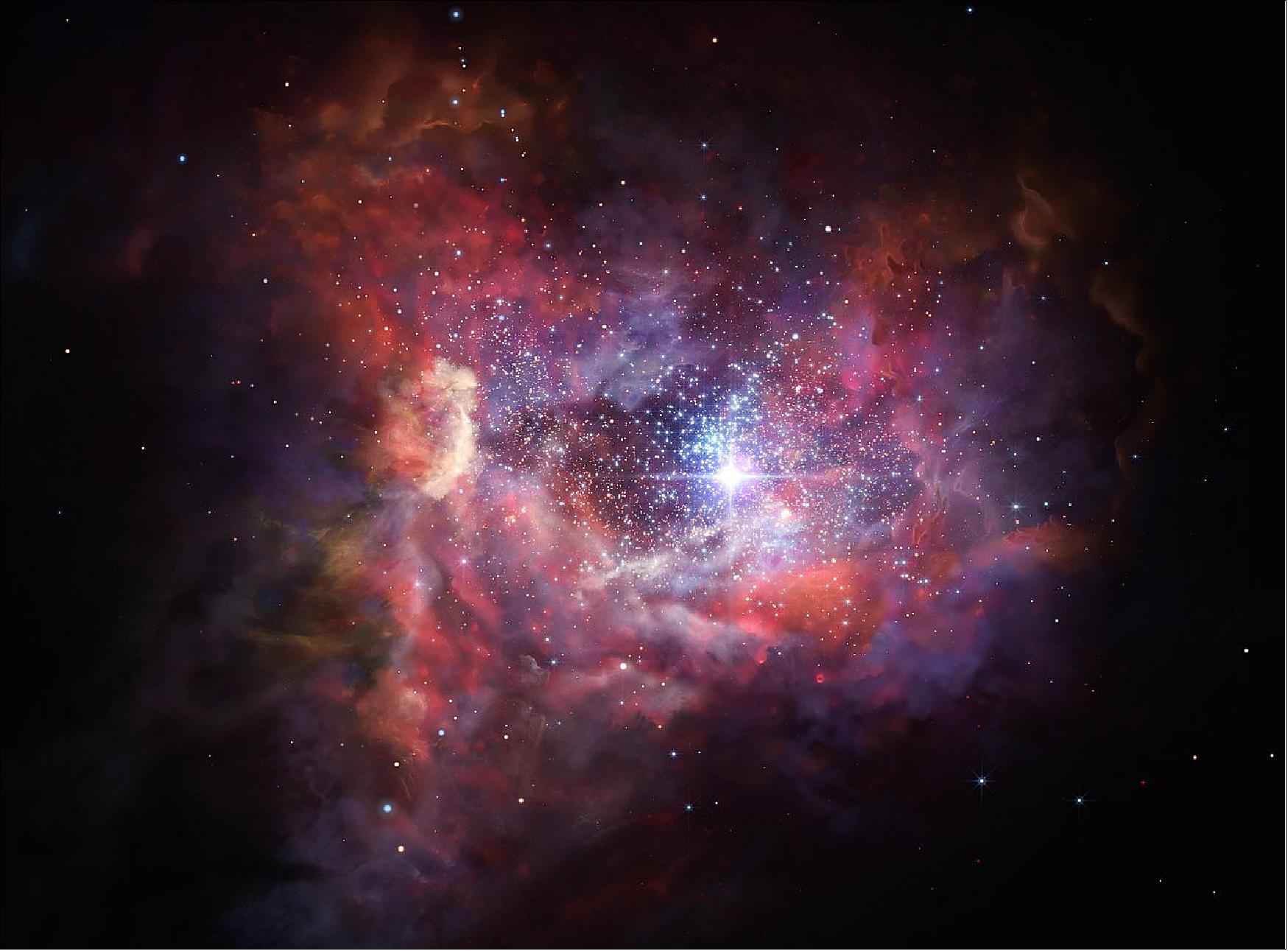
• February 14, 2017: Astronomers using ALMA have discovered a surprising connection between a supermassive black hole and the galaxy where it resides. Powerful radio jets from the black hole – which normally suppress star formation – are stimulating the production of cold gas in the galaxy's extended halo of hot gas. This newly identified supply of cold, dense gas could eventually fuel future star birth as well as feed the black hole itself. 47)
- The researchers used ALMA to study a galaxy at the heart of the Phoenix Cluster, an uncommonly crowded collection of galaxies about 5.7 billion light-years from Earth.
- The central galaxy in this cluster harbors a supermassive black hole that is in the process of devouring star-forming gas, which fuels a pair of powerful jets that erupt from the black hole in opposite directions into intergalactic space. Astronomers refer to this type of black-hole powered system as an AGN (Active Galactic Nucleus).
- Earlier research with NASA's Chandra X-ray observatory revealed that the jets from this AGN are carving out a pair of giant "radio bubbles," huge cavities in the hot, diffuse plasma that surrounds the galaxy. - These expanding bubbles should create conditions that are too inhospitable for the surrounding hot gas to cool and condense, which are essential steps for future star formation.
- The latest ALMA observations, however, reveal long filaments of cold molecular gas condensing around the outer edges of the radio bubbles. These filaments extend up to 82,000 light-years from either side of the AGN. They collectively contain enough material to make about 10 billion suns.
- "With ALMA we can see that there's a direct link between these radio bubbles inflated by the supermassive black hole and the future fuel for galaxy growth," said Helen Russell, an astronomer with the University of Cambridge, UK, and lead author on a paper appearing in the Astrophysical Journal. "This gives us new insights into how a black hole can regulate future star birth and how a galaxy can acquire additional material to fuel an active black hole." 48)
- The AGN and Galaxy Growth Connection: The new ALMA observations reveal previously unknown connections between an AGN and the abundance of cold molecular gas that fuels star birth. "To produce powerful jets, black holes must feed on the same material that the galaxy uses to make new stars," said Michael McDonald, an astrophysicist at the Massachusetts Institute of Technology in Cambridge and coauthor on the paper. "This material powers the jets that disrupt the region and quenches star formation. This illustrates how black holes can slow the growth of their host galaxies."
![Figure 38: Composite image showing how powerful radio jets from the supermassive black hole at the center of a galaxy in the Phoenix Cluster inflated huge "bubbles" in the hot, ionized gas surrounding the galaxy (the cavities inside the blue region imaged by NASA's Chandra X-ray observatory). Hugging the outside of these bubbles, ALMA discovered an unexpected trove of cold gas, the fuel for star formation (red). The background image is from the Hubble Space Telescope [image credit: ALMA (ESO/NAOJ/NRAO) H. Russell, et al.; NASA/ESA Hubble; NASA/CXC/MIT/M. McDonald et al.; B. Saxton (NRAO/AUI/NSF)]](/api/cms/documents/163813/5433030/Alma2018_Auto19.jpeg)
![Figure 39: ALMA image of cold molecular gas at the heart of the Phoenix Cluster. The filaments extending from the center hug enormous radio bubbles created by jets from a supermassive black hole. This discovery sheds light on the complex relationship between a supermassive black hole and its host galaxy [image credit: ALMA (ESO/NAOJ/NRAO), H. Russell et al.; B. Saxton (NRAO/AUI/NSF)]](/api/cms/documents/163813/5433030/Alma2018_Auto18.jpeg)
![Figure 40: Artist's impression of galaxy at the center of the Phoenix Cluster. Powerful radio jets from the supermassive black hole at the center of the galaxy are creating giant radio bubbles (blue) in the ionized gas surrounding the galaxy. ALMA has detected cold molecular gas (red) hugging the outside of the bubbles. This material could eventually fall into the galaxy where it could fuel future star birth and feed the supermassive black hole (image credit: B. Saxton (NRAO/AUI/NS)]](/api/cms/documents/163813/5433030/Alma2018_Auto17.jpeg)
• January 17, 2017: Astronomers have harnessed ALMA's capabilities to image the millimeter-wavelength radiation emitted by the Sun's chromosphere — the region that lies just above the photosphere, which forms the visible surface of the Sun. The solar campaign team, an international group of astronomers with members from Europe, North America and East Asia, produced the images as a demonstration of ALMA's ability to study solar activity at longer wavelengths of light than are typically available to solar observatories on Earth. 49) 50)
- Astronomers have studied the Sun and probed its dynamic surface and energetic atmosphere in many ways through the centuries. But, to achieve a fuller understanding, astronomers need to study it across the entire electromagnetic spectrum, including the millimeter and submillimeter region of the spectrum that ALMA can observe.
- Since the Sun is many billions of times brighter than the faint objects ALMA typically observes, the ALMA antennas were specially designed to allow them to image the Sun in exquisite detail using the technique of radio interferometry — and avoid damage from the intense heat of the focussed sunlight. The result of this work is a series of images that demonstrate ALMA's unique vision and ability to study our Sun. The data from the solar observing campaign are being released this week to the worldwide astronomical community for further study and analysis.
- The team observed an enormous sunspot at wavelengths of 1.25 mm and of 3 mm (Figures 41 and 42), using two of ALMA's receiver bands. The images reveal differences in temperature between parts of the Sun's chromosphere . Understanding the heating and dynamics of the chromosphere are key areas of research that will be addressed in the future using ALMA.
- Sunspots are transient features that occur in regions where the Sun's magnetic field is extremely concentrated and powerful. They are lower in temperature than the surrounding regions, which is why they appear relatively dark.
- The difference in appearance between the two images is due to the different wavelengths of emitted light being observed. Observations at shorter wavelengths are able to probe deeper into the Sun, meaning the 1.25 mm images show a layer of the chromosphere that is deeper, and therefore closer to the photosphere, than those made at a wavelength of 3 mm.
- ALMA is the first facility where ESO is a partner that allows astronomers to study the nearest star, our own Sun. All other existing and past ESO facilities need to be protected from the intense solar radiation to avoid damage. The new ALMA capabilities will expand the ESO community to include solar astronomers.
- During a 30-month campaign period beginning in 2014, an international team of astronomers harnessed ALMA's single-antenna and array capabilities to detect and image the millimeter-wavelength light emitted by the Sun's chromosphere — the region that lies just above the photosphere, the visible surface of the Sun.
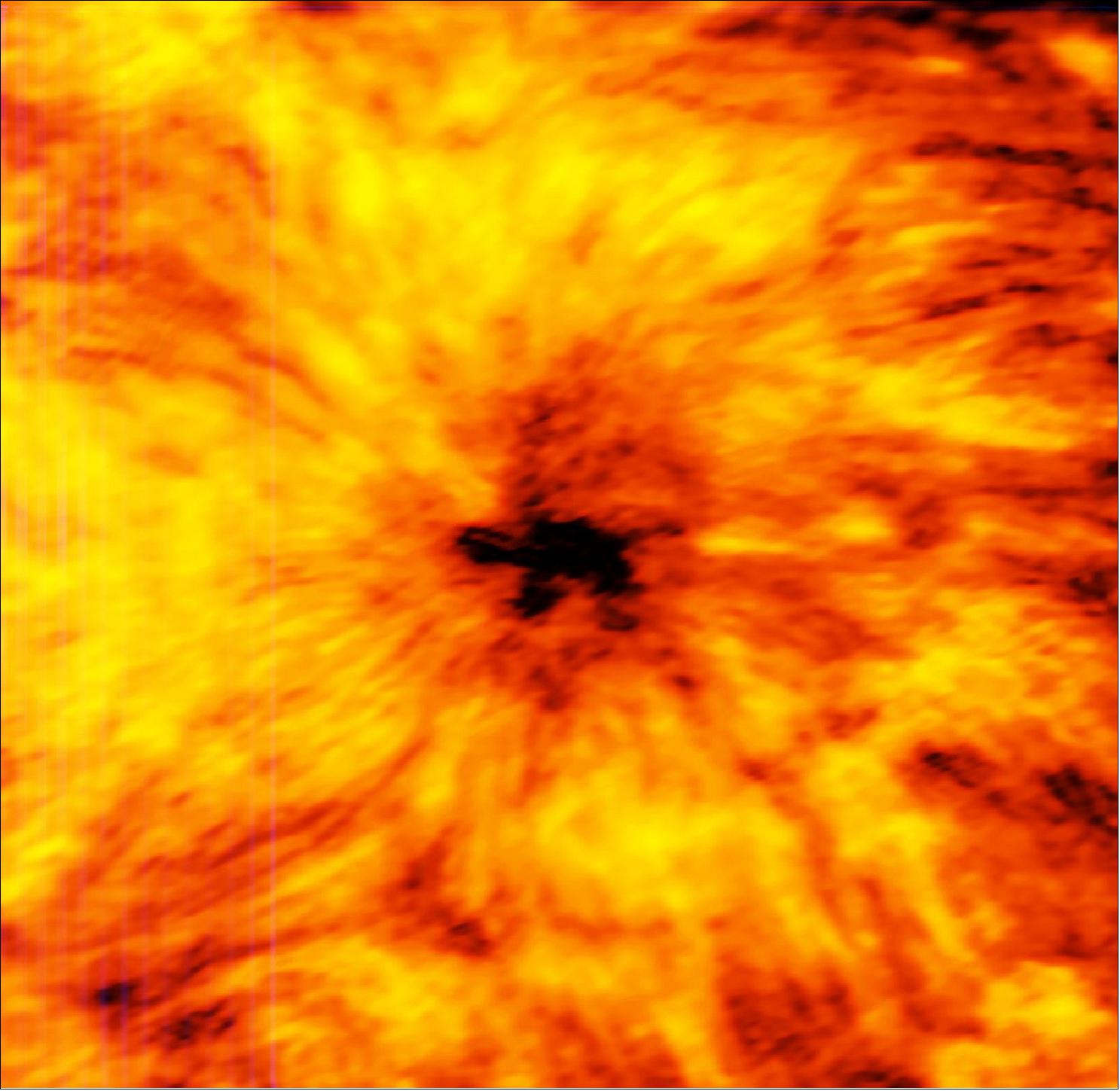
Legend to Figure 41: Sunspots are transient features that occur in regions where the Sun's magnetic field is extremely concentrated and powerful. They are lower in temperature than their surrounding regions, which is why they appear relatively dark in visible light. The ALMA image is essentially a map of temperature differences in a layer of the Sun's atmosphere known as the chromosphere, which lies just above the visible surface of the Sun (the photosphere). The chromosphere is considerably hotter than the photosphere. Understanding the heating and dynamics of the chromosphere are key areas of research that will be addressed by ALMA.
The ALMA Solar Development Team includes the following participants: Shin'ichiro Asayama, Miroslav Barta, Ondrejov, Tim Bastian, Roman Brajsa, Bin Chen, Bart De Pontieu, Gregory Fleishman, Dale Gary, Antonio Hales, Akihiko Hirota, Hugh Hudson, Richard Hills, Kazumasa Iwai, Sujin Kim, Neil Philips, Tsuyoshi Sawada, Masumi Shimojo, Giorgio Siringo, Ivica Skokic, Sven Wedemeyer, Stephen White,Pavel Yagoubov, Yihua Yan.
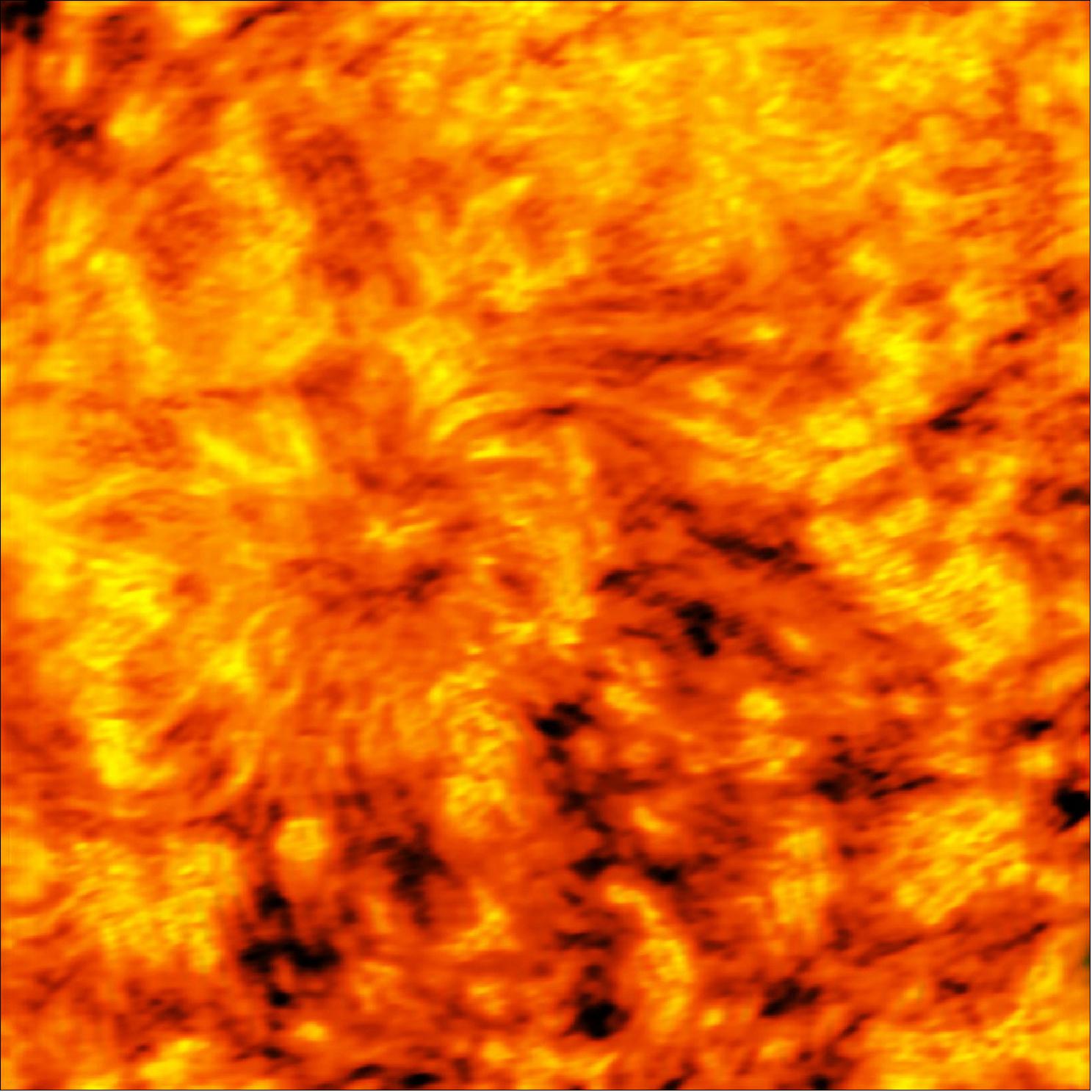
• December 12, 2016: Astronomers now know that our galaxy is teeming with planets, from rocky worlds roughly the size of Earth to gas giants bigger than Jupiter. Nearly every one of these exoplanets has been discovered in orbit around a mature star with a fully evolved planetary system. — New observations with the ALMA (Atacama Large Millimeter/submillimeter Array) contain compelling evidence that two newborn planets, each about the size of Saturn, are in orbit around a young star known as HD 163296. These planets, which are not yet fully formed, revealed themselves by the dual imprint they left in both the dust and the gas portions of the star's protoplanetary disk. 51)
- Previous observations of other young star systems have helped to reshape our understanding of planet formation. For example, ALMA's images of HL Tauri and TW Hydrae revealed striking gaps and prominent ring structures in the stars' dusty disks. These features may be the tantalizing first signs that planets are being born. Remarkably, these signs appeared around much younger stars than astronomers thought possible, suggesting that planet formation can begin soon after the formation of a protoplanetary disk.
- "ALMA has shown us amazing images and never-before-seen views of the rings and gaps around young stars that could be the hallmarks of planet formation. However, since we were only looking at the dust in the disks with sufficient detail, we couldn't be sure what created these features," said Andrea Isella, an astronomer at Rice University in Houston, Texas, and lead author on a paper published in Physical Review Letters. 52)
- In studying HD 163296, the research team used ALMA to trace, for the first time, the distribution of both the dust and the carbon monoxide (CO) gas components of the disk at roughly the same level of detail.
- These observations revealed three distinct gaps in HD 163296's dust-filled protoplanetary disk. The first gap is located approximately 60 astronomical units from the central star, which is about twice the distance from our Sun to Neptune. (An astronomical unit – AU – is the average distance from the Earth to the Sun.) The other two gaps are 100 AU and 160 AU from the central star, well beyond the extent of our solar system's Kuiper Belt, the region of icy bodies beyond the orbit of Neptune.
- Using ALMA's ability to detect the faint millimeter-wavelength "glow" emitted by gas molecules, Isella and his team discovered that there was also an appreciable dip in the amount of CO in the outer two dust gaps.
- By seeing the same features in both the gas and the dust components of the disk, the astronomers believe they have found compelling evidence that there are two planets coalescing remarkably far from the central star. The width and depth of the two CO gaps suggest that each potential planet is roughly the same mass as Saturn, the astronomers said.
- In the gap nearest to the star, the team found little to no difference in the concentration of CO gas compared to the surrounding dusty disk. This means that the innermost gap could have been produced by something other than an emerging planet.
- "Dust and gas behave very differently around young stars," said Isella. "We know, for example, that there are certain chemical and physical process that can produce ringed structures in the dust like the ones we have seen previously. We certainly believe these structures could be the work of a nascent planet plowing through the dust, but we simply can't rule out other possible explanations. Our new observations provide intriguing evidence that planets are indeed forming around this one young star."
- HD 163296 is roughly 5 million years old and about twice the mass of the Sun. It is located approximately 400 light-years from Earth in the direction of the constellation Sagittarius.
![Figure 43: ALMA image of the protoplanetary disk surrounding the young star HD 163296 as seen in dust. New observations suggested that two planets, each about the size of Saturn, are in orbit around the star. These planets, which are not yet fully formed, revealed themselves by the dual imprint they left in both the dust and the gas portions of the star's protoplanetary disk [image credit: ALMA (ESO/NAOJ/NRAO); A. Isella; B. Saxton (NRAO/AUI/NSF)]](/api/cms/documents/163813/5433030/Alma2018_Auto14.jpeg)
![Figure 44: Composite image of the protoplanetary disk surrounding the young star HD 163296. The inner red area shows the dust of the protoplanetary disk. The broader blue disk is the carbon monoxide gas in the system. ALMA observed that in the outer two gaps in the dust, there was a significant dip in the concentration of carbon monoxide, suggesting two planets are forming there [image credit: ALMA (ESO/NAOJ/NRAO); A. Isella; B. Saxton (NRAO/AUI/NSF)]](/api/cms/documents/163813/5433030/Alma2018_Auto13.jpeg)

• October 4, 2016: Astronomers have discovered a 'hot molecular core,' a cocoon of molecules surrounding a newborn massive star, for the first time outside our Galaxy. The discovery, which marks the first important step for observational studies of extragalactic hot molecular cores and challenges the hidden chemical diversity of our universe, appears in a paper in The Astrophysical Journal Volume 827. 53) 54)
- The scientists from Tohoku University, the University of Tokyo, the National Astronomical Observatory of Japan, and the University of Tsukuba, used the Atacama Large Millimeter/submillimeter Array (ALMA) in Chile to observe a newborn star located in the Large Magellanic Cloud, one of the closest neighbors of our Galaxy. As a result, a number of radio emission lines from various molecular gas are detected, which indicates the presence of a hot molecular core associated with the observed newborn star (Figures 46 and 47).
- The observations have revealed that the hot molecular core in the Large Magellanic Cloud shows significantly different chemical compositions as compared to similar objects in our Galaxy. In particular, the results suggest that simple organic molecules such as methanol are deficient in this galaxy, suggesting a potential difficulty in producing large organic species indispensable for the birth of life. The research team suggests that the unique galactic environment of the Large Magellanic Cloud affects the formation processes of molecules around a newborn star, and this results in the observed unique chemical compositions.
- "This is the first detection of an extragalactic hot molecular core, and it demonstrates the great capability of new generation telescopes to study astrochemical phenomena beyond our Galaxy," said Dr. Takashi Shimonishi, an astronomer at Tohoku University, Japan, and the paper's lead author. "The observations have suggested that the chemical compositions of materials that form stars and planets are much more diverse than we expected. " It is known that various complex organic molecules, which have a connection to prebiotic molecules formed in space, are detected from hot molecular cores in our Galaxy. It is, however, not yet clear if such large and complex molecules exist in hot molecular cores in other galaxies. The newly discovered hot molecular core is an excellent target for such a study, and further observations of extragalactic hot molecular cores will shed light on the chemical complexities of our universe.
![Figure 46: Artist's concept image of the hot molecular core discovered in the Large Magellanic Cloud [image credit: RIS/Tohoku University. The figure is a derivative work of the following sources (ESO/M. Kornmesser; NASA, ESA, and S. Beckwith (STScI) and the HUDF Team; NASA/ESA and the Hubble Heritage Team (AURA/STScI)/HEI]](/api/cms/documents/163813/5433030/Alma2018_Auto11.jpeg)
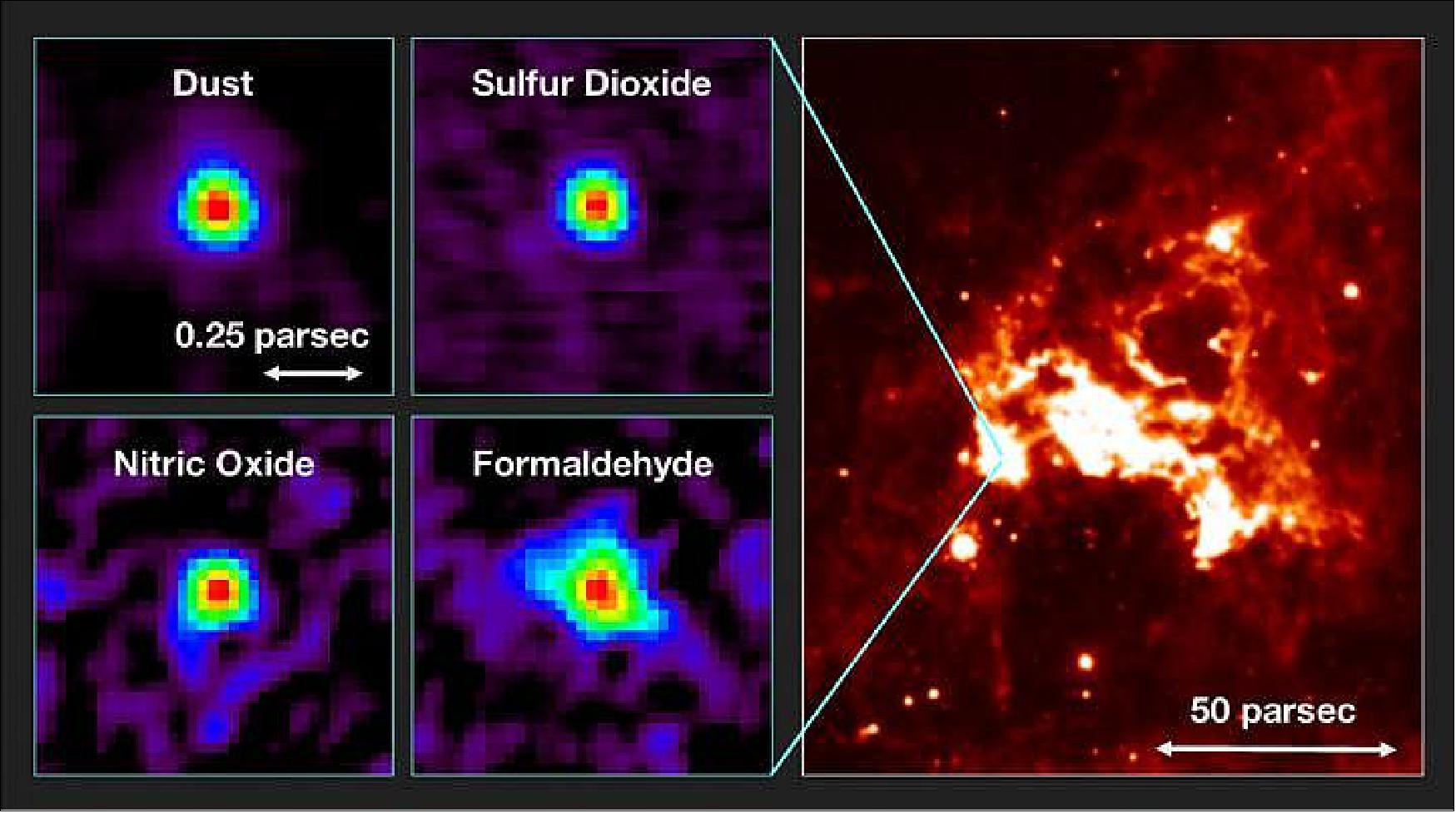
• September 22, 2016: International teams of astronomers have used ALMA to explore the distant corner of the Universe first revealed in the iconic images of the Hubble Ultra Deep Field (HUDF). These new ALMA observations are significantly deeper and sharper than previous surveys at millimeter wavelengths. They clearly show how the rate of star formation in young galaxies is closely related to their total mass in stars. They also trace the previously unknown abundance of star-forming gas at different points in time, providing new insights into the "Golden Age" of galaxy formation approximately 10 billion years ago. — The new ALMA results will be published in a series of papers appearing in the Astrophysical Journal and Monthly Notices of the Royal Astronomical Society. 55)
- In 2004 the Hubble Ultra Deep Field images — pioneering deep-field observations with the NASA/ESA Hubble Space Telescope — were published. These spectacular pictures probed more deeply than ever before and revealed a menagerie of galaxies stretching back to less than a billion years after the Big Bang. The area was observed several times by Hubble and many other telescopes, resulting in the deepest view of the Universe to date.
- Astronomers using ALMA have now surveyed this seemingly unremarkable, but heavily studied, window into the distant Universe for the first time both deeply and sharply in the millimeter range of wavelengths. This allows them to see the faint glow from gas clouds and also the emission from warm dust in galaxies in the early Universe.
- ALMA has observed the HUDF for a total of around 50 hours up to now. This is the largest amount of ALMA observing time spent on one area of the sky so far. One team, led by Jim Dunlop (University of Edinburgh, United Kingdom) used ALMA to obtain the first deep, homogeneous ALMA image of a region as large as the HUDF. This data allowed them to clearly match up the galaxies that they detected with objects already seen with Hubble and other facilities.
- This study showed clearly for the first time that the stellar mass of a galaxy is the best predictor of star formation rate in the high redshift Universe. They detected essentially all of the high-mass galaxies and virtually nothing else. 56)
- The second team, led by Manuel Aravena of the Núcleo de Astronomía, Universidad Diego Portales, Santiago, Chile, and Fabian Walter of the Max Planck Institute for Astronomy in Heidelberg, Germany, conducted a deeper search across about one sixth of the total HUDF. 57)
- "We conducted the first fully blind, three-dimensional search for cool gas in the early Universe," said Chris Carilli, an astronomer with the NRAO (National Radio Astronomy Observatory) in Socorro, New Mexico, USA and member of the research team. "Through this, we discovered a population of galaxies that is not clearly evident in any other deep surveys of the sky." 58)
- The new ALMA observations of the HUDF include two distinct, yet complementary types of data: continuum observations, which reveal dust emission and star formation, and a spectral emission line survey, which looks at the cold molecular gas fueling star formation. The second survey is particularly valuable because it includes information about the degree to which light from distant objects has been redshifted by the expansion of the Universe. Greater redshift means that an object is further away and seen farther back in time. This allows astronomers to create a three-dimensional map of star-forming gas as it evolves over cosmic time.
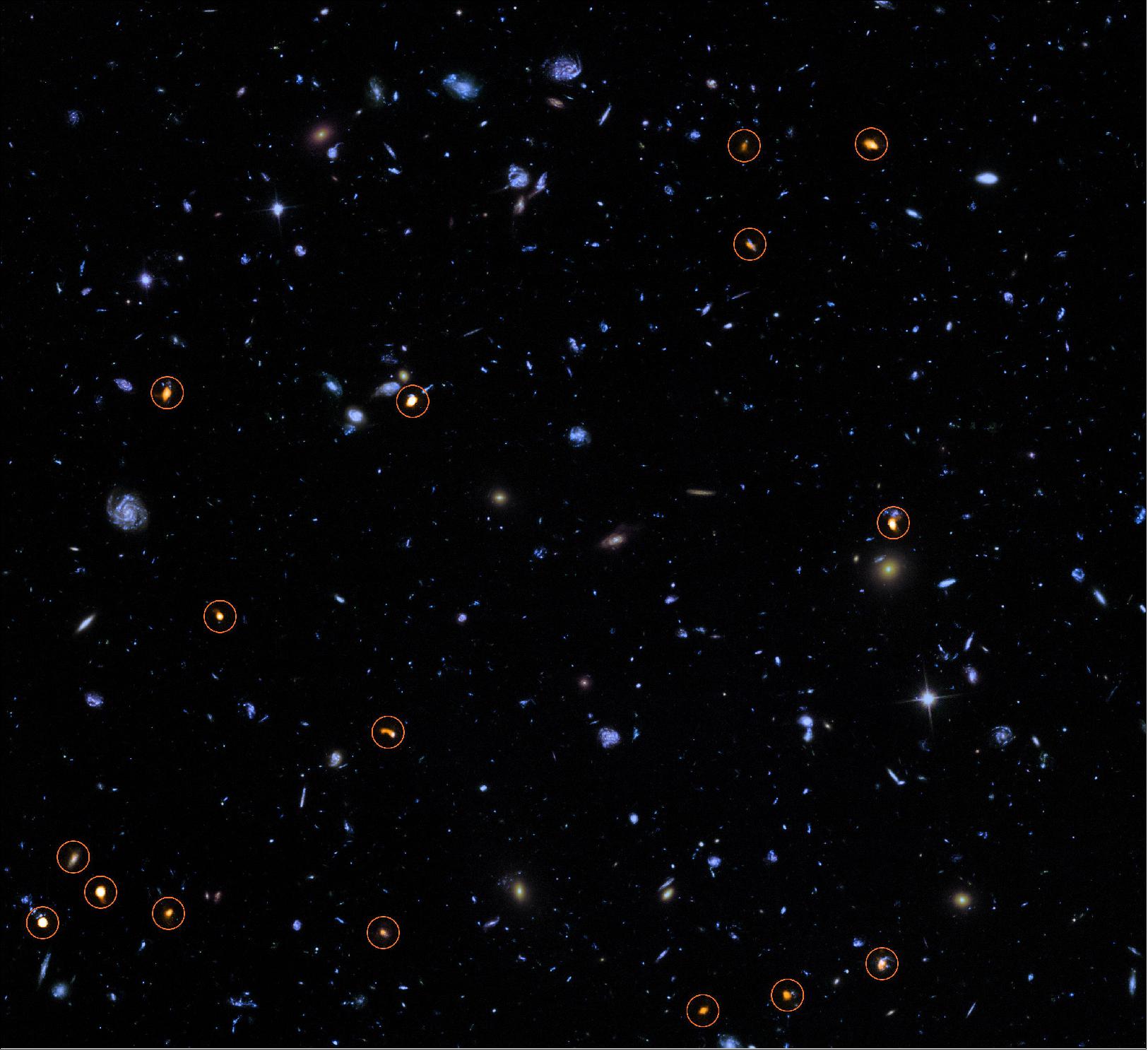
• July 2016: A Chalmers-led team of astronomers (Chalmers University of Technology, Gothenburg, Sweden) have used the Alma telescope to make the surprising discovery of a jet of cool, dense gas in the center of a galaxy located 70 million light years from Earth. The jet, with its unusual, swirling structure, gives new clues to a long-standing astronomical mystery – how supermassive black holes grow. 59) 60)
- A team of astronomers led by Susanne Aalto, professor of radio astronomy at Chalmers, has used the Alma telescope (Atacama Large Millimeter/submillimeter Array) to observe a remarkable structure in the center of the galaxy NGC 1377, located 70 million light years from Earth in the constellation Eridanus (the River). "We were curious about this galaxy because of its bright, dust-enshrouded center. What we weren't expecting was this: a long, narrow jet streaming out from the galaxy nucleus", says Susanne Aalto.
- The observations with Alma reveal a jet which is 500 light years long and less than 60 light years across, travelling at speeds of at least 800 000 km/hour.
- Most galaxies have a supermassive black hole in their centers; these black holes can have masses of between a few million to a billion solar masses. How they grew to be so massive is a long-standing mystery for scientists.
- A black hole's presence can be seen indirectly by telescopes when matter is falling into it – a process which astronomers call "accretion". Jets of fast-moving material are typical signatures that a black hole is growing by accreting matter. The jet in NGC 1377 reveals the presence of a supermassive black hole. But it has even more to tell us, explains Francesco Costagliola (Chalmers and ORA-INAF, Italy), co-author on the paper. "The jets we usually see emerging from galaxy nuclei are very narrow tubes of hot plasma. This jet is very different. Instead it's extremely cool, and its light comes from dense gas composed of molecules", he says.
- The jet has ejected molecular gas equivalent to two million times the mass of the Sun over a period of only around half a million years - a very short time in the life of a galaxy. During this short and dramatic phase in the galaxy's evolution, its central, supermassive black hole must have grown fast.
- "Black holes that cause powerful narrow jets can grow slowly by accreting hot plasma. The black hole in NGC1377, on the other hand, is on a diet of cold gas and dust, and can therefore grow – at least for now – at a much faster rate", explains team member Jay Gallagher (University of Wisconsin-Madison).
- The motion of the gas in the jet also surprised the astronomers. The measurements with Alma are consistent with a jet that is precessing – swirling outwards like water from a garden sprinkler.
- "The jet's unusual swirling could be due to an uneven flow of gas towards the central black hole. Another possibility is that the galaxy's center contains two supermassive black holes in orbit around each other", says Sebastien Muller, Chalmers, also a member of the team.
- The discovery of the remarkable cool, swirling jet from the center of this galaxy would have been impossible without Alma, concludes Susanne Aalto.
![Figure 49: Alma's close-up view of the center of galaxy NGC 1377 (upper left) reveals a swirling jet. In this color-coded image, reddish gas clouds are moving away from us, bluish clouds towards us, relative to the galaxy's center. The Alma image shows light with wavelength around one millimeter from molecules of carbon monoxide (CO). A cartoon view (lower right) shows how these clouds are moving, this time seen from the side. The background color image of NGC 1377 and its surroundings is a composite made from a visible light images taken at the CTIO 1.5 meter telescope in Chile by H. Roussel et al. [image credit: CTIO/H. Roussel et al./ESO (left panel); Alma/ESO/NRAO/S. Aalto (top right panel); S. Aalto (lower right panel)]](/api/cms/documents/163813/5433030/Alma2018_AutoE.jpeg)
• June 16, 2016: Astronomers using the ALMA (Atacama Large Millimeter/submillimeter Array) in Chile, detected a clear signal from oxygen in a galaxy located 13.1 billion light-years away from us. This is the most distant oxygen ever detected. Oxygen in this galaxy seems to be ionized by a number of young giant stars, and this detection is a key step to understand the enigmatic "cosmic reionization" in the early history of the Universe. These observations have opened a new window to probe the early Universe with ALMA. 61) 62)
- The research team from Japan, Sweden, the United Kingdom and ESO have used ALMA to observe one of the most distant galaxies known. SXDF-NB1006-2 lies at a redshift of 7.2, meaning that we see it only 700 million years after the Big Bang.
- The astronomers hoped to find out about the heavy chemical elements present in the galaxy, as they can tell us about the level of star formation, and hence provide clues about the period in the history of the Universe known as cosmic reionization.
- "Seeking heavy elements in the early Universe is an essential approach to explore the star formation activity in that period," said Akio Inoue of Osaka Sangyo University, Japan, the lead author of the research paper published in Science. He added, "Studying heavy elements also gives us a hint to understand how the galaxies were formed and what caused the cosmic reionization".
- Various elements are found around us in the present Universe, but just after the Big Bang, 13.8 billion years ago, only the lightest elements (hydrogen, helium, and lithium) existed. Heavier elements, such as carbon and oxygen, have been formed in stars and accumulated in the Universe over time.
- Before the first celestial objects formed, the Universe was filled with electrically neutral gas. Celestial objects emitted strong radiation and started to ionize the neutral gas a few hundred million years after the Big Bang. This is known as cosmic reionization. The state of the whole Universe changed dramatically during this period. But, the process is deeply shrouded in darkness. It has been under debate what kind of objects caused the reionization.
- "We expected that the light from ionized oxygen is strong enough to be observed, even 13 billion light-years away," explained Hiroshi Matsuo at the NAOJ (National Astronomy Observatory, Japan), "because the Japanese infrared astronomy satellite AKARI has found that this emission is very bright in the Large Magellanic Cloud, which has an environment similar to the early Universe."
- Nevertheless, the detection of light from ionized oxygen in very distant galaxies was a new challenge for ALMA. To secure the competitive observation time with ALMA, the researchers first performed large-scale computer simulations of the cosmic evolution to predict the emission brightness. "The simulation showed that the light should be particularly bright and easily detected with ALMA," said Ikkoh Shimizu at Osaka University, the main contributor to this simulation.
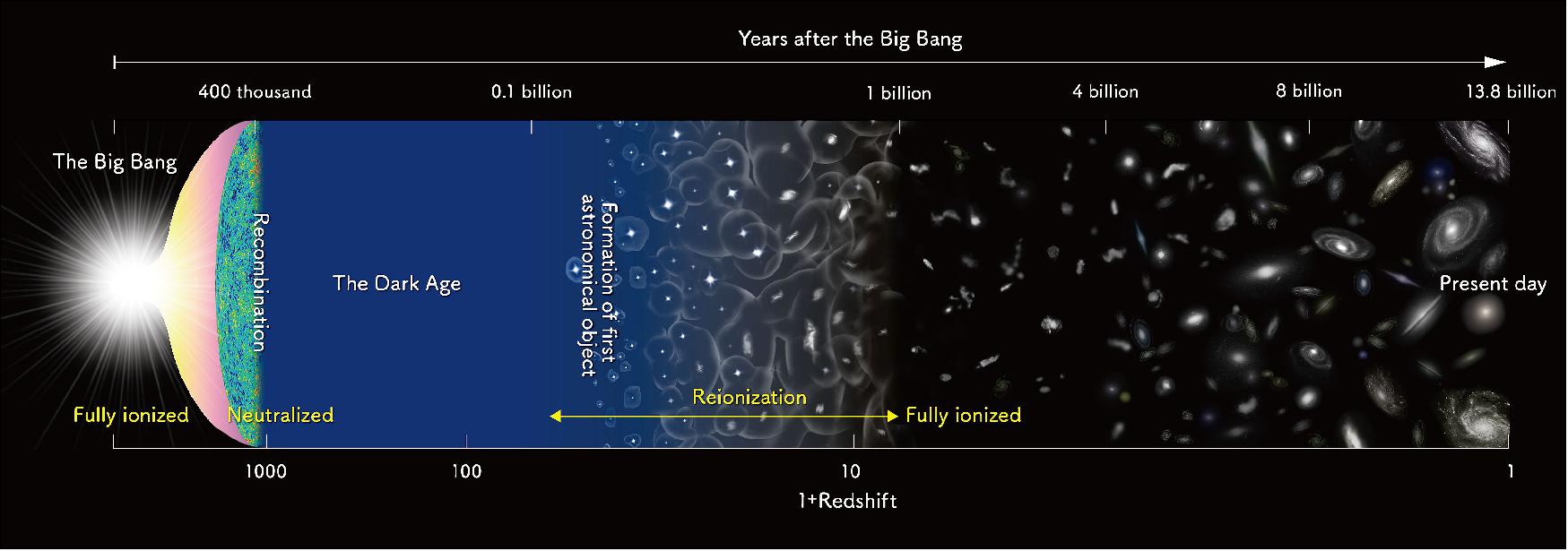
• April 14, 2016: Subtle distortions hidden in ALMA's stunning image of the gravitational lens SDP.81 are telltale signs that a dwarf dark galaxy is lurking in the halo of a much larger galaxy nearly 4 billion light-years away (Figure 51). This discovery paves the way for ALMA to find many more such objects and could help astronomers address important questions on the nature of dark matter. 63)
- In 2014, as part of ALMA's Long Baseline Campaign, astronomers studied a variety of astronomical objects to test the telescope's new, high-resolution capabilities. One of these experimental images was that of an Einstein ring, which was produced by the gravity of a massive foreground galaxy bending the light emitted by another galaxy nearly 12 billion light-years away.
- This phenomenon, called gravitational lensing, was predicted by Einstein's general theory of relativity and it offers a powerful tool for studying galaxies that are otherwise too distant to observe. It also sheds light on the properties of the nearby lensing galaxy because of the way its gravity distorts and focuses light from more distant objects.
- In a new paper accepted for publication in the Astrophysical Journal, astronomer Yashar Hezaveh at Stanford University in California and his team explain how detailed analysis of this widely publicized image uncovered signs of a hidden dwarf dark galaxy in the halo of the more nearby galaxy. 64)
- "We can find these invisible objects in the same way that you can see rain droplets on a window. You know they are there because they distort the image of the background objects," explained Hezaveh. In the case of a rain drop, the image distortions are caused by refraction. In this image, similar distortions are generated by the gravitational influence of dark matter.
- Current theories suggest that dark matter, which makes up about 80 percent of the mass of the Universe, is made of as-yet-unidentified particles that don't interact with visible light or other forms of electromagnetic radiation. Dark matter does, however, have appreciable mass, so it can be identified by its gravitational influence.
- For their analysis, the researchers harnessed thousands of computers working in parallel for many weeks, including the National Science Foundation's most powerful supercomputer, Blue Waters, to search for subtle anomalies that had a consistent and measurable counterpart in each "band" of radio data. From these combined computations, the researchers were able to piece together an unprecedented understanding of the lensing galaxy's halo, the diffuse and predominantly star-free region around the galaxy, and discovered a distinctive clump less than one-thousandth the mass of the Milky Way.
- Because of its relationship to the larger galaxy, estimated mass, and lack of an optical counterpart, the astronomers believe this gravitational anomaly may be caused by an extremely faint, dark-matter dominated satellite of the lensing galaxy. According to theoretical predictions, most galaxies should be brimming with similar dwarf galaxies and other companion objects. Detecting them, however, has proven challenging. Even around our own Milky Way, astronomers can identify only 40 or so of the thousands of satellite objects that are predicted to be present.
- "This discrepancy between observed satellites and predicted abundances has been a major problem in cosmology for nearly two decades, even called a 'crisis' by some researchers," said Neal Dalal of the University of Illinois, a member of the team. "If these dwarf objects are dominated by dark matter, this could explain the discrepancy while offering new insights into the true nature of dark matter," he added.
- Computer models of the evolution of the Universe indicate that by measuring the "clumpiness" of dark matter, it's possible to measure its temperature. So by counting the number of small dark matter clumps around distant galaxies, astronomers can infer the temperature of dark matter, which has an important bearing on the smoothness of our Universe.
- "If these halo objects are simply not there," notes co-author Daniel Marrone of the University of Arizona, "then our current dark matter model cannot be correct and we will have to modify what we think we understand about dark matter particles."
- This study suggests, however, that the majority of dwarf galaxies may simply not be seen because they're mainly composed of invisible dark matter and emit little if any light. "Our current measurements agree with the predictions of cold dark matter," said team member Gilbert Holder of McGill University in Montreal, Canada. "In order to increase our confidence we will need to look at many more lenses."
- "This is an amazing demonstration of the power of ALMA," said Hezaveh. "We are now confident that ALMA can efficiently discover these dwarf galaxies. Our next step is to look for more of them and to have a census of their abundance to figure out if there is any possibility of a warm temperature for dark matter particles."
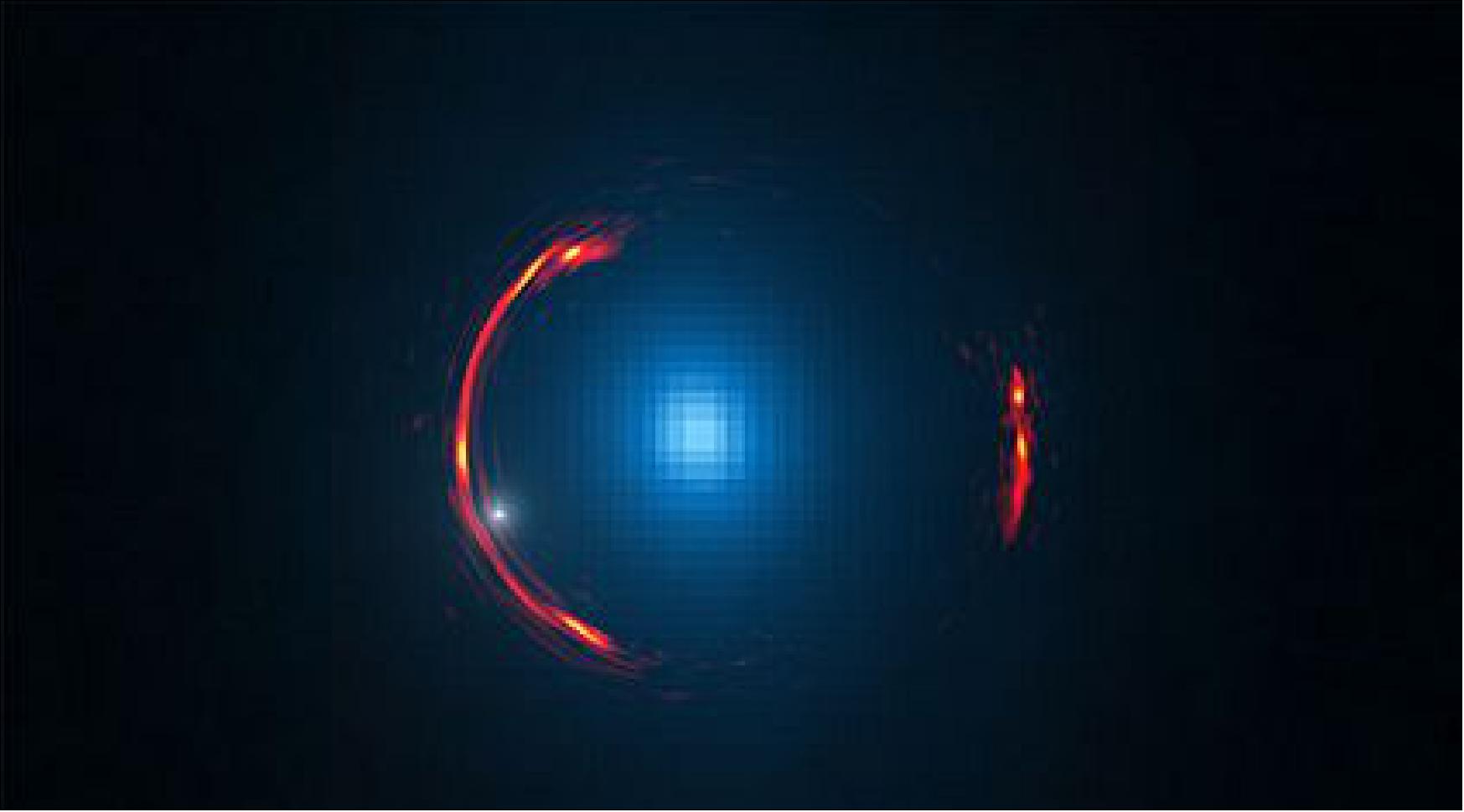
• March 31, 2016: This new image of ALMA shows the finest detail ever seen in the planet-forming disc around the nearby Sun-like star TW Hydrae. It reveals a tantalizing gap at the same distance from the star as the Earth is from the Sun, which may mean that an infant version of our home planet, or possibly a more massive super-Earth, is beginning to form there. 65) 66)
- The star TW Hydrae is a popular target of study for astronomers because of its proximity to Earth (only about 175 light-years away) and its status as an infant star (about 10 million years old). It also has a face-on orientation as seen from Earth. This gives astronomers a rare, undistorted view of the complete protoplanetary disc around the star.
- "Previous studies with optical and radio telescopes confirm that TW Hydrae hosts a prominent disc with features that strongly suggest planets are beginning to coalesce," said Sean Andrews with the Harvard-Smithsonian Center for Astrophysics in Cambridge, Massachusetts, USA and lead author on a paper published today in the Astrophysical Journal Letters. "The new ALMA images show the disc in unprecedented detail, revealing a series of concentric dusty bright rings and dark gaps, including intriguing features that may indicate that a planet with an Earth-like orbit is forming there."
- Other pronounced gaps that show up in the new images are located three billion and six billion kilometers from the central star, similar to the average distances from the Sun to Uranus and Pluto in the Solar System. They too are likely to be the results of particles that came together to form planets, which then swept their orbits clear of dust and gas and shepherded the remaining material into well-defined bands.
![Figure 52: ALMA's best image of a protoplanetary disc to date. This picture of the nearby young star TW Hydrae reveals the classic rings and gaps that signify planets are in formation in this system [image credit: S. Andrews (Harvard-Smithsonian CfA); B. Saxton (NRAO/AUI/NSF); ALMA (ESO/NAOJ/NRAO)]](/api/cms/documents/163813/5433030/Alma2018_AutoB.jpeg)
Legend to Figure 52: The long baseline ALMA observations of the 870 µm continuum emission from the nearest gas-rich protoplanetary disk, around TW Hya, that trace mm-sized particles down to spatial scales as small as 1 au (20 mas). These data reveal a series of concentric ring-shaped substructures in the form of bright zones and narrow dark annuli (1–6 au) with modest contrasts (5%–30%). These features are associated with concentrations of solids that have had their inward radial drift slowed or stopped, presumably at local gas pressure maxima. No significant non-axisymmetric structures are detected. Some of the observed features occur near temperatures that may be associated with the condensation fronts of major volatile species, but the relatively small brightness contrasts may also be a consequence of magnetized disk evolution (the so-called zonal flows). Other features, particularly a narrow dark annulus located only 1 au from the star, could indicate interactions between the disk and young planets. These data signal that ordered substructures on ~au scales can be common, fundamental factors in disk evolution and that high-resolution microwave imaging can help characterize them during the epoch of planet formation.
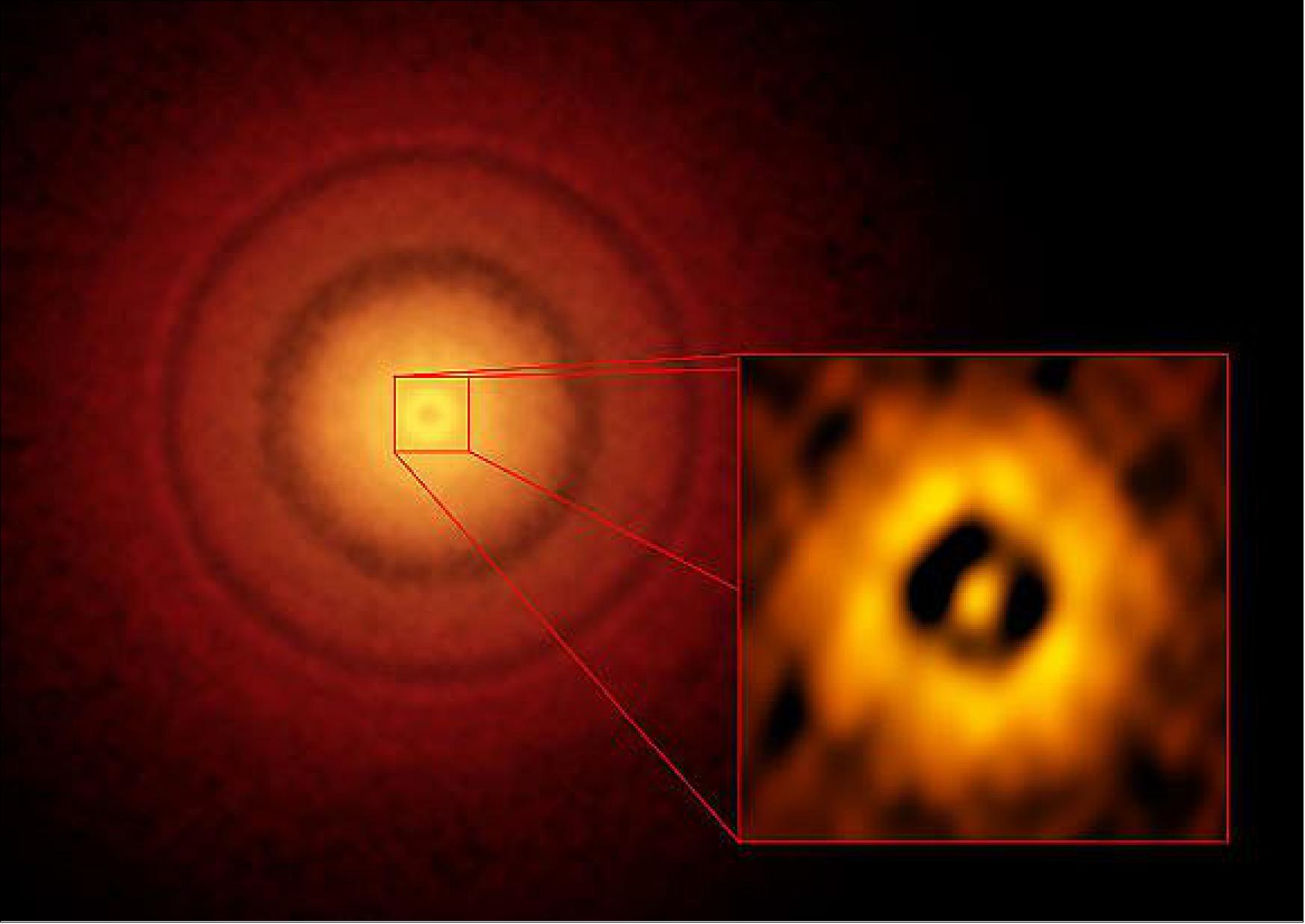
• Dec. 16, 2015: Astronomers using ALMA have found the clearest indications yet that planets with masses several times that of Jupiter have recently formed in the discs of gas and dust around four young stars. Measurements of the gas around the stars also provide additional clues about the properties of those planets. 68) 69)
- Planets are found around nearly every star, but astronomers still do not fully understand how — and under what conditions — they form. To answer such questions, they study the rotating discs of gas and dust present around young stars from which planets are built. But these discs are small and far from Earth, and the power of ALMA was needed for them to reveal their secrets.
- A special class of discs, called transitional discs, have a surprising absence of dust in their centers, in the region around the star. Two main ideas have been put forward to explain these mysterious gaps. Firstly, the strong stellar winds and intense radiation could have blown away or destroyed the encircling material (this process, which clears the dust and gas from the inside out, is known as photoevaporation). Alternatively, massive young planets in the process of formation could have cleared the material as they orbit the star (Figure 55).
- The unparalleled sensitivity and image sharpness of ALMA have now allowed the team of astronomers, led by Nienke van der Marel from the Leiden Observatory in the Netherlands to map the distribution of gas and dust in four of these transitional discs better than ever before. This in turn has allowed them to choose between the two options as the cause of the gaps for the first time.
- The new images show that there are significant amounts of gas within the dust gaps. But to the team's surprise, the gas also possessed a gap, up to three times smaller than that of the dust. This could only be explained by the scenario in which newly formed massive planets have cleared the gas as they travelled around their orbits, but trapped the dust particles further out.
- "Previous observations already hinted at the presence of gas inside the dust gaps," explains Nienke van der Marel. "But as ALMA can image the material in the entire disc in much greater detail than other facilities, we could rule out the alternative scenario. The deep gap points clearly to the presence of planets with several times the mass of Jupiter, creating these caverns as they sweep through the disc."
- Remarkably, these observations were conducted utilizing just one tenth of the current resolving power of ALMA, as they were performed whilst half of the array was still under construction on the Chajnantor Plateau in northern Chile. — Further studies are now needed to determine whether more transitional discs also point towards this planet-clearing scenario, although ALMA's observations have, in the meantime, provided astronomers with a valuable new insight into the complex process of planetary formation.

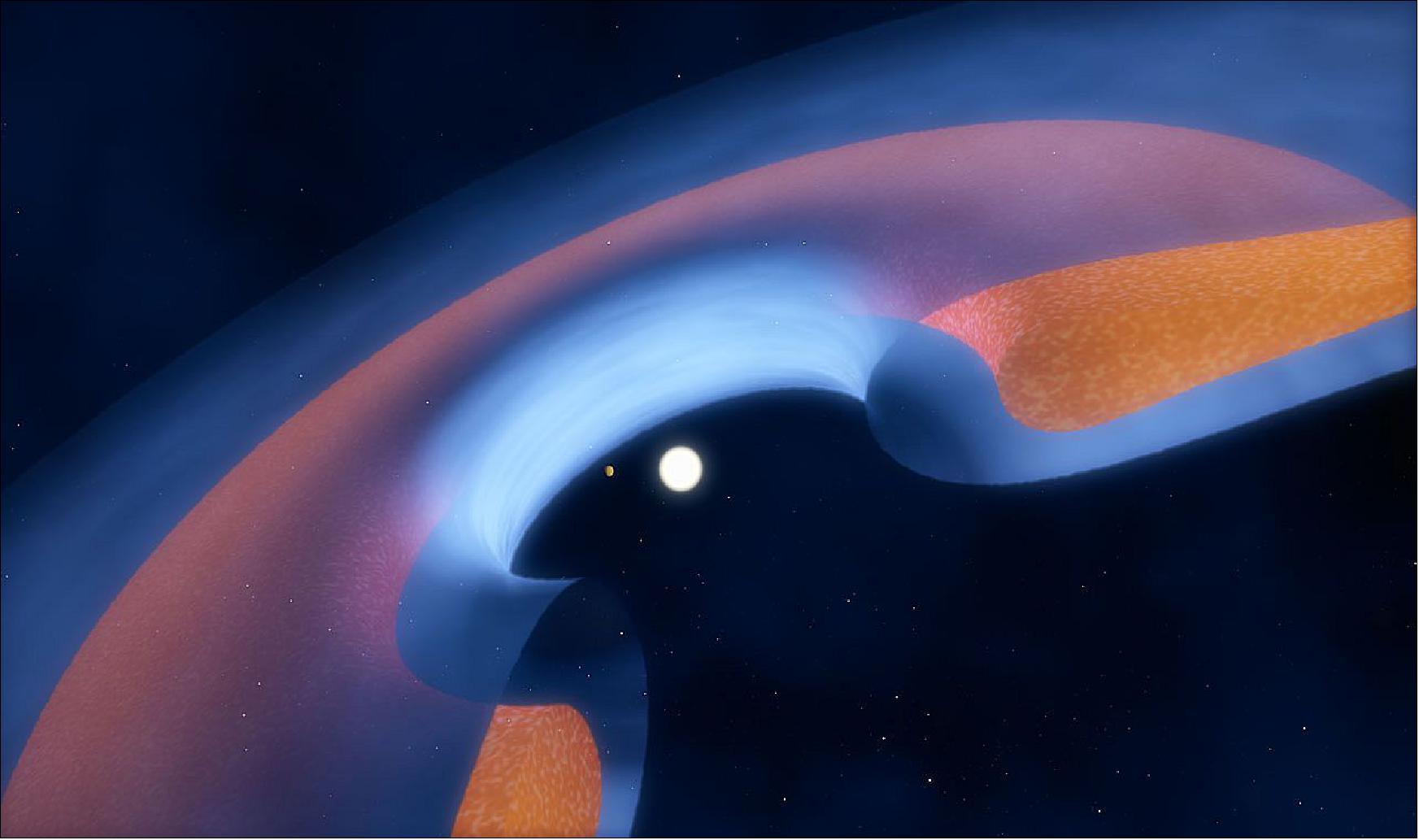
• Dec. 15, 2015: Galaxy clusters are massive congregations of galaxies that host huge reservoirs of hot gas — the temperatures are so high that X-rays are produced. These structures are useful to astronomers because their construction is believed to be influenced by the Universe's notoriously strange components — dark matter and dark energy. By studying their properties at different stages in the history of the Universe, galaxy clusters can shed light on the Universe's poorly understood dark side. 70)
- The team, consisting of over 100 astronomers from around the world, started a hunt for the cosmic monsters in 2011. Although the high-energy X-ray radiation that reveals their location is absorbed by the Earth's atmosphere, it can be detected by X-ray observatories in space. Thus, they combined an ESA XMM-Newton survey — the largest time allocation ever granted for this orbiting telescope — with observations from ESO and other observatories. The result is a huge and growing collection of data across the electromagnetic spectrum, collectively called the XXL survey (Figure 56). "The main goal of the XXL survey is to provide a well-defined sample of some 500 galaxy clusters out to a distance when the Universe was half its current age," explains XXL principal investigator Marguerite Pierre of CEA, Saclay, France.
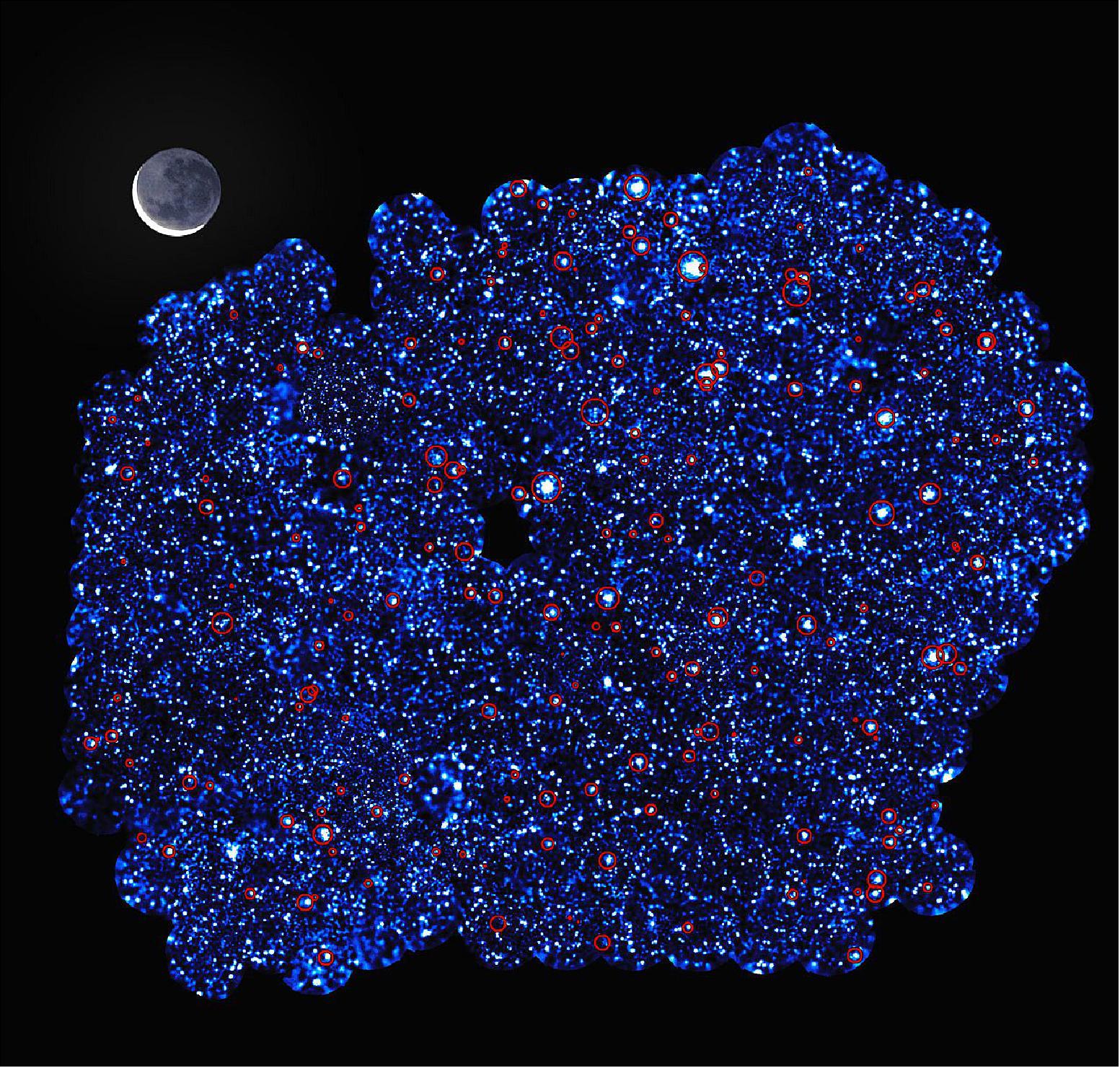
Legend to Figure 56: XXL is one of the largest quests for galaxy clusters ever undertaken and provides by far the best view of the deep X-ray sky yet obtained. The survey was carried out with ESA's XMM-Newton X-ray observatory. Additional vital observations to measure the distances to the galaxy clusters were made with ESO facilities. 71)
The area shown in this image was obtained with some 220 XMM-Newton pointings and, if viewed on the sky, would have a two dimensional area a hundred times larger than the full Moon (which spans one half degree), and that is without taking into account the depth that the survey explores.
The red circles in this image show the clusters of galaxies detected in the survey. Along with the other field — XXL-North Field (or XXL-N) — around 450 of these clusters were uncovered in the survey, which mapped them back to a time when the Universe was just half of its present age.
The image also reveals some of the 12 000 galaxies that had very bright cores containing supermassive black holes that were detected in the field.
• Nov. 19, 2015: Astronomers using ALMA have discovered that a dim, cool dwarf star is generating a surprisingly powerful magnetic field, one that rivals the most intense magnetic regions of our own Sun. 72)
- The star's extraordinary magnetic field is potentially associated with a constant flurry of solar-flare-like eruptions. As with our Sun, these flares would trace tightly wound magnetic field lines that act like cosmic particle accelerators: warping the path of electrons and causing them to emit telltale radio signals that can be detected with ALMA.
- "If we lived around a star like this one, we wouldn't have any satellite communications. In fact, it might be extremely difficult for life to evolve at all in such a stormy environment," says lead author Peter Williams of the Harvard-Smithsonian Center for Astrophysics (CfA) in Cambridge, Massachusetts.
- The team used ALMA to study the well-known red dwarf star TVLM 513-46546, which is located about 35 light-years from Earth in the constellation Boötes. The star is a mere 10 % the mass of the Sun and is so small and cool that it's right on the dividing line between stars (which fuse hydrogen) and brown dwarfs (which don't). One of the things that make this small star remarkable is that it spins rapidly, completing a full rotation about every two hours. Our Sun takes about 25 days to rotate once about its equator.
- Previous data from the National Radio Astronomy Observatory's Karl G. Jansky Very Large Array in Socorro, New Mexico, show that this star exhibits a magnetic field that rivals the Sun's most extreme magnetic regions and is several hundred times stronger than the Sun's average magnetic field.
- "This star is a very different beast from our Sun, magnetically speaking," states CfA astronomer and co-author Edo Berger. When the researchers examined the star with ALMA they detected emission at a particularly high frequency (95 GHz or a wavelength of about 3 mm). Such a radio signal is produced by a process known as synchrotron emission, in which electrons zip around powerful magnetic field lines: the more powerful the magnetic field, the higher the frequency.
- This is the first time that flare-like emission at such high frequencies has been detected from a red dwarf star. It is also the first time that such a star has been detected at millimeter wavelengths, opening up a new avenue of study with ALMA.
- Our Sun generates similar emission from solar flares but only intermittently. What's more, the emission from this star is 10,000 times brighter than what our own Sun produces, even though it has less than one-tenth of the Sun's mass. The fact that ALMA detected this emission in a brief 4-hour observation suggests that the red dwarf is continuously active.
- This has important implications for the search for habitable planets outside the Solar system. Red dwarfs are the most common type of star in our Galaxy, which makes them promising targets for planet searches. But because a red dwarf is so cool, a planet would have to orbit very close to the star to be warm enough for liquid water to exist at its surface. That proximity would put the planet right in the bull's-eye for radiation that could strip its atmosphere or destroy any complex molecules on its surface, the astronomers speculate.
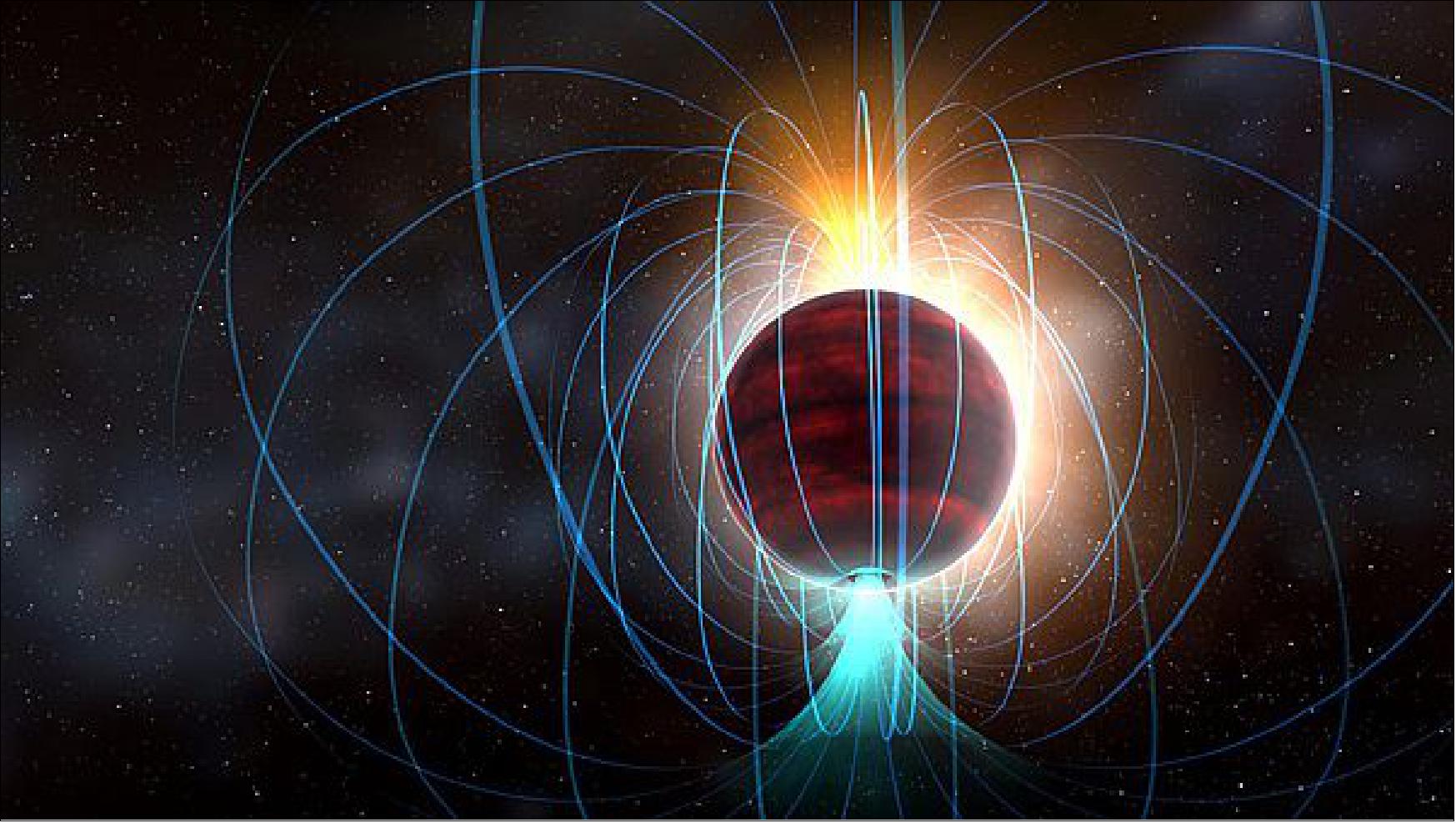
• April 16, 2015: ALMA has revealed an extremely powerful magnetic field, beyond anything previously detected in the core of a galaxy, very close to the event horizon of a supermassive black hole (Figure 58). This new observation helps astronomers to understand the structure and formation of these massive inhabitants of the centers of galaxies, and the twin high-speed jets of plasma they frequently eject from their poles. The results appear in the 17 April 2015 issue of the journal Science. 73)
- Supermassive black holes, often with masses billions of times that of the Sun, are located at the heart of almost all galaxies in the Universe. These black holes can accrete huge amounts of matter in the form of a surrounding disc. While most of this matter is fed into the black hole, some can escape moments before capture and be flung out into space at close to the speed of light as part of a jet of plasma. How this happens is not well understood, although it is thought that strong magnetic fields, acting very close to the event horizon, play a crucial part in this process, helping the matter to escape from the gaping jaws of darkness.
- Up to now only weak magnetic fields far from black holes — several light-years away — had been probed. In this study, however, astronomers from Chalmers University of Technology and Onsala Space Observatory in Sweden have now used ALMA to detect signals directly related to a strong magnetic field very close to the event horizon of the supermassive black hole in a distant galaxy named PKS 1830-211. This magnetic field is located precisely at the place where matter is suddenly boosted away from the black hole in the form of a jet.
- The team measured the strength of the magnetic field by studying the way in which light was polarized, as it moved away from the black hole. "Polarization is an important property of light and is much used in daily life, for example in sun glasses or 3D glasses at the cinema," says Ivan Marti-Vidal, lead author of this work. "When produced naturally, polarization can be used to measure magnetic fields, since light changes its polarization when it travels through a magnetized medium. In this case, the light that we detected with ALMA had been travelling through material very close to the black hole, a place full of highly magnetized plasma."
- The astronomers applied a new analysis technique that they had developed to the ALMA data and found that the direction of polarization of the radiation coming from the center of PKS 1830-211 had rotated. These are the shortest wavelengths ever used in this kind of study, which allow the regions very close to the central black hole to be probed.

• Nov. 5, 2014: A new image from ALMA reveals extraordinarily fine detail that has never been seen before in the planet-forming disc around a young star. ALMA's new high-resolution capabilities were achieved by spacing the antennas up to 15 km apart. This new result represents an enormous step forward in the understanding of how protoplanetary discs develop and how planets form. 74)
- ALMA has obtained its most detailed image yet showing the structure of the disc around HL Tau, a million-year-old Sun-like star located approximately 450 light-years from Earth in the constellation of Taurus. The image exceeds all expectations and reveals a series of concentric and bright rings, separated by gaps.
- "These features are almost certainly the result of young planet-like bodies that are being formed in the disc. This is surprising since such young stars are not expected to have large planetary bodies capable of producing the structures we see in this image," said Stuartt Corder, ALMA Deputy Director.
- "When we first saw this image we were astounded at the spectacular level of detail. HL Tauri is no more than a million years old, yet already its disc appears to be full of forming planets. This one image alone will revolutionize theories of planet formation," explained Catherine Vlahakis, ALMA Deputy Program Scientist and Lead Program Scientist for the ALMA Long Baseline Campaign.
- Such a resolution can only be achieved with the long baseline capabilities of ALMA and provides astronomers with new information that is impossible to collect with any other facility, even the Hubble Space Telescope. "The logistics and infrastructure required to place antennas at such distant locations required an unprecedented coordinated effort for the international expert team of engineers and scientists" said ALMA Director, Pierre Cox. "These long baselines fulfill one of ALMA's major objectives and mark an impressive technological, scientific and engineering milestone", celebrated Cox.
- Stars like HL Tau and our own Sun form within clouds of gas and dust that collapse under gravity. Over time, the surrounding dust particles stick together, growing into sand, pebbles, and larger-size rocks, which eventually settle into a thin disc where asteroids, comets, and planets form. Once these planetary bodies acquire enough mass, they dramatically reshape the structure of the disc, fashioning rings and gaps as the planets sweep their orbits clear of debris and shepherd dust and gas into tighter and more confined zones.
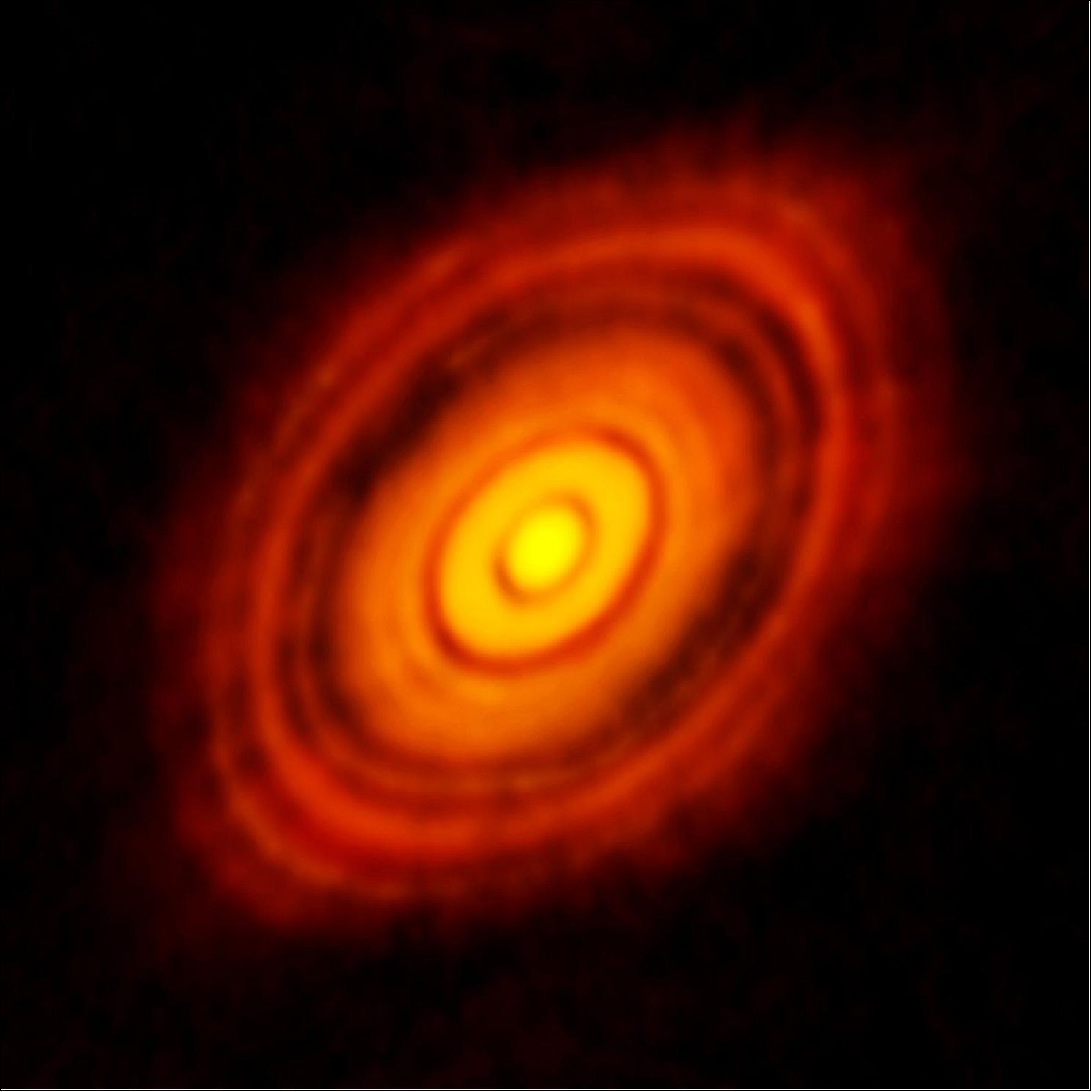
• October 16, 2013: Two international teams of astronomers have used the power of the ALMA to focus on jets from the huge black holes at the centers of galaxies and observe how they affect their surroundings. They have respectively obtained the best view yet of the molecular gas around a nearby, quiet black hole and caught an unexpected glimpse of the base of a powerful jet close to a distant black hole. 75)
- There are supermassive black holes — with masses up to several billion solar masses — at the hearts of almost all galaxies in the Universe, including our own galaxy, the Milky Way. In the remote past, these bizarre objects were very active, swallowing enormous quantities of matter from their surroundings, shining with dazzling brilliance, and expelling tiny fractions of this matter through extremely powerful jets. In the current Universe, most supermassive black holes are much less active than they were in their youth, but the interplay between jets and their surroundings is still shaping galaxy evolution.
- Two new studies, both published on Oct. 16, 2013 in the journal Astronomy & Astrophysics, used ALMA to probe black hole jets at very different scales: a nearby and relatively quiet black hole in the galaxy NGC 1433 (Figure 60) and a very distant and active object called PKS 1830-211 (Figure 61). The discovery of this outflow, which is being dragged along by the jet from the central black hole, shows how such jets can stop star formation and regulate the growth of the central bulges of galaxies.
- "ALMA has revealed a surprising spiral structure in the molecular gas close to the center of NGC 1433," says Françoise Combes (Observatoire de Paris, France), who is the lead author of the first paper. "This explains how the material is flowing in to fuel the black hole. With the sharp new observations from ALMA, we have discovered a jet of material flowing away from the black hole, extending for only 150 light-years. This is the smallest such molecular outflow ever observed in an external galaxy."
- The discovery of this outflow, which is being dragged along by the jet from the central black hole, shows how such jets can stop star formation and regulate the growth of the central bulges of galaxies.
- In PKS 1830-211, Ivan Martí-Vidal (Chalmers University of Technology, Onsala Space Observatory, Onsala, Sweden) and his team also observed a supermassive black hole with a jet, but a much brighter and more active one in the early Universe. It is unusual because its brilliant light passes a massive intervening galaxy on its way to Earth, and is split into two images by gravitational lensing.
- From time to time, supermassive black holes suddenly swallow a huge amount of mass, which increases the power of the jet and boosts the radiation up to the very highest energies. And now ALMA has, by chance, caught one of these events as it happens in PKS 1830-211.
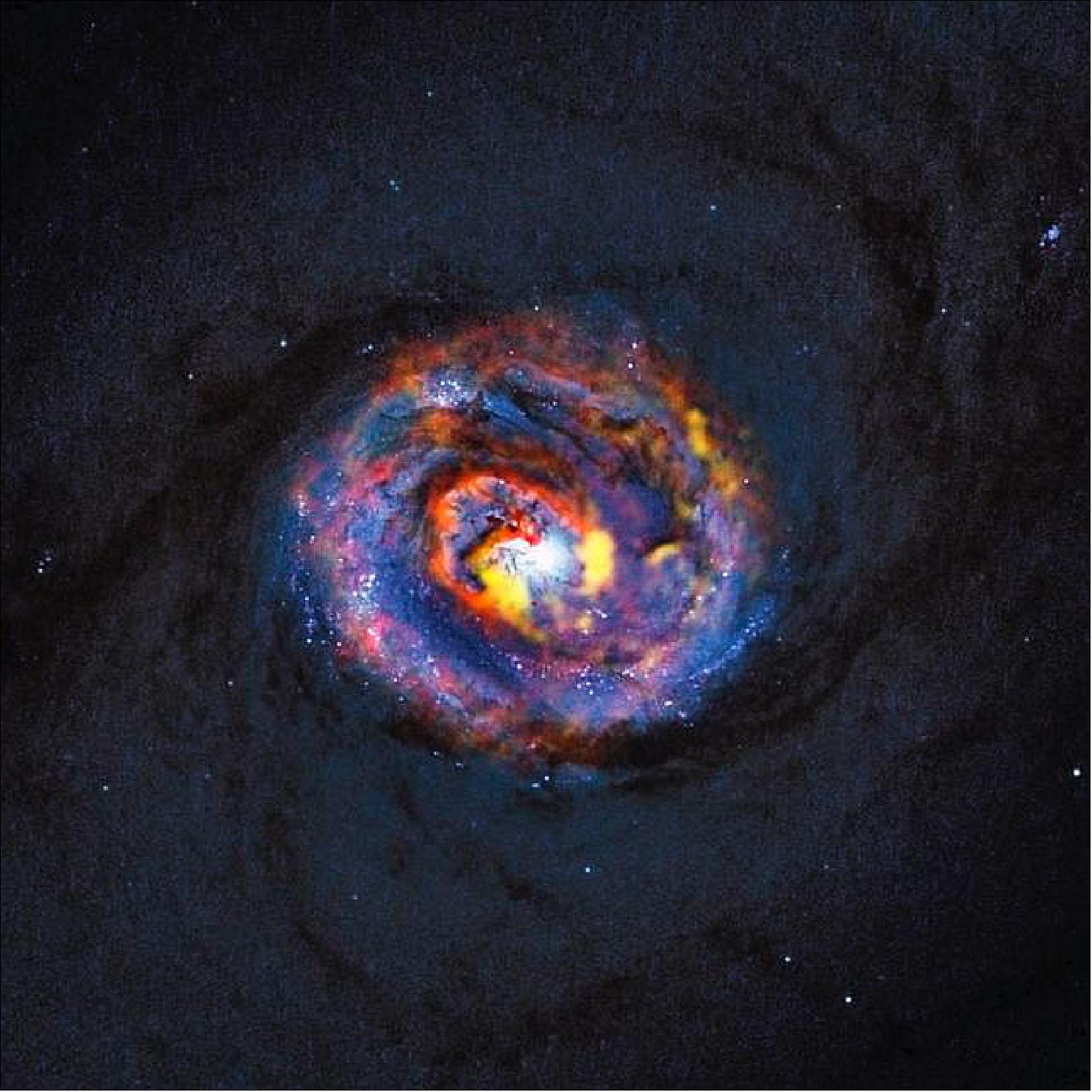
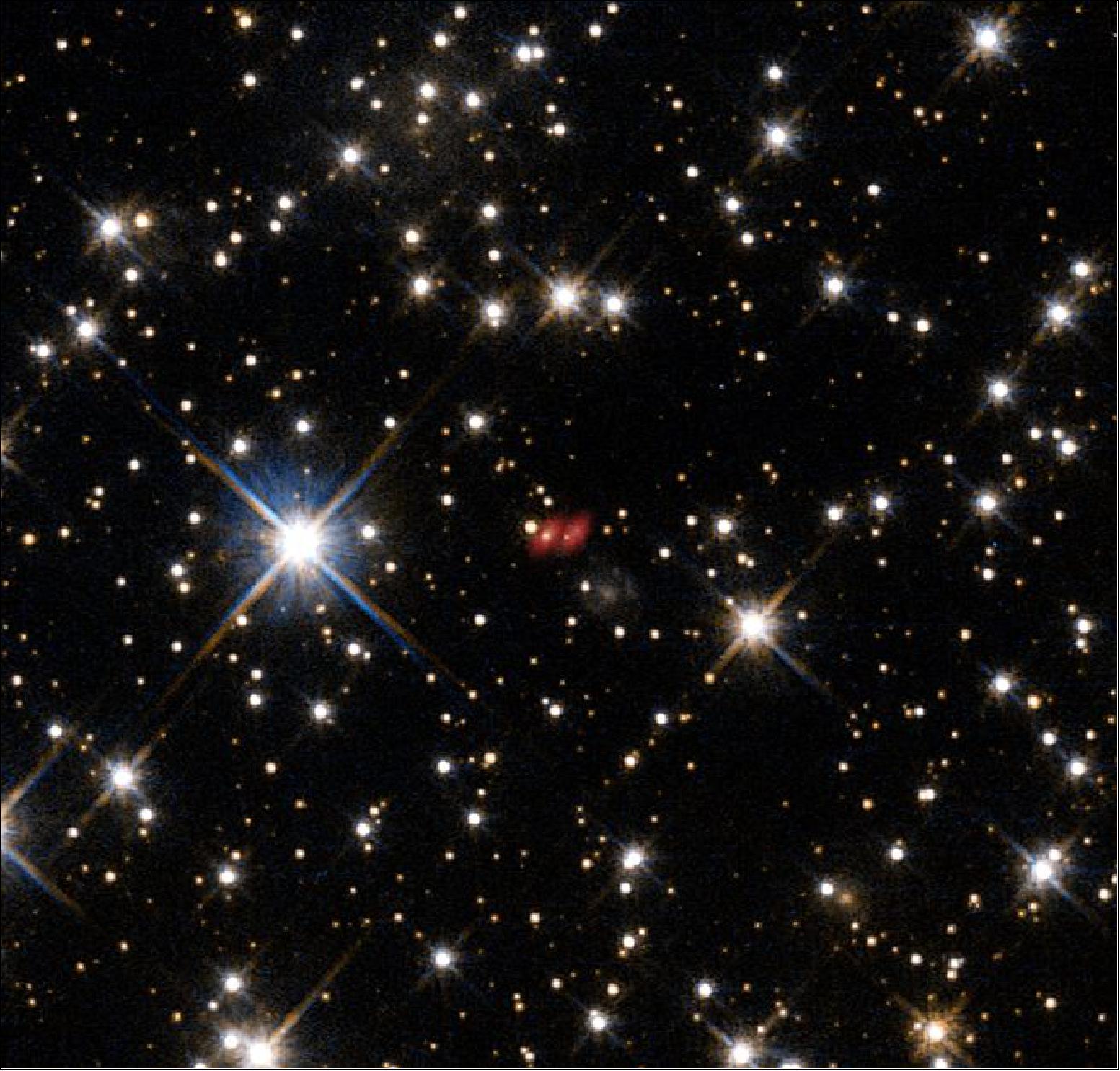
• On Oct. 3, 2011, ALMA opened officially for astronomers. The first released image (Figure 62), from a telescope still under construction, reveals a view of the Universe that cannot be seen at all by visible-light and infrared telescopes. Thousands of scientists from around the world competed to be the first few researchers to explore some of the darkest, coldest, farthest, and most hidden secrets of the Cosmos with this new astronomical tool. 77)
- "We are living in a historic moment for science and particularly for astronomy, and perhaps also for the evolution of humanity, because we start to use the greatest observatory under construction at the moment," said Thijs de Graauw, ALMA Director.
- At present, around a third of ALMA's eventual 66 radio antennas make up the growing array on the Chajnantor plateau in northern Chile. And yet, even under construction, ALMA has become the best telescope of its kind – as reflected by the extraordinary number of astronomers who requested to observe with ALMA.
- ALMA is radically different from visible-light and infrared telescopes. It is an array of linked antennas acting as a single giant telescope, and it detects much longer wavelengths than those of visible light. Its images therefore look quite unlike more familiar pictures of the cosmos.
- The ALMA team has been busy testing the observatory's systems over the past few months, in preparation for the first round of scientific observations, known as Early Science. One outcome of their tests is the first image published from ALMA, albeit from what is still very much a growing telescope. Most of the observations used to create this image of the Antennae Galaxies were made using only twelve antennas working together —fewer than will be used for the first science observations — and with the antennas much closer together as well. Both of these factors make the new image just a taster of what is to come. As the observatory grows, the sharpness, efficiency, and quality of its observations will increase dramatically as more antennas become available and the array grows in size. This is nevertheless the best submillimeter-wavelength image ever taken of the Antennae Galaxies and opens a new window on the submillimeter Universe.
- The Antennae Galaxies (Figure 63, also known as NGC 4038 and 4039) are a pair of distorted colliding spiral galaxies about 70 million light-years away, in the constellation of Corvus (The Crow). This view combines ALMA observations, made in two different wavelength ranges during the observatory's early testing phase, with visible-light observations from the NASA/ESA Hubble Space Telescope.
- The Hubble image is the sharpest view of this object ever taken and serves as the ultimate benchmark in terms of resolution. ALMA observes at much longer wavelengths which makes it much harder to obtain comparably sharp images. However, when the full ALMA array is completed its vision will be up to ten times sharper than Hubble.
![Figure 62: Multiwavelength composite of interacting galaxies NGC 4038/4039, the Antennae Galaxies, showing their namesake tidal tails in radio (blues), past and recent starbirths in optical (whites and pinks), and a selection of current star-forming regions in mm/submm (orange and yellows). Inset: ALMA's first mm/submm test views, in Bands 3 (orange), 6 (amber), & 7 (yellow), showing detail surpassing all other views in these wavelengths [image credit: (NRAO/AUI/NSF); ALMA (ESO/NAOJ/NRAO); HST (NASA, ESA, and B. Whitmore (STScI)); J. Hibbard, (NRAO/AUI/NSF); NOAO/AURA/NSF]](/api/cms/documents/163813/5433030/Alma2018_Auto1.jpeg)
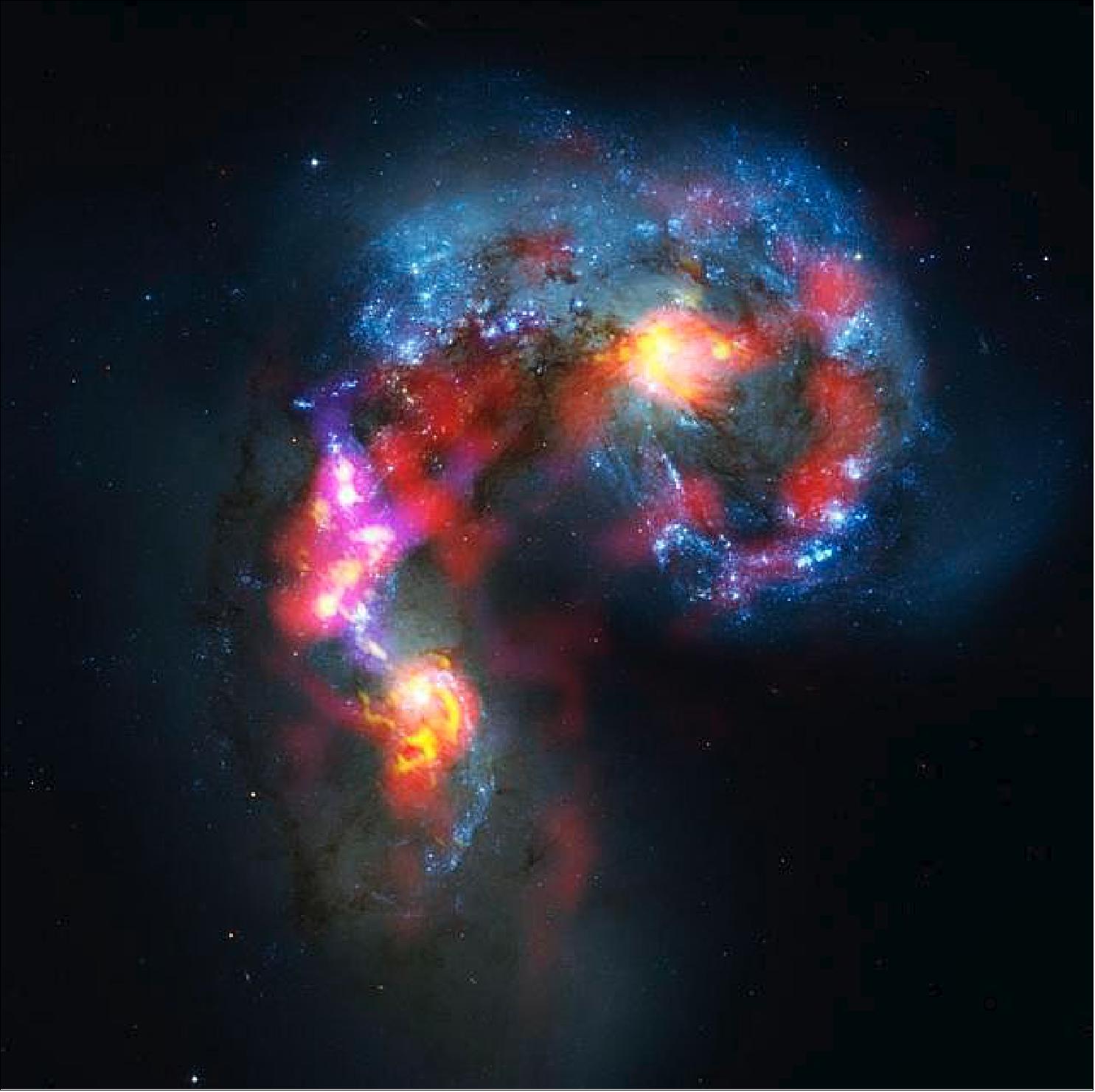
References
1) " ALMA Gives Passing Comet Its Close-up," NRAO (National Radio Astronomy Observatory) News Release, 20 December 2018, URL: https://public.nrao.edu/news/2018-alma-comet/
2) "Mystery of coronae around supermassive black holes deepens," ALMA Observatory, 17 December 2018, URL: https://www.almaobservatory.org/en/press-release
/mystery-of-coronae-around-supermassive-black-holes-deepens/
3) Yoshiyuki Inoue, Akihiro Doi, "Detection of Coronal Magnetic Activity in Nearby Active Supermassive Black Holes," Accepted for publication in Astrophysical Journal, Draft version October 26, 2018, URL: https://arxiv.org/pdf/1810.10732.pdf
4) "The Epoch of Planet Formation, Times Twenty — ALMA Campaign Provides Unprecedented Views of the Birth of Planets," NSF, NRAO, News Release: December 12, 2018, URL:https://public.nrao.edu/news/2018-alma-survey-disks/
5) "Black hole 'donuts' are actually 'fountains'," NAOJ, 30 November 2018, URL: https://www.nao.ac.jp/en/news/science/2018/20181130-alma.html
6) Takuma Izumi, Keiichi Wada, Ryosuke Fukushige, Sota Hamamura, and Kotaro Kohno, "Circumnuclear Multiphase Gas in the Circinus Galaxy. II. The Molecular and Atomic Obscuring Structures Revealed with ALMA," The Astrophysical Journal, Volume 867, Number 1, published 30 October 2018, DOI: https://doi.org/10.3847/1538-4357/aae20b
7) "ALMA's Highest Frequency Receiver produces its First Scientific Result on Massive Star Formation," ALMA, 22 November 2018, URL: https://alma-telescope.jp/en/news/press/band10-201811
8) Brett A. McGuire, Crystal L. Brogan, Todd R. Hunter, Anthony J. Remijan, Geoffrey A. Blake, Andrew M. Burkhardt, P. Brandon Carroll, Ewine F. van Dishoeck, Robin T. Garrod, Harold Linnartz, Christopher N. Shingledecker, and Eric R. Willis, "First Results of an ALMA Band 10 Spectral Line Survey of NGC 6334I: Detections of Glycolaldehyde (HC(O)CH2OH) and a New Compact Bipolar Outflow in HDO and CS," The Astrophysical Journal Letters, Volume 863, Number 2, published 17 August 2018, DOI: https://doi.org/10.3847/2041-8213/aad7bb
9) "Trans-galactic Streamers Feeding Most Luminous Galaxy in the Universe," NARO (National Radio Astronomy Observatory), 15 November 2018, URL: https://public.nrao.edu
/news/2018-alma-luminous-streamers/
10) "The Most Luminous Galaxy Is Eating Its Neighbors," NASA/JPL, 15 November 2018, URL: https://www.jpl.nasa.gov/news/news.php?feature=7282
11) T. Díaz-Santos, R. J. Assef, A. W. Blain, M. Aravena, D. Stern, C.-W. Tsai, P. Eisenhardt, J. Wu, H. D. Jun, K. Dibert, H. Inami, G. Lansbury, F. Leclercq, "The multiple merger assembly of a hyperluminous obscured quasar at redshift 4.6," Science 15 Nov 2018: eaap7605, DOI: 10.1126/science.aap7605
12) "Image Release: ALMA Maps Europa's Temperature," NRAO (National Radio Astronomy Observatory) News Release 23 October 2018, URL: https://public.nrao.edu/news/2018-alma-image-europa/
13) Samantha K. Trumbo, Michael E. Brown, Bryan J. Butler, "ALMA Thermal Observations of Europa," The Astronomical Journal (2018). DOI: 10.3847/1538-3881/aada87, Draft version August 23, 2018, URL: https://arxiv.org/pdf/1808.07111.pdf
14) "When Is a Nova Not a ‘Nova'? When a White Dwarf and a Brown Dwarf Collide," NRAO News Release, 8 October 2018, URL: https://public.nrao.edu/news/2018-alma-dwarf-nova/
15) Stewart Eyres, Aneurin Evans, Albert Zijlstra, Adam Avison, Robert Gehrz, Marcin Hajduk, Sumner Starrfield, Shazrene Mohamed, Charles Woodward, R. Mark Wagner, "ALMA reveals the aftermath of a white dwarf — brown dwarf merger in CK Vulpeculae," Monthly Notices of the Royal Astronomical Society (MNRAS), Printed 18 September 2018, DOI: 10.1093/mnras/sty2554, URL: https://arxiv.org/pdf/1809.05849.pdf
16) "ALMA Provides Detailed View of Very Distant Star-Forming Galaxy," Science News, 30 August 2018, URL: http://www.sci-news.com/astronomy/aztec-cosmos-1-extreme-starburst-galaxy-06356.html
17) K. Tadaki, D. Iono, M. S. Yun, I. Aretxaga, B. Hatsukade, D. H. Hughes, S. Ikarashi, T. Izumi, R. Kawabe, K. Kohno, M. Lee, Y. Matsuda, K. Nakanishi, T. Saito, Y. Tamura, J. Ueda, H. Umehata, G. W. Wilson, T. Michiyama, M. Ando & P. Kamieneski, "The gravitationally unstable gas disk of a starburst galaxy 12 billion years ago," Nature, Vol. 560, pp: 613-616, published: 29August 2018, https://www.nature.com/articles/s41586-018-0443-1
18) "Stellar Corpse Reveals Origin of Radioactive Molecules —Observations using ALMA find radioactive isotope aluminium-26 from the remnant CK Vulpeculae," eso1826 — Science Release, 30 July 2018, URL: http://www.eso.org/public/news/eso1826/
19) Tomasz Kamiński, Romuald Tylenda, Karl M. Menten, Amanda Karakas, Jan Martin Winters, Alexander A. Breier, Ka Tat Wong, Thomas F. Giesen, Nimesh A. Patel, "Astronomical detection of a radioactive molecule 26AlF in a remnant of an ancient explosion," Nature Astronomy, July 30, 2018, URL: http://www.eso.org/public/archives/releases/sciencepapers/eso1826/eso1826a.pdf
20) "ALMA Discovers Trio of Infant Planets around Newborn Star," ESO 1818 Science Release, 13 June 2018, URL: http://www.eso.org/public/news/eso1818/
21) "ALMA and VLT Find Evidence for Stars Forming Just 250 Million Years After Big Bang," ESO 1815 Science Release, 16 May 2018, URL: https://www.eso.org/public/news/eso1815/
22) Takuya Hashimoto, Nicolas Laporte, Ken Mawatari, Richard S. Ellis, Akio K. Inoue, Erik Zackrisson, Guido Roberts-Borsani, Wei Zheng, Yoichi Tamura, Franz E. Bauer, Thomas Fletcher, Yuichi Harikane, Bunyo Hatsukade, Natsuki H. Hayatsu, Yuichi Matsuda, Hiroshi Matsuo, Takashi Okamoto, Masami Ouchi, Roser Pelló, Claes-Erik Rydberg, Ikkoh Shimizu, Yoshiaki Taniguchi, Hideki Umehata, Naoki Yoshida, "The onset of star formation 250 million years after the Big Bang," Nature, Vol. 557, pp: 392-395, Published: 16 May 2018, doi:10.1038/s41586-018-0117-z, URL: http://www.eso.org/public/archives/releases/sciencepapers/eso1815/eso1815a.pdf
23) "Ancient Galaxy Megamergers — ALMA and APEX discover massive conglomerations of forming galaxies in early Universe," ESO 1812 Science Release, 25 April 2018, URL: https://www.eso.org/public/news/eso1812/
24) "ALMA Reveals Inner Web of Stellar Nursery," ESO Photo Release 1809, 7 March 2018, URL: http://www.eso.org/public/news/eso1809/?lang
25) "Powerful Flare from Star Proxima Centauri Detected with ALMA," NRAO (National Radio Astronomy Observatory), an NSF facility in Charlottesville, VA, 26 Feb. 2018, URL: https://public.nrao.edu
/news/2018-alma-flare-proxima/
26) Meredith A. MacGregor, Alycia J. Weinberger, David J. Wilner, Adam F. Kowalski, Steven R. Cranmer, "Detection of a Millimeter Flare from Proxima Centauri," The Astrophysical Journal Letters, Volume 855, Number 1, Published 26 Feb. 2018, URL of abstract: http://iopscience.iop.org
/article/10.3847/2041-8213/aaad6b/meta
27) "Rotating Dusty Gaseous Donut around an Active Supermassive Black Hole," ALMA Press Release, 14 Feb. 2018, URL: https://alma-telescope.jp/en/news/press/m77-201802
28) Masatoshi Imanishi , Kouichiro Nakanishi , Takuma Izumi , Keiichi Wada, "ALMA Reveals an Inhomogeneous Compact Rotating Dense Molecular Torus at the NGC 1068 Nucleus," The Astrophysical Journal Letters, Volume 853, Number 2, Published 30 January 2018, DOI: 10.3847/2041-8213/aaa8df
29) "ALMA Discovers Cold Dust Around Nearest Star," ESO, 3 Nov. 2017, URL: https://www.eso.org/public/news/eso1735/
30) Guillem Anglada, Pedro J. Amado, Jose L. Ortiz, José F. Gómez, Enrique Macías, Antxon Alberdi, Mayra Osorio, José L. Gómez, Itziar de Gregorio-Monsalvo, Miguel A. Pérez-Torres, Guillem Anglada-Escudé, Zaira M. Berdiñas, James S. Jenkins, Izaskun Jimenez-Serra, Luisa M. Lara, Maria J. López-González, Manuel López-Puertas, Nicolas Morales, Ignasi Ribas, Anita M. S. Richards, Cristina Rodríguez-López, Eloy Rodriguez, "ALMA Discovery of Dust Belts around Proxima Centauri," The Astrophysical Journal Letters, Volume 850, Number 1, Nov. 2017, DOI: 10.3847/2041-8213/aa978b, URL: https://arxiv.org/pdf/1711.00578.pdf
31) https://www.eso.org/public/news/eso1735/
32) Note: This protostar is a binary star system surrounded by a molecular cloud in the Rho Ophiuchi star-forming region, which makes it an excellent target for ALMA's millimeter/submillimeter view.
33) "ALMA and Rosetta Detect Freon-40 in Space -Dashing Hopes that Molecule May be Marker of Life," eso1732 — Science Release, 2 October 2017, URL: http://www.eso.org/public/news/eso1732/
34) The data used were from the ALMA Protostellar Interferometric Line Survey (PILS). The aim of this survey is to chart the chemical complexity of IRAS 16293-2422 by imaging the full wavelength range covered by ALMA in the 0.8-millimetre atmospheric window on very small scales, equivalent to the size of the Solar System.
35) Edith C. Fayolle, Karin I. Öberg, Jes K. Jørgensen, Kathrin Altwegg, Hannah Calcutt, Holger S. P. Müller, Martin Rubin, Matthijs H. D. van der Wiel, Per Bjerkeli, Tyler L. Bourke, Audrey Coutens, Ewine F. van Dishoeck, Maria N. Drozdovskaya, Robin T. Garrod, Niels F. W. Ligterink, Magnus V. Persson, Susanne F. Wampfler and the ROSINA team, "Protostellar and Cometary Detections of Organohalogens" Nature Astronomy Vol. 1, pp: 703–708, Published online: 02 October2017, doi:10.1038/s41550-017-0237-7, URL: https://www.nature.com/articles/s41550-017-0237-7.pdf
36) "Betelgeuse captured by ALMA," ESO, June 26, 2017, URL: https://www.eso.org/public/images/potw1726a/
37) E. O'Gorman, P. Kervella, G. M. Harper, A. M. S. Richards, L. Decin6, M. Montargès, I. McDonald, "The inhomogeneous sub-millimeter atmosphere of Betelgeuse," Astronomy & Astrophysics manuscript no. aanda @ESO 2017, June 20, 2017, URL: https://arxiv.org/pdf/1706.06021.pdf
38) "Size comparison: Betelgeuse and the Sun," ESO, 26 June 2017, URL: https://www.eso.org/public/images/potw1726b/
39) "ALMA Eyes Icy Ring around Young Planetary System," ALMA Press Release, May 18, 2017, URL: http://www.almaobservatory.org/en/press-room
/press-releases/1165-alma-eyes-icy-ring-around-young-planetary-system
40) Meredith A. MacGregor, Luca Matra, Paul Kalas, David J. Wilner, Margaret Pan, Grant M. Kennedy, Mark C. Wyatt, Gaspard Duchene, A. Meredith Hughes, George H. Rieke, Mark Clampin, Michael P. Fitzgerald, James R. Graham, Wayne S. Holland, Olja Panic, Andrew Shannon, Kate Su, "A Complete ALMA Map of the Fomalhaut Debris Disk," The Astrophysical Journal, May 16, 2017, URL: https://arxiv.org/pdf/1705.05867.pdf
41) L. Matrà, M. A. MacGregor, P. Kalas, M. C. Wyatt, G. M. Kennedy, D. J. Wilner, G. Duchene, A. M. Hughes, M. Pan, A. Shannon, M. Clampin, M. P. Fitzgerald, J. R. Graham, W. S. Holland, O. Panić, K. Y. L. Su, "Detection of exocometary CO within the 440 Myr-old Fomalhaut belt: a similar CO+CO2 ice abundance in exocomets and Solar System comets,"The Astrophysical Journal, May 16, 2017, URL: https://arxiv.org/pdf/1705.05868.pdf
42) "ALMA Investigates ‘DeeDee,' a Distant, Dim Member of Our Solar System," ALMANRAO News Release, April 12, 2017, URL: https://public.nrao.edu/news/2017-alma-investigates-deedee/
43) "ALMA investigates 'DeeDee,' a distant, dim member of our solar system," Space Daily, April 13, 2017, URL: http://www.spacedaily.com/reports
/ALMA_investigates_DeeDee_a_distant_dim_member_of_our_solar_system_999.html
44) David Gerdes, Masao Sako, Stephanie Hamilton, Ke Zhang, Tali Khain, Juliette Becker, James Annis, William Wester, Gary Bernstein, Colin Scheibner, Lynus Zullo, Fred Adams, Edwin Bergin, Alistair Walker, J.H. Mueller, T. Abbott, Filipe Abdalla, Sahar Allam, K. Bechtol, Aurelien Benoit-Lévy, Emmanuel Bertin, David Brooks, David Burke, A. Rosell, M. Kind, Jorge Carretero, Carlos Cunha, Luiz da Costa, S. Desai, H. Thomas Diehl, Tim Eifler, Brenna Flaugher, Joshua Frieman, J. Garc'ia-Bellido, Enrique Gaztanaga, Daniel Goldstein, Daniel Gruen, J. Gschwend, Gaston Gutierrez, Klaus Honscheid, D. James, Stephen M. Kent, E. Krause, Kyler Kuehn, Nikolay Kuropatkin, O. Lahav, T. Li, M. Maia, Marisa Cristina March, Jennifer Marshall, P. Martini, Felipe Menanteau, Ramon Miquel, Robert Nichol, Andres Plazas Malagón, A. Kathy Romer, Aaron Roodman, Eusebio Sanchez, Ignacio Sevilla-Noarbe, Mathew Smith, R. Smith, Marcelle Soares-Santos, Flavia Sobreira, E. Suchyta, M. Swanson, Gregory Tarle, Douglas Tucker, Y. Zhang, "Discovery and Physical Characterization of a Large Scattered Disk Object at 92 AU," Astrophysical Journal Letters, Vol. 839, No 1, L15 DOI: 10.3847/2041-8213/aa64d8, Draft version March 7, 2017, URL: https://arxiv.org/pdf/1702.00731.pdf
45) "Ancient Stardust Sheds Light on the First Stars, Most distant object ever observed by ALMA," ESO 1708 Science Release, March 8, 2017, URL: https://www.eso.org/public/news/eso1708/?lang
46) N. Laporte, R. S. Ellis, F. Boone, F. E. Bauer, D. Quenard, G. Roberts-Borsani, R. Pello, I. Perez-Fournon, A. Streblyanska, "Dust In The Reionization Era: Alma Observations of a Z =8.38 Gravitationally Lensed Galaxy," Astrophysical Journal Letters, Draft version March 5, 2017, URL: http://www.eso.org/public/archives/releases/sciencepapers/eso1708/eso1708a.pdf
47) "Black-Hole-Powered Jets Forge Fuel for Star Formation," NRAO (National Radio Astronomy Observatory), 14 Feb. 2017, URL: https://public.nrao.edu/news/pressreleases/2017-alma-phoenix
48) H. R. Russell, M. McDonald, B. R. McNamara, A. C. Fabian, P. E. J. Nulsen, M. B. Bayliss, B. A. Benson, M. Brodwin, J. E. Carlstrom, A. C. Edge, J. Hlavacek-Larrondo, D. P. Marrone, C. L. Reichardt, J. D. Vieira, "Alma Observations of Massive Molecular Gas Filaments Encasing Radio Bubbles in the Phoenix Cluster," The Astrophysical Journal, Volume 836, No 1, published Feb. 14, 2017, URL of abstract: http://iopscience.iop.org/article/10.3847/1538-4357/836/1/130
49) "ALMA Starts Observing the Sun," ESA1703 Photo Release, Jan. 17, 2017, URL: http://www.eso.org/public/news/eso1703/#1
50) http://www.almaobservatory.org/en/press-room/press-releases/1100-alma-starts-observing-the-sun
51) "ALMA Finds Compelling Evidence for Pair of Infant Planets around Young Star," NRAO (National Radio Astronomy Observatory), Dec. 12, 2016, URL: https://public.nrao.edu
/news/pressreleases/2016-alma-planets-disk
52) Andrea Isella, Greta Guidi, Leonardo Testi, Shangfei Liu, Hui Li, Shengtai Li, Erik Weaver, Yann Boehler, John M. Carperter, Itziar De Gregorio-Monsalvo, Carlo F. Manara, Antonella Natta, Laura M. Pérez, Luca Ricci, Anneila Sargent, Marco Tazzari, Neal Turner, "Ringed Structures of the HD 163296 Protoplanetary Disk Revealed by ALMA," Physical Review Letters, Vol. 117, Issue 25-16, 221101, 12 December 2016, DOI:https://doi.org/10.1103/PhysRevLett.117.251101
53) "Discovery of an Extragalactic Hot Molecular Core," Tohoku University, Oct. 4, 2016, URL: http://www.tohoku.ac.jp/en/press/discovery_of_extragalactic_hot_molecular_core.html
54) Takashi Shimonishi, Takashi Onaka, Akiko Kawamura, Yuri Aikawa, "The detection of a hot molecular core in the Large Magellanic Cloud with ALMA," The Astrophysical Journal, Volume 827, Number 1, August 9, 2016, DOI: http://dx.doi.org/10.3847/0004-637X/827/1/72, URL of abstract: http://iopscience.iop.org/article/10.3847/0004-637X/827/1/72
/meta;jsessionid=F2E50036D6050DAE8A09B11C7EFED3D6.c3.iopscience.cld.iop.org
55) "ALMA Explores the Hubble Ultra Deep Field — Deepest ever millimeter observations of early Universe," ESO 1633 Science Release, Sept. 22,2016, URL: https://www.eso.org/public/news/eso1633/
56) In this context "high mass" means galaxies with stellar masses greater than 20 billion times that of the Sun ( 2 x 1010 solar masses). For comparison, the Milky Way is a large galaxy and has a mass of around 100 billion solar masses.
57) This region of sky is about seven hundred times smaller than the area of the disc of the full Moon as seen from Earth. One of the most startling aspects of the HUDF was the vast number of galaxies found in such a tiny fraction of the sky.
58) ALMA's ability to see a completely different portion of the electromagnetic spectrum from Hubble allows astronomers to study a different class of astronomical objects, such as massive star-forming clouds, as well as objects that are otherwise too faint to observe in visible light, but visible at millimeter wavelengths.
59) "Alma finds a swirling, cool jet that reveals a growing, supermassive black hole," Chalmers University, July 4, 2016, URL: http://www.chalmers.se/en/centres/oso
/news/Pages/Alma-swirling-cool-jet-supermassive-black-hole.aspx
60) S. Aalto, F. Costagliola, S. Muller, K. Sakamoto, J. S. Gallagher, K. Dasyra, K. Wada, F. Combes, S. García-Burillo, L. E. Kristensen, S. Martín, P. van der Werf, A. S. Evans, J. Kotilainen, "A precessing molecular jet signaling an obscured, growing supermassive black hole in NGC 1377?," Astronomy & Astrophysics, Volume 590, June 2016, URL of abstract: http://www.aanda.org/articles/aa/abs/2016/06/aa27664-15/aa27664-15.html
61) "ALMA Observes Most Distant Oxygen Ever," ALMA, June 16, 2016, URL: http://www.almaobservatory.org/en/press-room
/press-releases/965-alma-observes-most-distant-oxygen-ever
62) Akio K. Inoue, Yoichi Tamura, Hiroshi Matsuo, Ken Mawatari, Ikkoh Shimizu, Takatoshi Shibuya, Kazuaki Ota, Naoki Yoshida, Erik Zackrisson, Nobunari Kashikawa, Kotaro Kohno, Hideki Umehata, Bunyo Hatsukade, Masanori Iye, Yuichi Matsuda, Takashi Okamoto, Yuki Yamaguchi, "Detection of an oxygen emission line from a high-redshift galaxy in the reionization epoch," Science, June 16, 2016, DOI: 10.1126/science.aaf0714, URL: https://arxiv.org/pdf/1606.04989v1.pdf
63) "Dwarf Dark Galaxy Hidden in ALMA Gravitational Lens Image," NRAO (National Radio Astronomy Observatory), April 14, 2016, URL: https://public.nrao.edu/news/pressreleases/2016-sdp81-halo
64) Yashar D. Hezaveh, Neal Dalal, Daniel P. Marrone, Yao-Yuan Mao, Warren Morningstar, Di Wen, Roger D. Blandford, John E. Carlstrom, Christopher D. Fassnacht, Gilbert P. Holder, Athol Kemball, Philip J. Marshall, Norman Murray, Laurence Perreault Levasseur, Joaquin D. Vieira, Risa H. Wechsler, "Detection of lensing substructure using ALMA observations of the dusty galaxy SDP.81," Astrophysical Journal, Preprint: http://arxiv.org/abs/1601.01388, Draft Version, January 8, 2016, URL: http://arxiv.org/pdf/1601.01388v1.pdf
65) "ALMA's Most Detailed Image of a Protoplanetary Disk — Evidence for planet formation in Earth-like orbit around young star," ESO, Release No eso1611, March 31, 2016, URL: https://www.eso.org/public/news/eso1611/
66) Sean M. Andrews, David J. Wilner, Zhaohuan Zhu, Tilman Birnstiel, John M. Carpenter, Laura M. Pérez, Xue-Ning Bai, Karin I. Öberg, A. Meredith Hughes, Andrea Isella, Luca Ricci, "Ringed substructure and a gap at 1 au in the nearest Protoplanetary Disk," The Astrophysical Journal Letters, Vol. 820, No 2, March 31, 2016, URL of abstract: http://iopscience.iop.org/article/10.3847/2041-8205/820/2/L40
67) "ALMA Captures Detailed Images of Planet-Forming Disk around Sun-Like Star TW Hydra," April 1, 2016, URL: http://www.sci-news.com/astronomy/alma-planet-forming-disk-twhydrae-03748.html
68) "ALMA Reveals Planetary Construction Sites - New evidence for young planets in discs around young stars, " ESO 1549 Science Release, Dec. 16, 2015, URL: https://www.eso.org/public/news/eso1549/
69) N. van der Marel, E. F. van Dishoeck, S. Bruderer, S. M. Andrews, K. M. Pontoppidan, G. J. Herczeg, T. van Kempen, A. Miotello, "Resolved gas cavities in transitional disks inferred from CO isotopologues with ALMA," Astronomy & Astrophysics, December 2015, Manuscript paper, URL: http://www.eso.org/public/archives/releases/sciencepapers/eso1549/eso1549a.pdf
70) "XXL Hunt for Galaxy Clusters - Observations from ESO telescopes provide crucial third dimension in probe of Universe's dark side," ESO 1548 Science Release, Dec. 15, 2015: URL: https://www.eso.org/public/news/eso1548/
71) "X-ray image of the XXL-South Field," ESO 1548 Science Release, Dec. 15, 2015: URL: https://www.eso.org/public/images/eso1548a/
72) "Cool, Dim Dwarf Star is Magnetic Powerhouse," ALMA Press Release, Nov. 19, 2015, URL: http://www.almaobservatory.org/en/press-room
/press-releases/903-cool-dim-dwarf-star-is-magnetic-powerhouse
73) "ALMA Reveals Intense Magnetic Field Close to Supermassive Black Hole," ALMA Press Release, April 16, 2015, URL: http://www.almaobservatory.org/en/press-room
/press-releases/826-alma-reveals-intense-magnetic-field-close-to-supermassive-black-hole
74) "Revolutionary ALMA Image Reveals Planetary Genesis," ALMA, Nov. 5, 2014, URL: http://www.almaobservatory.org/press-room
/press-releases/771-revolutionary-alma-image-reveals-planetary-genesis
75) "ALMA Probes Mysteries of Jets from Giant Black Holes," ALMA Press Release, Oct. 16, 2013, URL: http://www.almaobservatory.org/en/press-room
/press-releases/644-alma-probes-mysteries-of-jets-from-giant-black-holes
76) "The distant active galaxy PKS 1830-211 from Hubble and ALMA," ALMA, URL: http://www.almaobservatory.org/en/visuals/images/main.php?g2_itemId=5640
77) "ALMA Opens Its Eyes," ALMA, Oct. 3, 2011, URL: http://www.almaobservatory.org
/en/press-room/press-releases/297-alma-open-its-eyes
The information compiled and edited in this article was provided by Herbert J. Kramer from his documentation of: "Observation of the Earth and Its Environment: Survey of Missions and Sensors" (Springer Verlag) as well as many other sources after the publication of the 4th edition in 2002. - Comments and corrections to this article are always welcome for further updates (eoportal@symbios.space).